The airport at Port Stanley on the Falkland Islands played an important role in life on the Falkland Islands, before, during and after the 1982 Conflict.
The most significant point in the airports’ history was arguably the Black Buck raids.
The 1982 Black Buck raids were a series of seven long-range bombing missions conducted by the Royal Air Force (RAF) during the Falklands War. These missions were aimed at attacking Port Stanley airport in the Falkland Islands, which was under Argentine control at the time.
The raids involved the use of Vulcan bombers, supported by Victor tanker aircraft for in-flight refuelling.
The first raid, known as Black Buck 1, took place on April 30, 1982, with the objective of damaging the runway at Port Stanley to prevent its use by fast jets.
The raids were notable for their complexity and the distance they covered, with the round trip between Ascension Island and the Falklands being almost 13,000 kilometres.
Despite the technical challenges and the operational difficulties encountered, the Black Buck raids are considered a significant achievement in terms of planning and execution.
However, their impact on the outcome of the war is a subject of debate, with some sources highlighting their limited physical impact and questioning their strategic value.
The raids demonstrated the RAF’s capability to conduct long-range bombing missions and showcased the skill and bravery of the pilots and aircrew involved.
However, the effectiveness of the raids in terms of their impact on the conflict remains a point of contention with main claims and counterclaims.
In all the commentary, not much of it looks at the engineering aspects of the runway.
Before the 1982 Conflict
Before the 1982 conflict, aviation on the Falkland Islands was increasingly important to the health, wealth, and well-being of the islanders.
During WWII, many seaplanes visited the islands, this Sunderland for example.
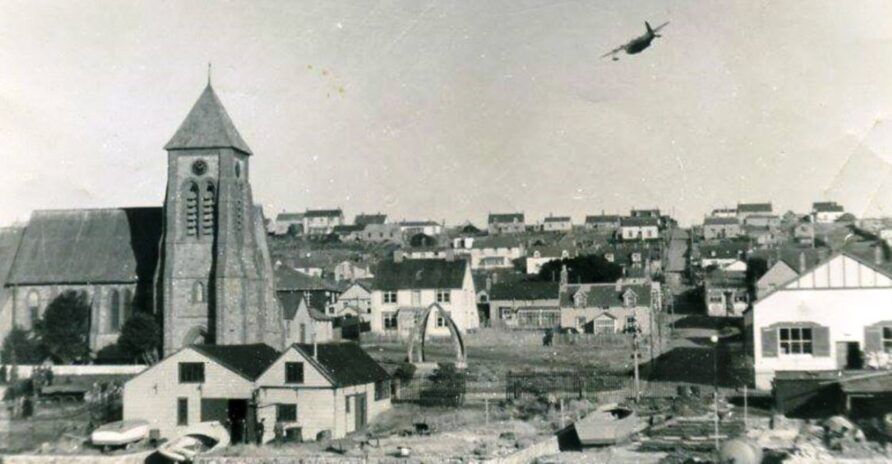
The image below shows a Falkland Islands and Dependencies Aerial Survey Expedition (FIDASE) CANSO flying boat, sometime between 1955 and 1957, on its way to Deception Island.
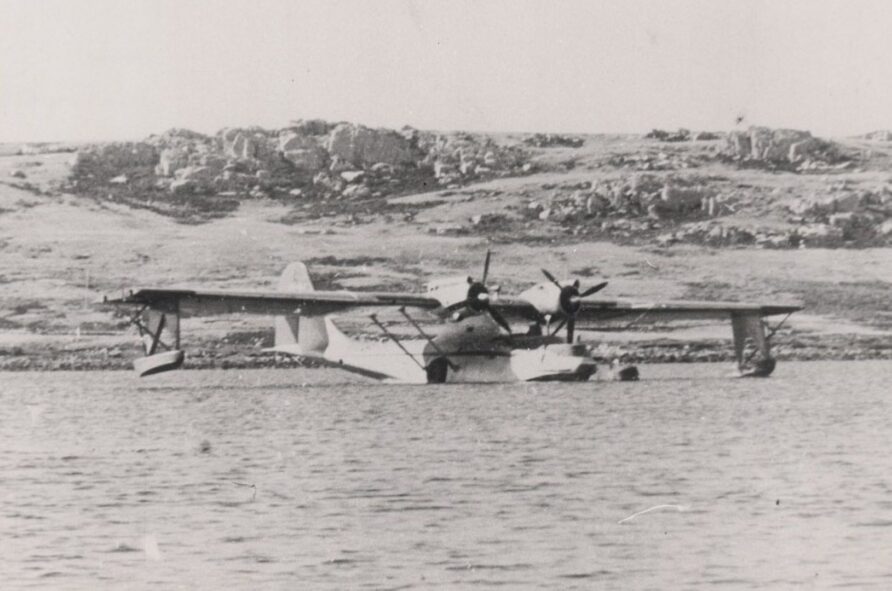
The two PBY-5A CANSO aircraft were provided by the Hunting Aerospace Surveys Ltd company.
In 1944, the new Governor of the Falkland Islands, Miles Clifford, proposed that the Australian Flying Doctor Service would be an ideal model for a new aviation service on the islands, reportedly, after reading about it in a Reader’s Digest on his journey south.
A pair of ex-RAF Taylorcraft Austers were located, purchased for £700 and shipped to the islands on the RRS John Biscoe in 1948.
G-AJCH and G-AJCI became VP-FAA and VP-FAB.
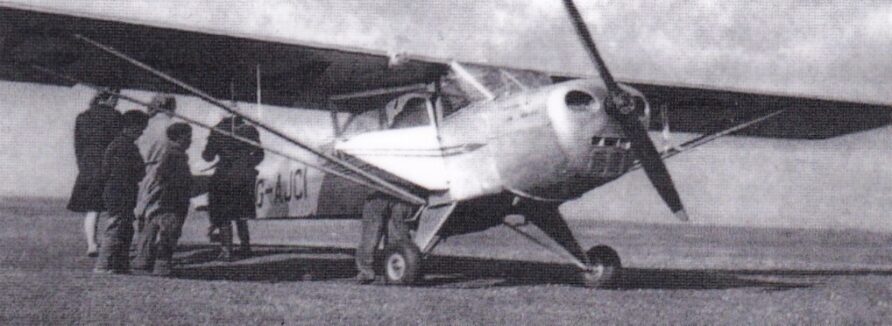
After reassembly at Stanley Racecourse, they were flying by March 1949.
Their first operational use was in transporting a child named Sandra Short with peritonitis from North Arm in East Falkland. The mission was a success, the young patient was saved, on Christmas Day.
Suitable landing strips on the Falkland Islands were uncommon and after a rough landing at San Carlos, one of the Austers was damaged. After repair, it was converted to a float plane.
After the Austers, the Falkland Island Government Aviation Service (FIGAS) made use of a second-hand Canadian Noorduyn Norseman 5 float plane.
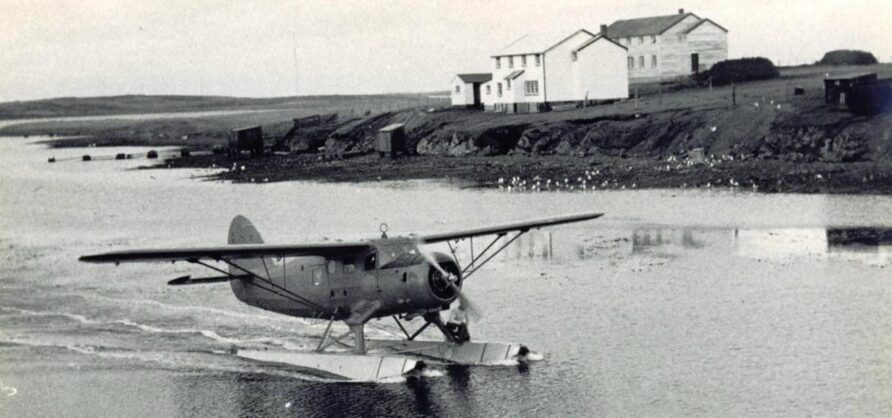
At this point, floatplanes were still the preferred option. When this became unserviceable due to corrosion, it was replaced with a DHC-2 Beaver, operated from 1955 to 1956. After an accident, it was replaced with another Beaver that flew until retirement in 1967.
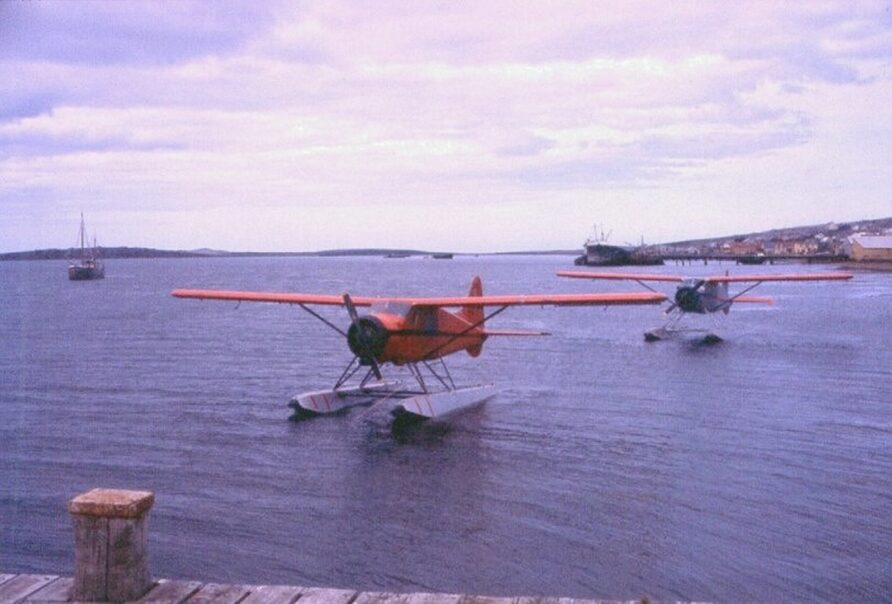
Because most of the settlements were near the sea, the float plane enabled air transportation without creating runways, but in many instances, sea conditions made landing impossible.
The aircraft were hangared near a launch ramp, near Port Stanley. The same hangar would be used to store Argentine war dead in 1982.
The first notable Argentine aviation-related incident came in 1964 when Miguel Fitzgerald flew a Cessna 185 to the Falkland Islands and landed on Stanley Racecourse.
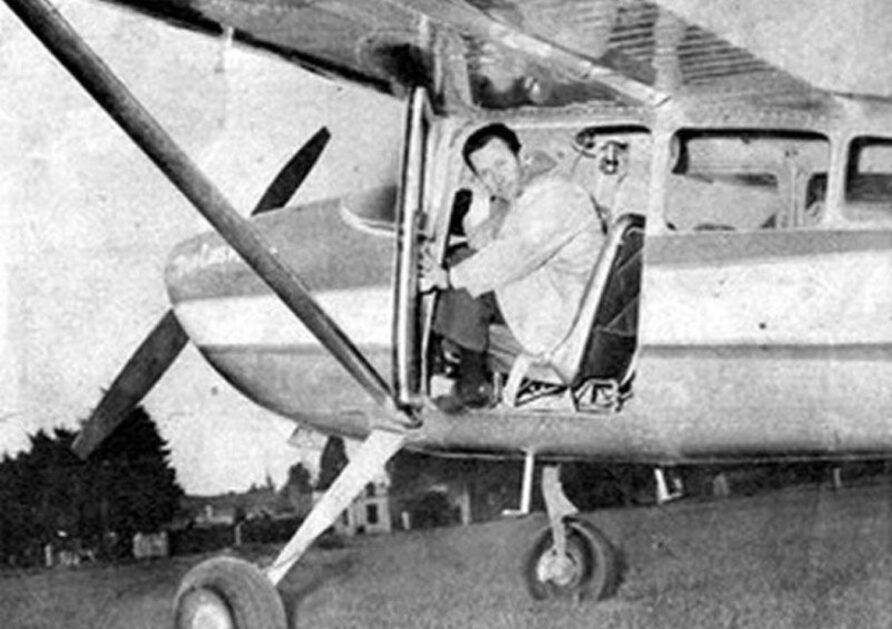
Recounting his flight, Miguel said;
Several times I had to abandon my attempt to fly to the Falklands for various reasons. If I had announced my intention, declaring on the flight plan, I would not have been allowed to leave. The same day I turned thirty-nine years, I kissed my wife and my children walked me to the plane “Cessna 185” whose seats had been replaced by fuel tanks and which had a radio-telephone. With chocolate and coffee supplies, the flight to Rio Gallegos, capital of Santa Cruz province , was completed, followed immediately toward the Malvino archipelago, which is a five hundred and fifty kilometres.
Navigating between clouds, I noticed some clearing that enabled me to fix the status of the islands, orienting between West Falkland and East Falkland when I saw the San Carlos channel. The British flag flew over the governor’s residence, showing the wind direction, which I used to land, after circling. I landed on a horse racing field…
I immediately hoisted the Argentina flag on a pole. Five people came and asked me in English if I wanted or needed anything. Ten minutes later, I got up again to address the flight to Rio Gallegos, my desire fulfilled.
The aircraft is currently in a museum.
Not amused, the Colonial Secretary, Mr WH Thompson, ordered the racecourse be furnished with obstructions for when not in use.
Unfortunately, they were removed sometime later.
Two years later, the racecourse was to see another unwanted aircraft visitor.
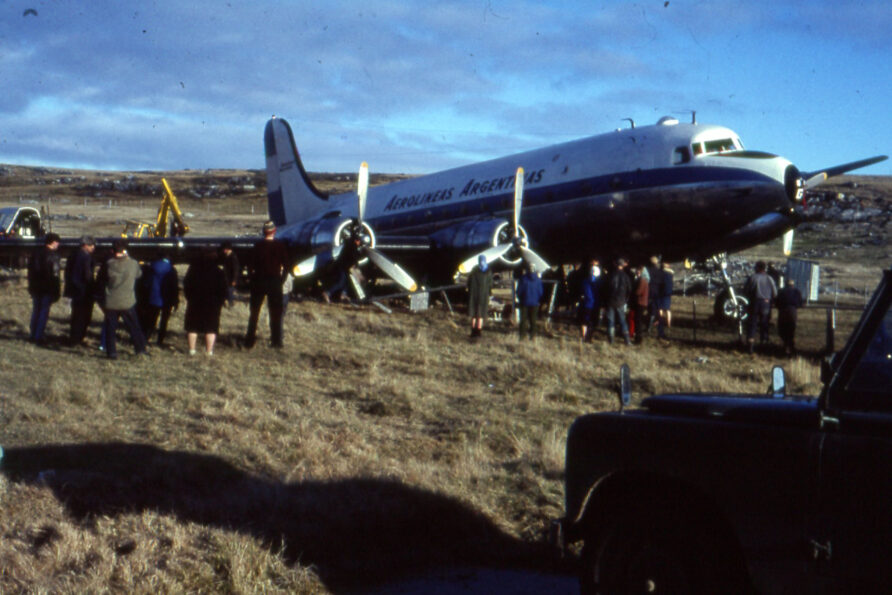
A short time after the World Cup quarter-final defeat of Argentina by the England team, on September 28th, 1966, a group of Argentine radicals (Condor Group) hijacked an Aerolíneas DC4 and forced the pilot to fly to the Falkland Islands.
The group included eighteen members of the metalworkers union and a journalist named Dardo Cabo.
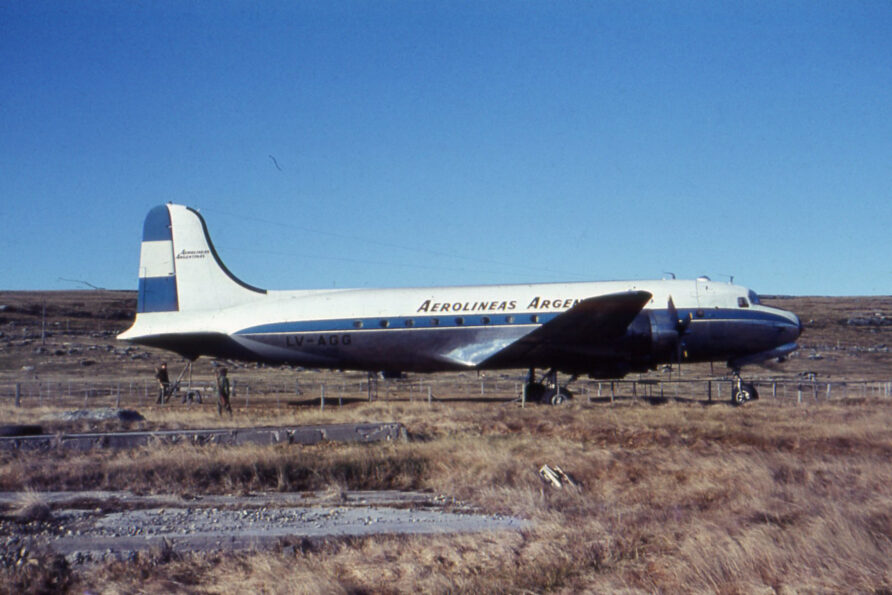
There is some dispute about whether they knew Stanley had no runway or not, but when it arrived, the pilot executed a very skilled landing on the short racecourse.
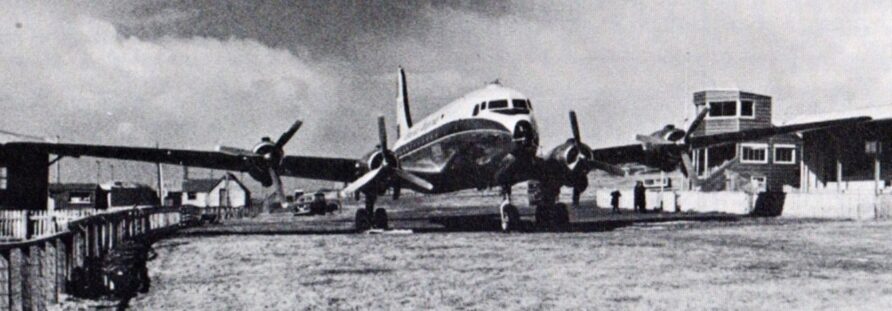
Three Falkland Islanders went to assist but were taken hostage, although, in some accounts, the hostages were Royal Marines.
Soon after, the aircraft was surrounded by a fully armed contingent from the Falkland Islands Defence Force and Royal Marines. Later that day, the hostages were exchanged for the Royal Marines Captain, Ian Martin, and local Police Sergeant, Terry Peck.
Using a familiar tactic, the island’s defenders took to ostentatiously demonstrating the value of copious amounts of warm food and tea, whilst the erstwhile invaders shivered under the wing as the temperature plummeted.
After thirty-six hours, common sense and a helpful intervention from a local Catholic priest named Father Rodolfo Roel ended the stand-off. The aircraft did not have enough fuel for the return leg and was bogged in, but this was soon rectified, and the aircraft was sent on its way, the hijackers repatriated on board the ship Bahía Buen Suceso.
Carbo was arrested when back in Argentina and served three years in prison, eventually executed by the Junta in 1972.
The others served shorter sentences.
The incident resulted in an increase in the size of the Royal Marines contingent on the island, Naval Party 8901.
The final incursion occurred in 1968, Señores Fitzgerald again. This time, he flew a twin-engine Grand Commander, owned by the Daily Chronicle.
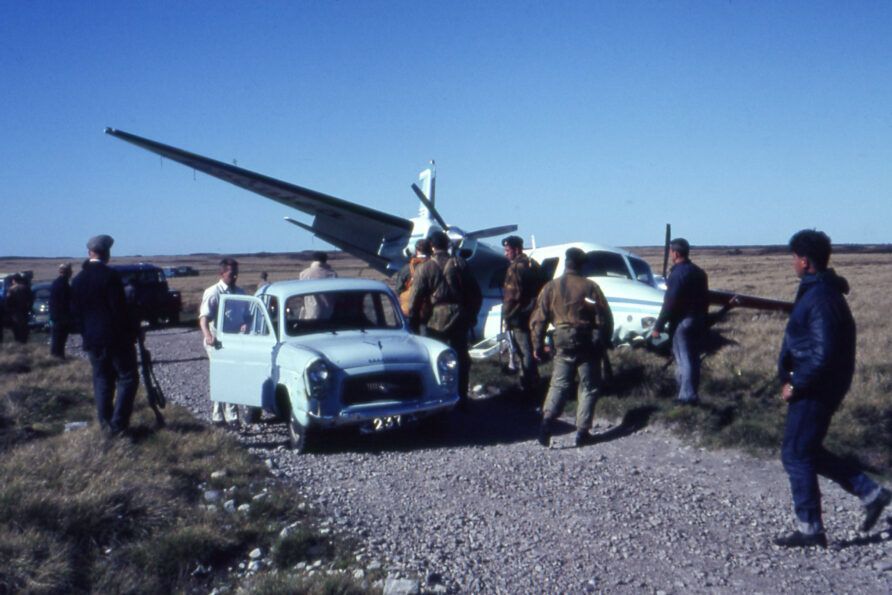
Because the racecourse had been blocked, he was forced to land on Eliza Cove Road, damaging the aircraft in the process.
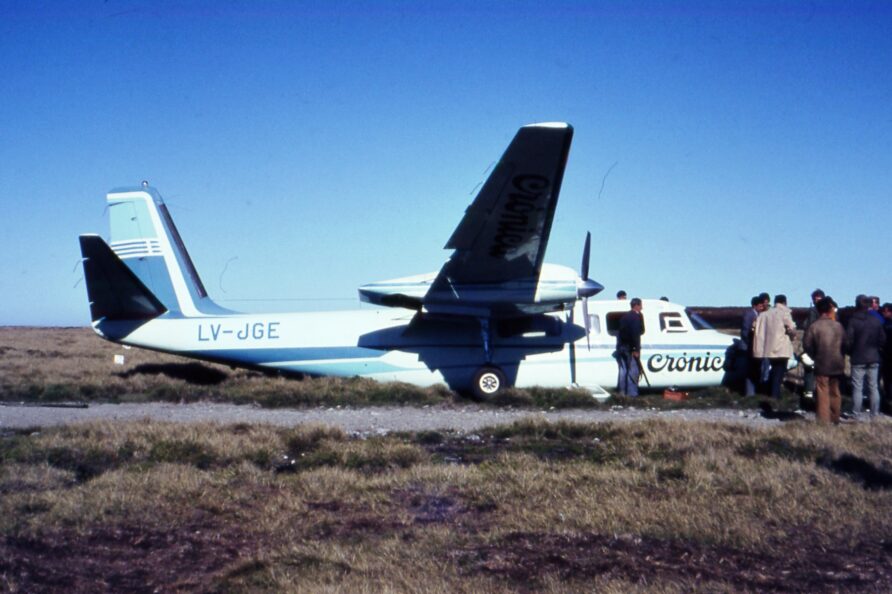
Video
The aircraft and its passengers (after spending 48 hours in a cell) were repatriated to Argentina by HMS Endurance.
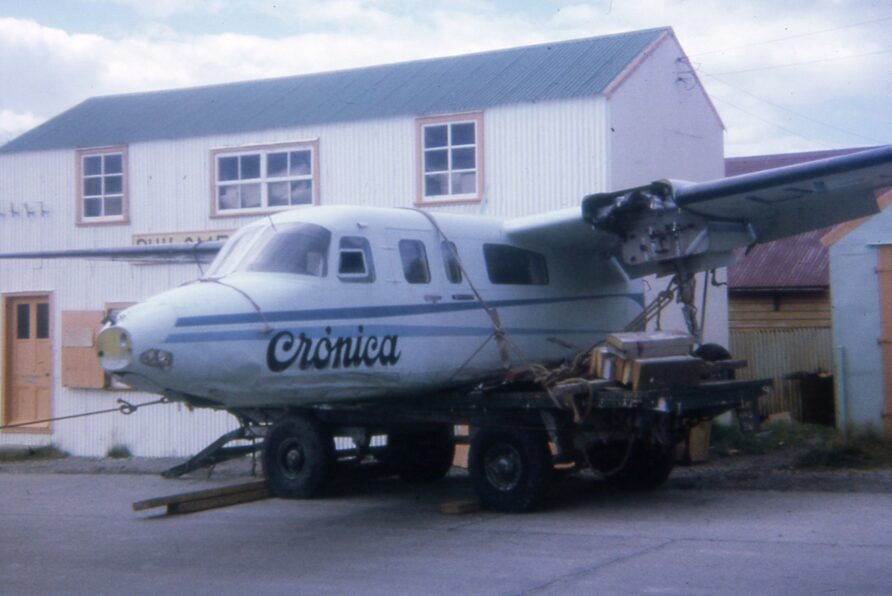
Both countries agreed that part of a normalisation process would require improved transportation links.
Following a few exploratory flights by the FAA, Líneas Aéreas del Estado (LADE), the Argentine military airline, operated a Grumman Albatross amphibian aircraft service to the Falklands using Albatross aircraft from February 15th, 1971, the first flight being a medical evacuation for a critically ill sailor.
The first passenger flight was on July 3rd and on the 15th the ‘Communications Agreement’ was signed to regularise traffic on a two-weekly basis.
This link provides a good account of the 1971 Agreement
The next stage was the construction of a runway.
After the signing of a communications agreement, the UK and Argentina agreed to build a temporary runway to the South of Stanley, at Hookers Point.
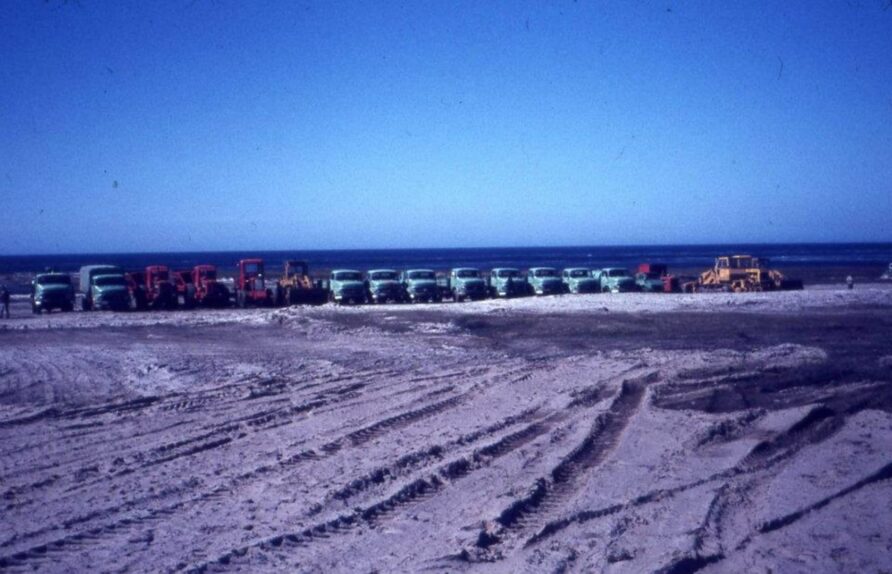
The temporary runway at Hookers Point was constructed by Grupo I de Construcciones de la Fuerza Aérea (FAA) using aluminium matting from the Harvey Aluminium Co in the USA, it was 730m long by 20m wide, extended to 800m at a later point.
A couple of small outbuildings supported basic maintenance and storage. The agreement called for the UK to fund the construction materials (including $1m for the matting) and Argentina to provide labour and plant.
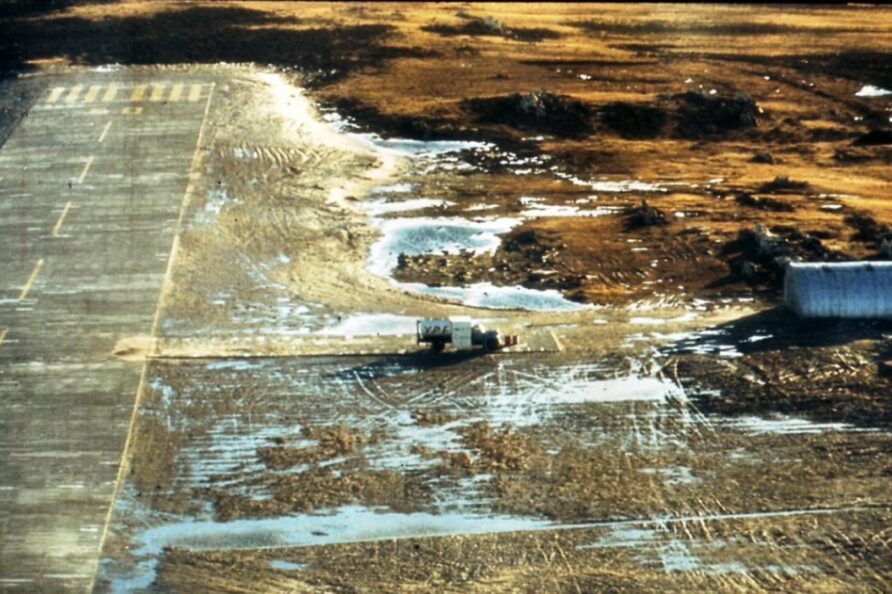
Stanley Airport’s (Hookers Point) first landing took place on the 16th of November 1972, a Fokker F-27.
Video
On the first anniversary of the runway at Hookers Point being operational, a delegation from Argentina landed.
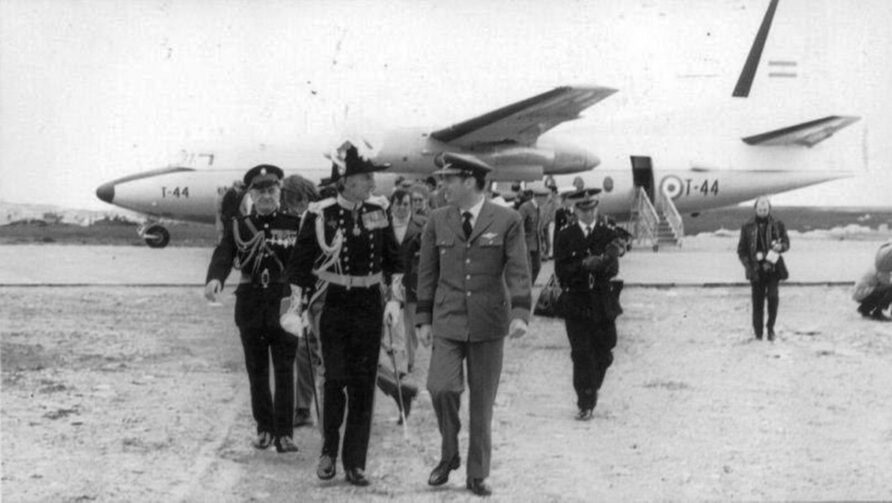
As can be seen in the image above, the Sunday best uniforms were out and in a US Marine Corps Staff Paper titled Offensive Air Operations of the Falklands War, Major Walter F. DeHoust recalls;
The Argentine officials proceeding on the first flight of the air service turned out to be Argentine senior military officers in full uniform. Hearing of this, the Falkland Islands’ governor, Toby Lewis, was ordered to hoist the Union Jack and appear at the ceremony himself in full dress gubernatorial regalia.
The islanders themselves feared that ceremonially clad Argentines represented a covert invasion, perhaps even supported by the British Foreign Office.
The islands’ secretary, John Laing, felt a demonstration was likely and called out the Marine guard, a permanent detachment of military stationed on the Falklands to maintain order
In what will become significant later, the new runway was extended to 800m using additional AM-2 aluminium matting, works completed in October 1976.
The occasional C130, Learjet and FMA IA50 Guaraní flights were made, and the service continued for several uneventful years until transferred to Stanley Airport.
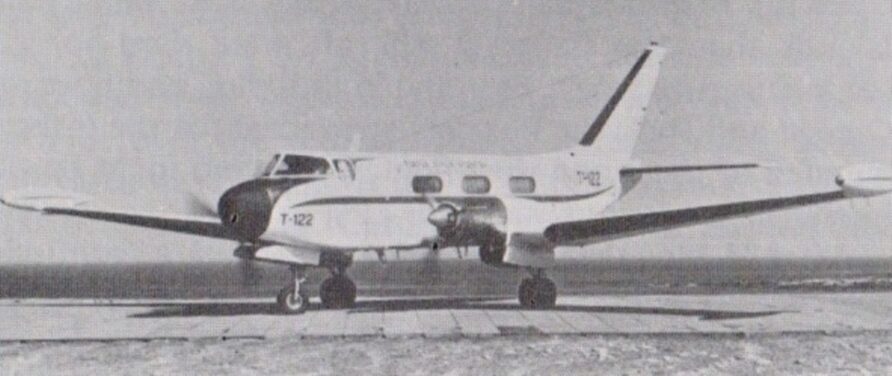
Hookers Point remained operational after Stanley Airport was built for temporary and emergency use until May 1978 when a storm scattered many of the aluminium matting runway panels.
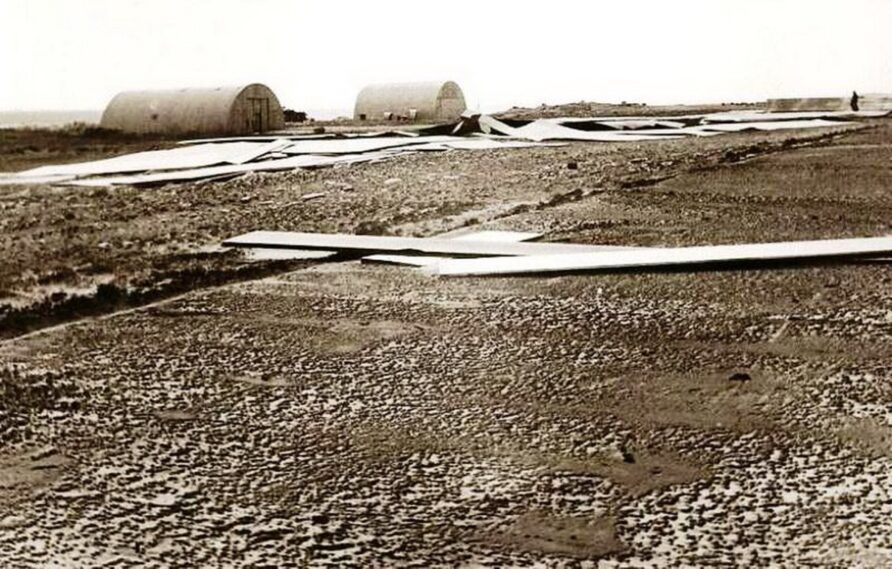
A solution to the problem was already well underway, a permanent runway East of Stanley at Cape Pembroke.
The £4.2 million build contract was awarded to Johnson Construction in 1973 with the first works on drainage commencing in 1974. The runway was to be 1,200m long, 45m wide and constructed to a standard that would allow Fokker F-27 Friendship and Hawker Siddeley HS 748 to land.
It had a minimum Load Classification Number (LCN) of 16 although in places it was as high as 30, 300 mm of compacted crushed stone on white sand with a minimum of 32 mm of asphalt.
A single airport terminal building and parking apron were also built, in addition to a number of smaller storage buildings.
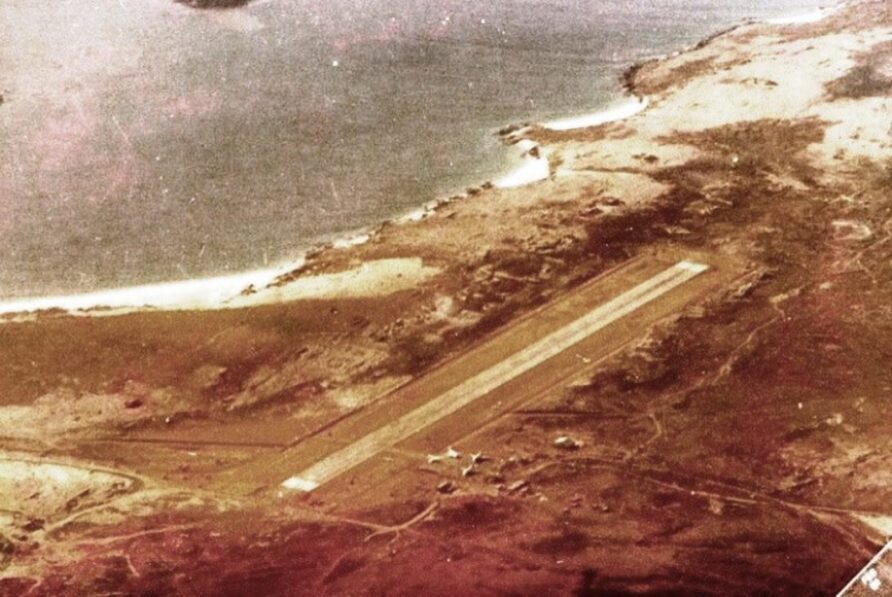
The islanders knew full that by failing to build longer and stronger, they would be dependent upon Argentina, a position no better than the runway at Hookers Point.
An extension was proposed but denied for political reasons, despite it being of modest cost.
Discussions between the Falkland Islands Legislative Council and oil exploration companies commenced in Stanley, followed by the Daily Chronicle in Argentina launching an appeal fund for an invasion of the islands!
The diplomatic and public mood towards the UK and Falkland Islands darkened, with more or less open threats of invasion. On the 5th of February 1976, the Argentine frigate Almirante Storni fired shots across the bow of the RRS Shackleton 78 miles (ca. 126 km) South of Stanley.
A 1976 review by the Falkland Islands Government Aviation Service (FIGAS) concluded that given the by now widespread availability of grass airstrips at most of the settlements, the floatplanes should be withdrawn and replaced with larger, land only aircraft. The aircraft selected was a Britten-Norman BN-2A-27 Islander.
Conventional landing aircraft were also much cheaper to maintain than floatplanes.
On the 17th May 1978, the first Fokker F-28 Fellowship landing at Stanley.
Flights took place before the airport was officially opened on May 1, 1979, by Sir Vivian Fuchs, the first ‘official’ landing was by a local named Jim Kerr in a Cessna 172.
The first jet aircraft to operate from the Falkland Islands was a LADE Fokker F28 Fellowship.
Stanley Airport then became the home for the remaining Beavers and new Islanders of the Falkland Islands Government Air Service (FIGAS).
The first Islander was brought into service by FIGAS in 1979, VP-FAY.
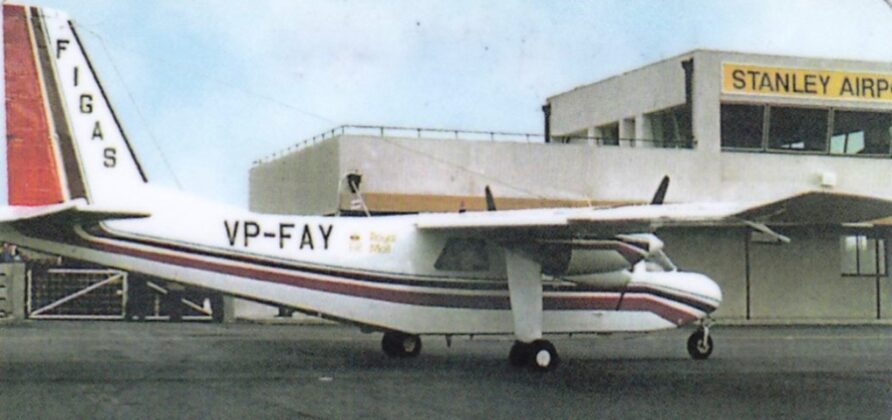
In the same year, an employee of the Scottish operator Loganair surveyed the grass airstrips of the Falkland Islands.
He found 41 grass or hard sand landing sites, all of ‘good to excellent quality, with suitable drainage for extended operation times. By the end of the year, FIGAS had carried just under four thousand passengers.
There were several reports that Argentine military pilots flew both as passengers and pilots on the regular LADE flights, but of course, these were ignored.
15 years of the Foreign and Commonwealth Office trying their hardest to appease Argentina at the expense of the Islanders came to a head in December 1980, a report in the Times noting;
The House of Commons came together in total concord yesterday to voice its deep suspicion of the intentions of the Foreign Office and of Mr Nicholas Ridley, a Minister of State, for the future of the Falkland Islands and their relationship with the Argentine.
Seldom can a minister have had such a drubbing from all sides of the House, and Mr Ridley was left in no doubt that whatever Machiavellian intrigues he and the Foreign Office may be up to, they will come to nothing if they involve harming a hair on the heads of the islanders.
The minister was left stammering and confused, as in vain he protested that nothing would be done, and no arrangement would be agreed with Argentina that had not been first endorsed both by the islanders and by Parliament.
Mr Ridley, who has just returned from a visit to the Falklands, could, not have received a colder welcome. MPs were quick to draw attention to the apparent contradiction between Mr Ridley’s assertion that the British Government had no doubt about our sovereignty over the islands and his proposal to the islanders that a solution might be found if they would agree to exchange the title of sovereignty against a long lease-back to Britain.
Another solution might be found by some method of freezing the dispute for a period, Mr Ridley added. It was essential, he added, that the Government should be guided by the wishes of the islanders and any solution must preserve British administration, law, and way of life while releasing the potential of the Falkland’s economy and maritime resources, which were at present blighted by the dispute.
Mr Peter Shore, the Opposition spokesman on foreign affairs, voiced the views of MPs of all parties when he told the minister that this was a worrying statement and that the proposal for a leasing arrangement was a major weakening of our long-held position on sovereignty in the islands.
To make that proposal in so specific and public a manner was likely only to harden Argentine policy and undermine the confidence of the islanders. From the Conservative benches, Mr Julian Amery told the minister that his statement was profoundly disturbing.
For years the Foreign Office had wanted to get rid of this commitment, although the islands had an important part to play in the future of the South Atlantic. Angrily, Mr Ridley rejected the suggestion that he was merely acting as the errand boy of the Foreign Office.
Viscount Cranbourne, another Conservative MP, told Mr Ridley that his statement had caused disquiet among his supporters and that by merely entertaining the possibility of surrender of sovereignty he was encouraging the islanders to think that they did not enjoy the support of their mother country.
From the Liberal benches, Mr Russell Johnston said that there was considerable doubt about Mr Ridley’s intentions. Shameful schemes for getting rid of the islands had been festering in the Foreign Office for years. Mr Ridley again protested his innocence and his good intentions to loud shouts of ‘no’.
A few moments later, Mr Ridley floundered into deeper water. when he was asked whether the Government would accept the views of the islanders if they opted for the maintenance of the status quo.
The minister seemed to many to be dodging the issue when he replied: ‘We shall have to wait to see how the situation develops’
The one certainty of yesterday’s exchanges for the Falkland Islanders was that if ever the ‘festering plots’ of the Foreign Office should reach the floor of the House of Commons, they will be given very short shrift
June 1981 saw an overflight of South Georgia by an FAA C-130 Hercules, and continued prevarication and mixed messages from the British Government, for example, the announcement of the withdrawal of HMS Endurance, HMY Britannia got a refit, though.
I can confirm that HMS “Endurance” will be paid off in 1982 on her return to the United Kingdom, following her deployment in the South Atlantic and the Antarctic Region later this year.
There are no plans to replace her. However, the Royal Marines garrison in the Falkland Islands will be maintained at its present strength, and from time to time, Her Majesty’s ships will be deployed in the area.
Lord Trefgarne, Foreign Office Minister, 30th June 1981
And despite the political environment becoming increasingly toxic and the likelihood of a military action equally obvious, flights continued, like this one in 1981
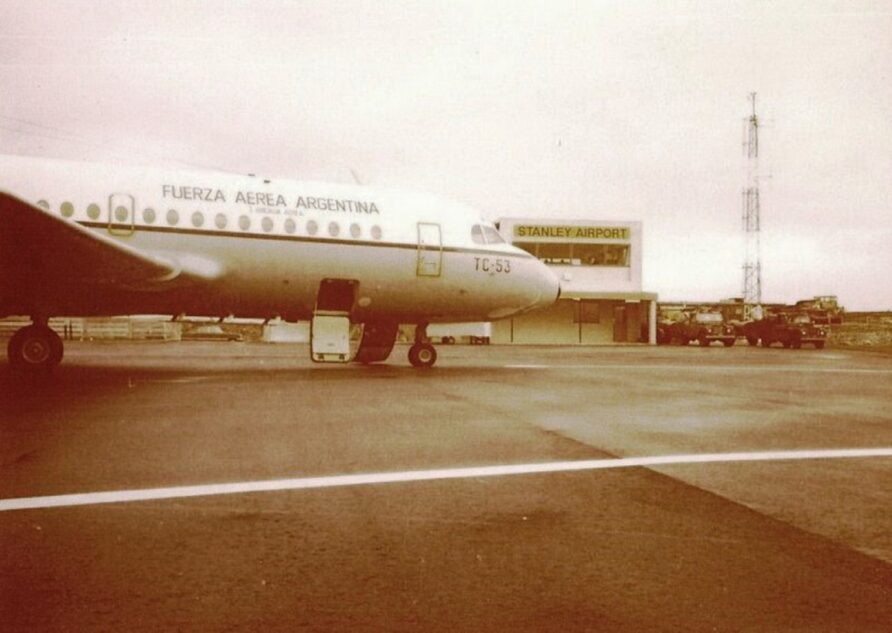
Until the occupation, LADE carried 465,763 passengers and 21,597 pounds (ca. 10 t) of cargo between the Falkland Islands and the mainland, amassing 3,553 hours.
On March 11th, 1982 an Argentine Air Force (FAA) C130H made an ‘emergency landing’ at Stanley Airport but were out within the hour, and another landing, by an FAA Learjet followed on the 19th
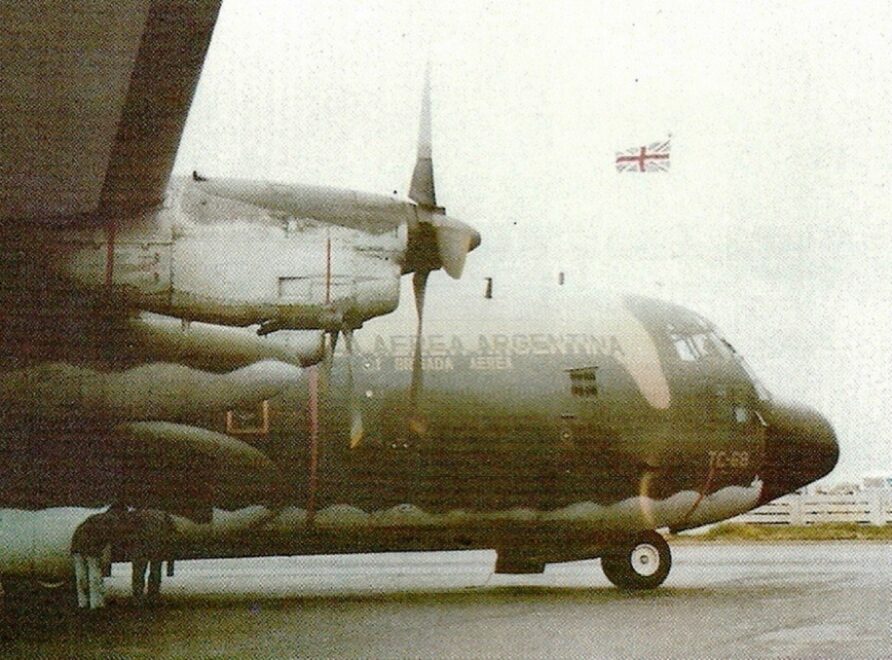
Both raised eyebrows but also ignored, there were clearly reconnaissance and proving flights. The last three scheduled LADE flights in Stanley Airport took place on 16th March, 23rd March and 30th March 1982.
On the evening of the 1st of April 1982, one of the FIGAS Islanders was flown to the racecourse in readiness for a first light recce but events of the early hours of the 2nd made this moot, it was flown back to Stanley Airport.
By the beginning of the conflict, the Falkland Islands had many grass airstrips and a permanent runway with associated facilities.
Importantly, there was also a large stock of aluminium airstrip matting on the island and the local forces knew full well both the importance of the runway and that Argentine forces were both intimately familiar with and had augmented this with aircraft-specific reconnaissance flights.
Conflict
By the beginning of April 1982, the invasion was imminent and expected.
Vastly outnumbered, the Royal Marines and Falkland Island Defence Force deployed two personnel to the beach at York Bay with barbed wire and a GPMG, the runway at Stanley Airport was blocked with vehicles and the directional beacon switched off, and a section deployed to the Airport.
Invasion
The Argentine invasion plan emphasised overwhelming force to convince Naval Party 8901 to surrender without fighting.
Landing Force (Task Unit 40.1) comprised 904 Marines and soldiers in a combined arms unit with engineers, artillery, air-defence units and amphibious armoured vehicles.
Although it was a combined force, the majority were Marines, with only 39 from Ejercitos 25h Infantry Regiment.
The landing force was in possession of ample intelligence on Stanley Airport and the surrounding areas.
At 5.30 am on the 2nd April, Admiral Busser sent a message to the Landing Force, the invasion was about to move beyond the point of no return;
I am the Commander of the Landing Forces, made up of the Argentinean Marines and Army on this ship, of units aboard the destroyer Santisima Trinidad and the icebreaker Almirante Irizar and the divers onboard the submarine Santa Fe. Our mission is to disembark on the Falklands and to dislodge the British military forces and authorities installed there. That is what we are going to do.
Destiny has wished us to be the instigators of making good the 150 or so years of illegal occupation. In those islands, we are going to come across a population with whom we must develop a special relationship. They live on Argentine territory and consequently, they must be treated as though they are living on the mainland.
You must be punctilious in respecting the property and integrity of each of the inhabitants.
You will not enter into any private residence unless it is necessary for reasons of combat.
You will respect women, children, old people and men.
You will be hard on the enemy, but courteous, respectful and pleasant in your dealings with the population of our territory and with those we have to protect.
If anyone commits rape, robbery or pillage, I shall impose the maximum penalty. And now, with the authorization of the Commander of the Transport Division, I am sure the Landing Force will be the culmination of the brilliant planning other members of the group have already achieved.
Thank you for bringing us this far, and thank you for landing us tomorrow on the beach. I have no doubts that your courage, honour, and capability will bring us victory. For a long time, we have been training our muscles and our hearts for the supreme moment when we shall come face to face with the enemy.
That moment has now arrived. Tomorrow you will be conquerors. Tomorrow we shall show the world an Argentine force valorous in war and generous in peace. May God protect you! Now say with me, Long live the Fatherland! (Operacion Rosario)
Operation Virgin del Rosario started in the late evening of April 1st, 1982 when Argentine special forces landed at Mullet Creek.
The first wave consisted of four LVTP-7’s, the second, fifteen Amtracs and the final wave, five LARC’s and a recovery LVTP-7.
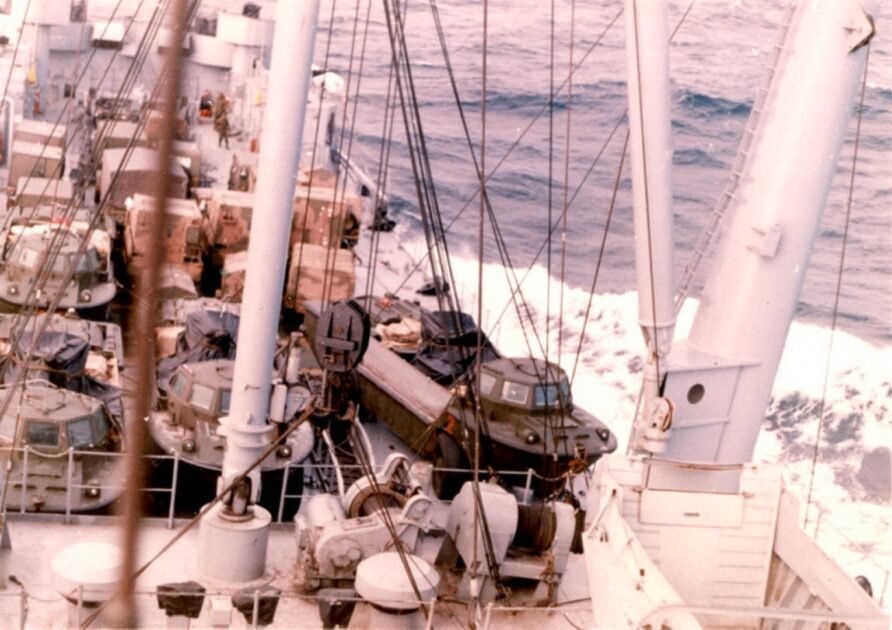
Follow on forces were to land a short while later and to the North of Stanley, after a special-forces team landed from the submarine Santa Fe, the main force came ashore at Yorke Bay, pushing through the dunes and on to the airport.
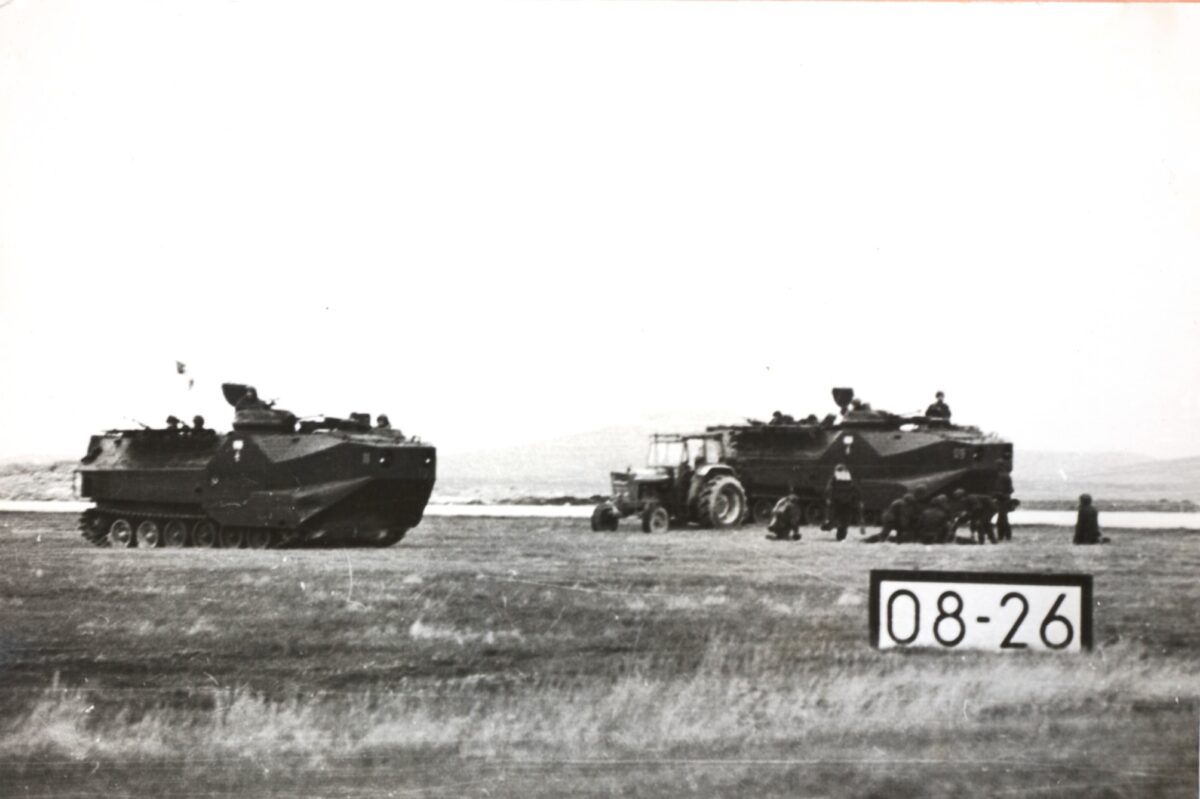
The airport was quickly occupied and the task of clearing the runway obstacles began.
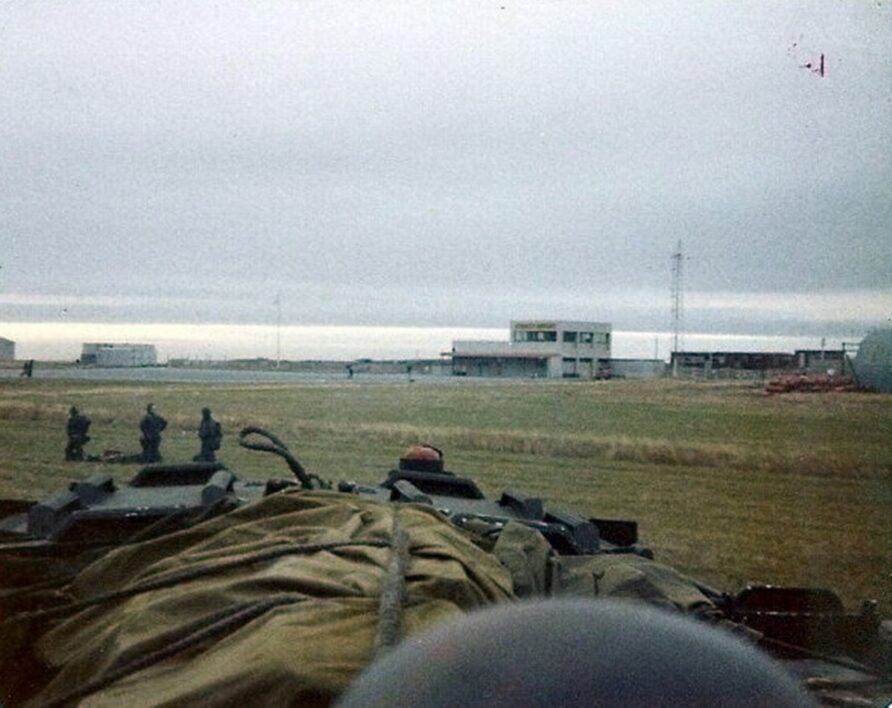
After a stiff firefight, Governor Rex Hunt ordered the Royal Marines to surrender.
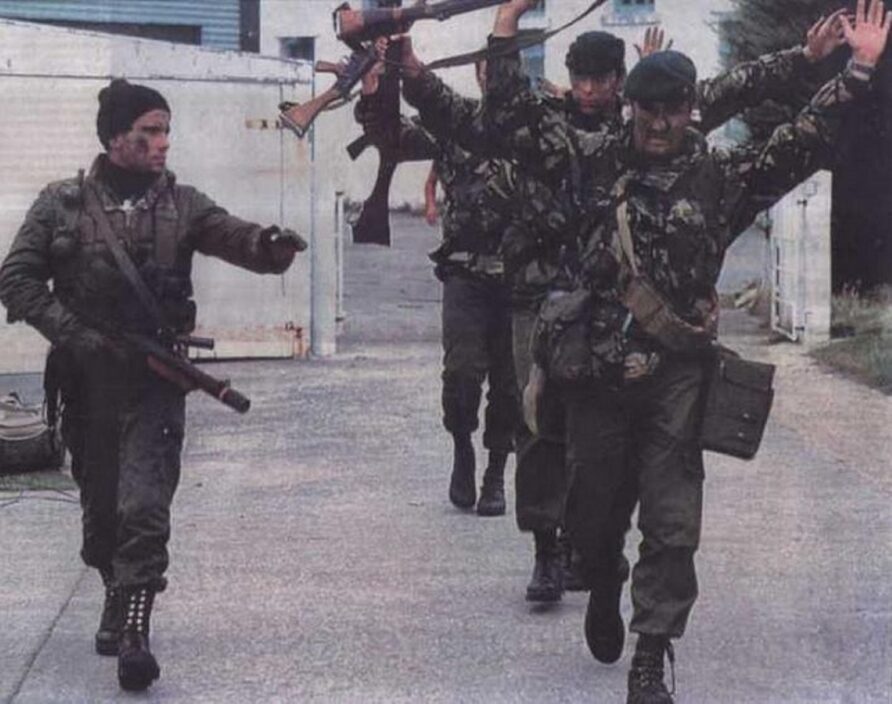
One Argentine Marine later died from his wounds, and two others were seriously injured.
Don’t make yourself too comfy, mate, we’ll be back.
Unknown British Royal Marine (as leaving, to Argentine guard)
The first Argentine aircraft to land at the airport was a Sea King, 2H-231, landing at 07:34.
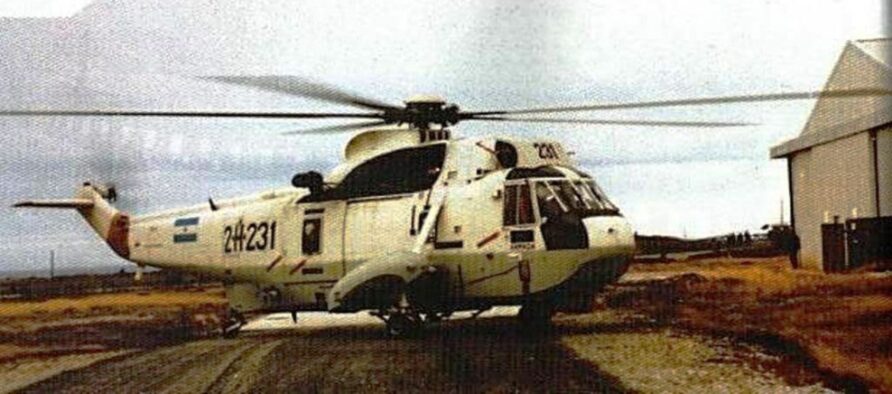
Later that morning, ARIES 82 (FAA air bridge) commenced, the first aircraft into Stanley Airport was a C-130(H) (TC-68) landing at 08:45, followed by two F-28’s from Comodoro Rivadavia, carrying personnel of the 25th Infantry Regiment and a number of FAA specialist personnel.
The ‘La Estación Aeronaval’ was established with the Argentine flag raised, preparations were quickly made to change the signage.
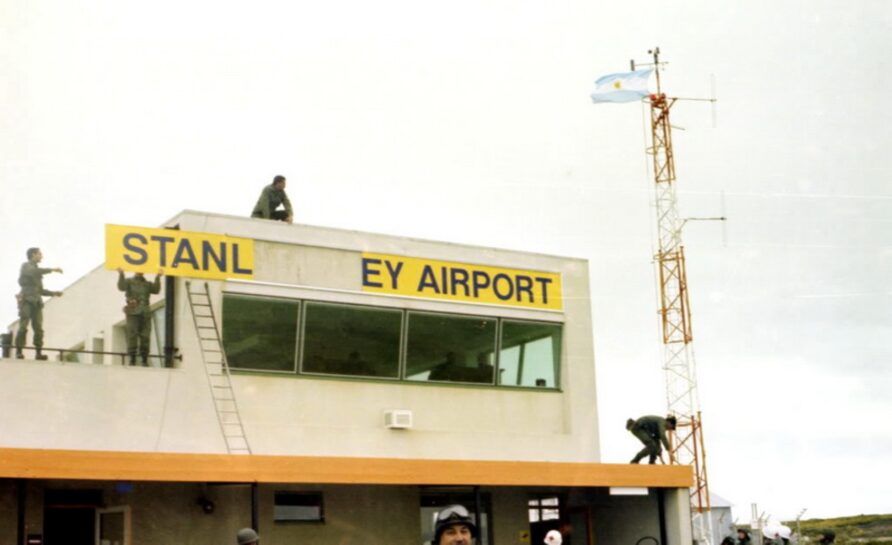
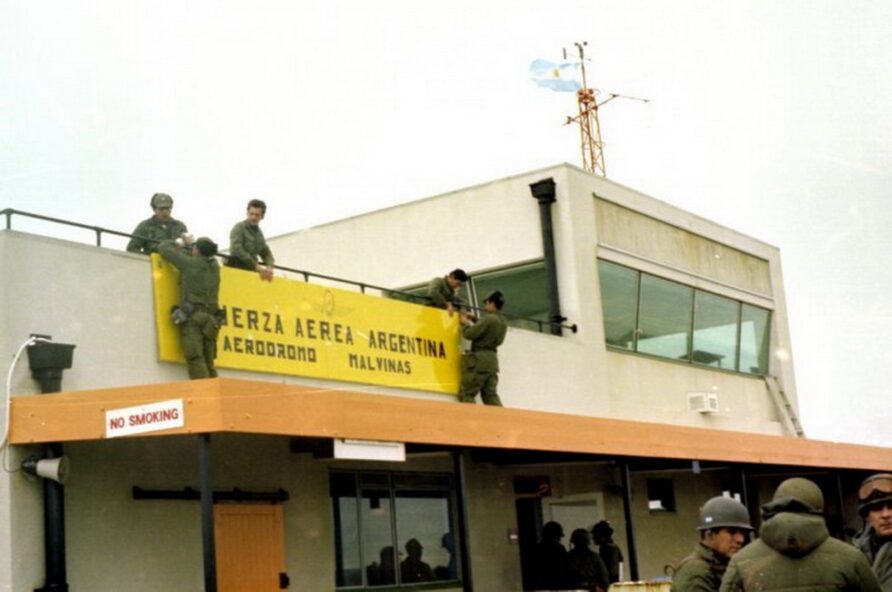
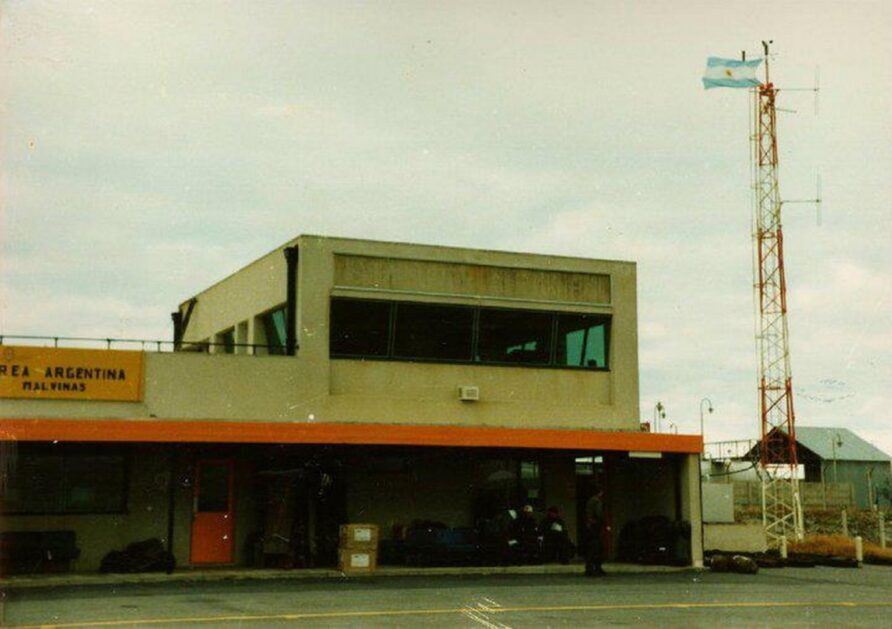
As can be seen from the images above, the airport was also called Base Aérea Militar (BAM) Malvinas, inter service rivalry is common in all armed forces, I think.
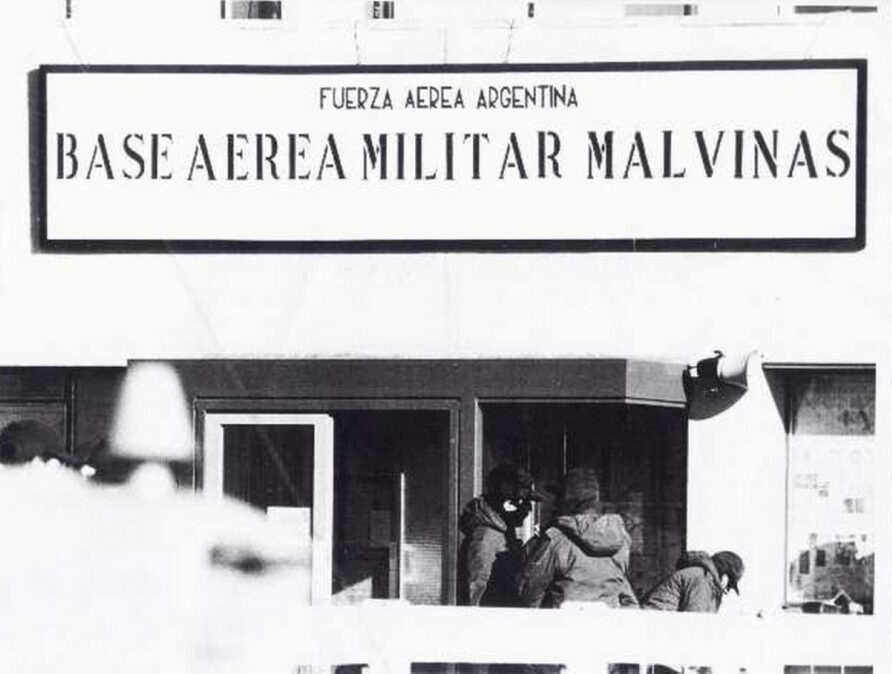
After the surrender of the Royal Marines, they were flown to Montevideo by an Argentine Air Force C130 that had landed at the airport.
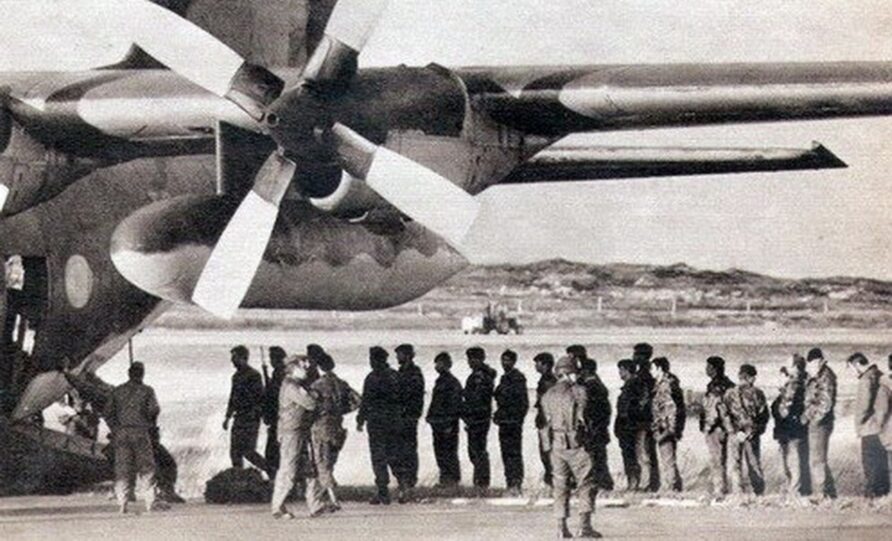
Argentine Consolidation and UK Planning
The occupying force then quickly set about reinforcing the Islands from both land and sea, pretty much, with everything they had.
Despite them thinking the British might accept the situation and negotiate, there was always the possibility they would not, and no one fancied a scrap without extensive preparation.
Fuerza Aérea Argentina (FAA) and Aerolíneas Argentinas Fokker F28 Fellowship, Boeing 737, Lockheed Electra and BAC 1-11 aircraft were also used to fly in weapons, vehicles, supplies, and personnel.
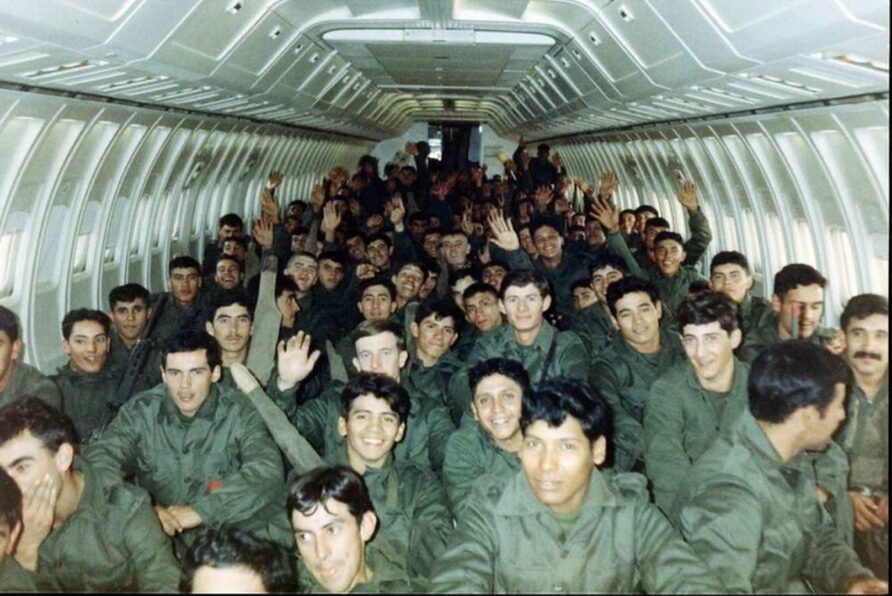

FAA C130 Hercules were used for bulky and palletised stores.
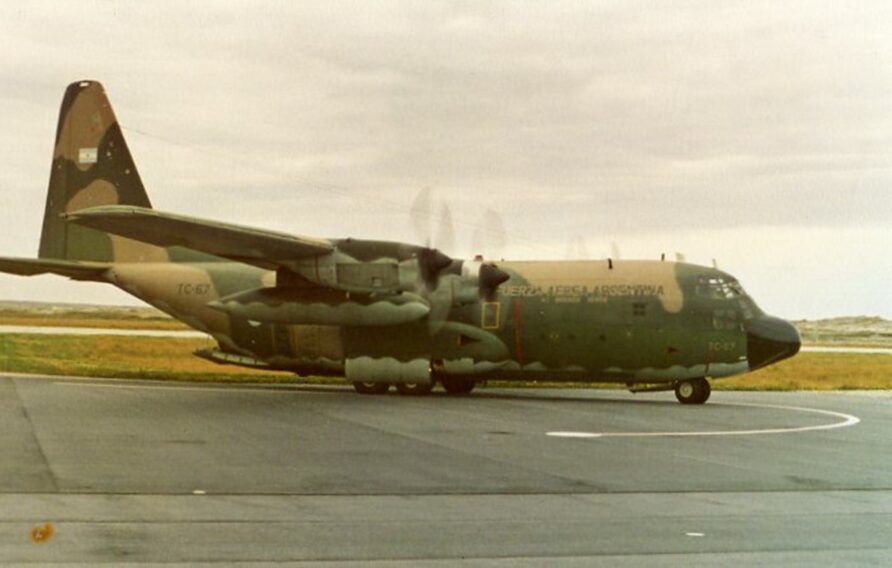
The Royal Marines 4 tonner was used for loading and unloading, cheeky buggers.
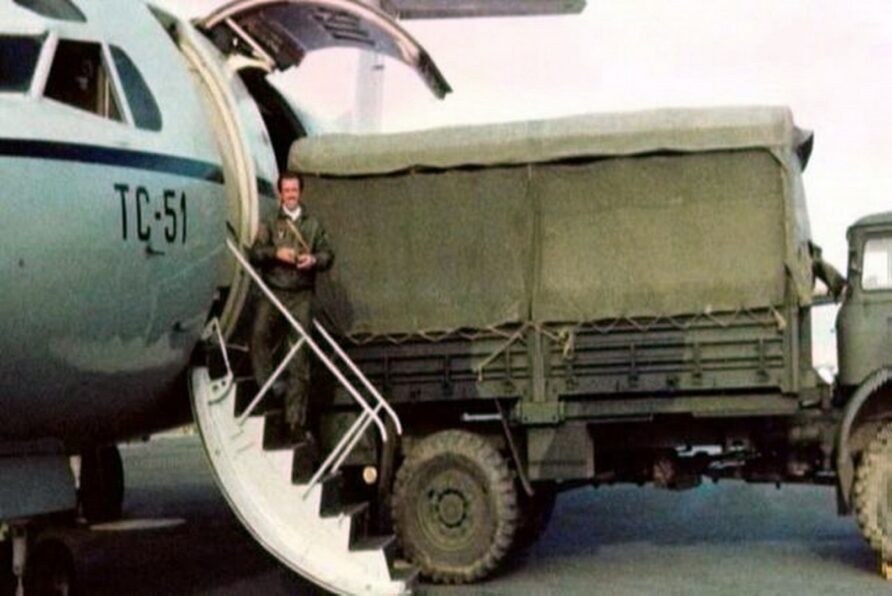
The control tower was a hive of activity (note the intact glass)
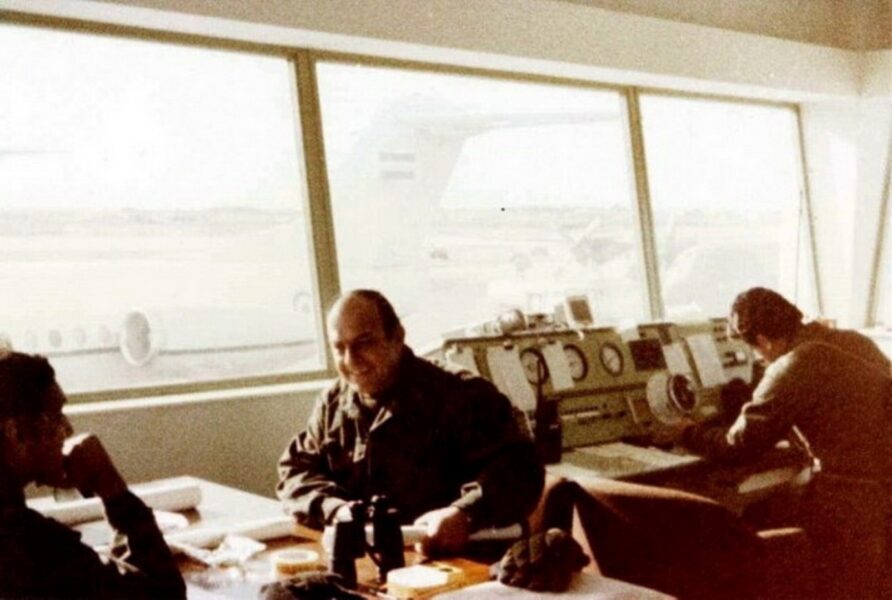
Aermacchi MB339 and Beechcraft T-34C Mentor trainers and light attack aircraft, in addition to the ubiquitous IA 58 Pucara were all based at Stanley.
Chinook’s, Puma’s, A109’s, Skyvans and S-2E Trackers also used ‘La Estación Aeronaval’ during April.
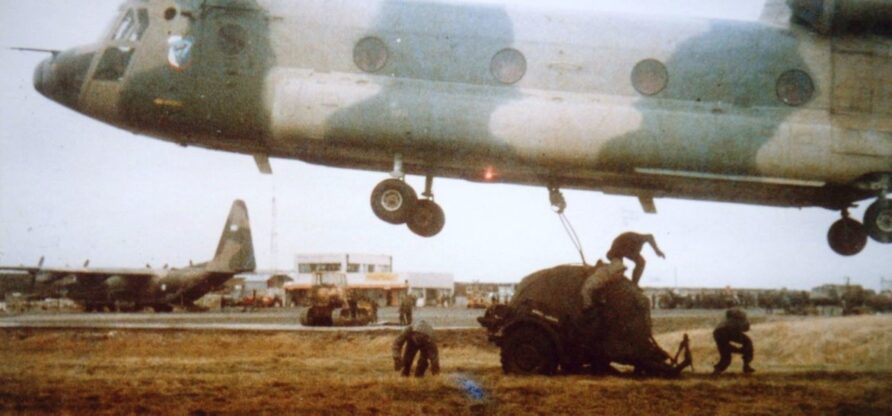
The first to arrive were four Pucaras from Grupo 3, on the 2nd of April.
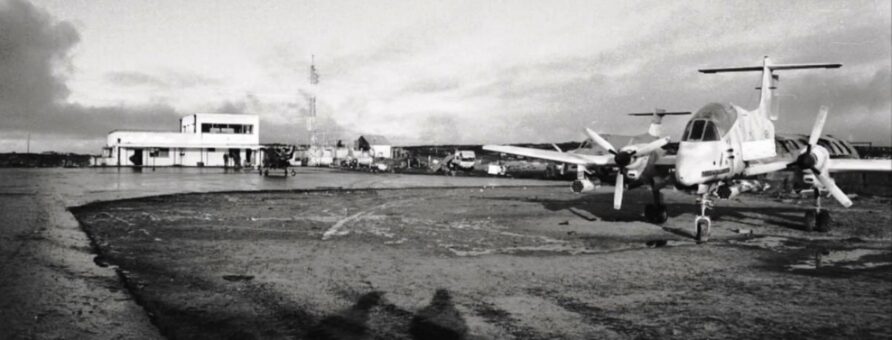
The S-2E trackers arrived on the 3rd but had left within ten days.
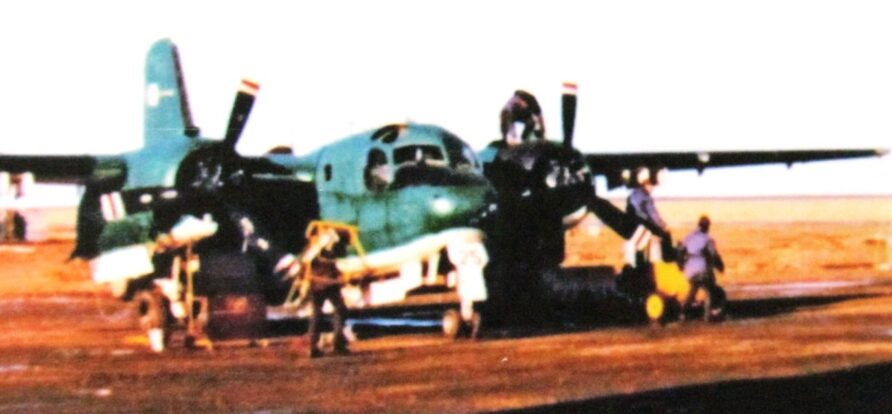
The five S-2 Trackers conducted 528 flying hours over 112 sorties from Stanley.
Two Skyvans (PA-50 and PA-54) and a Puma (PA-13) were used for search and rescue and general transportation tasks.
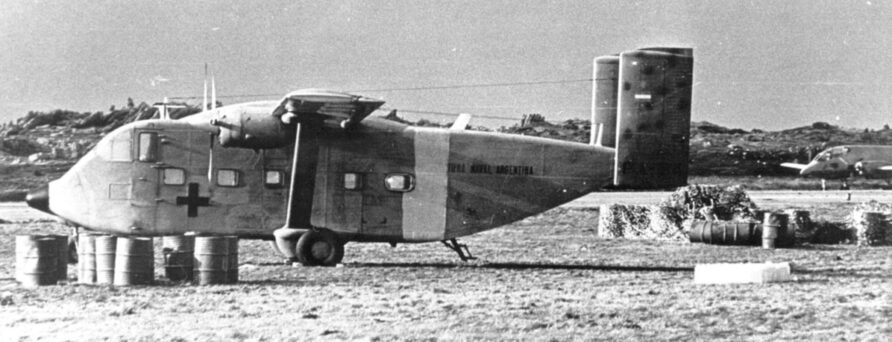
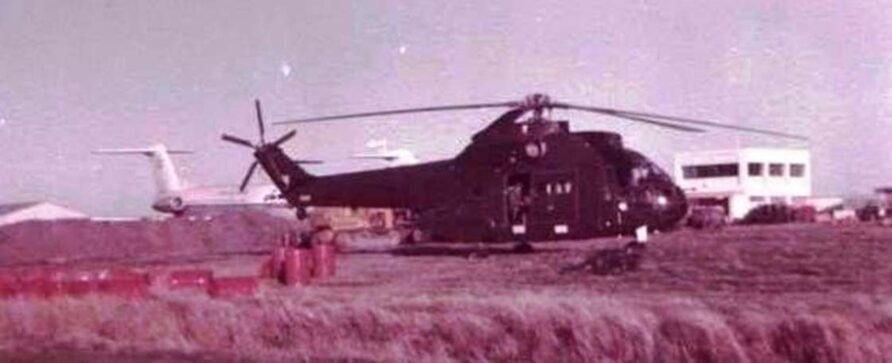
The FIGAS Islander was also pressed into service, flown by LADE pilots in multiple sorties totalling 30 hours.
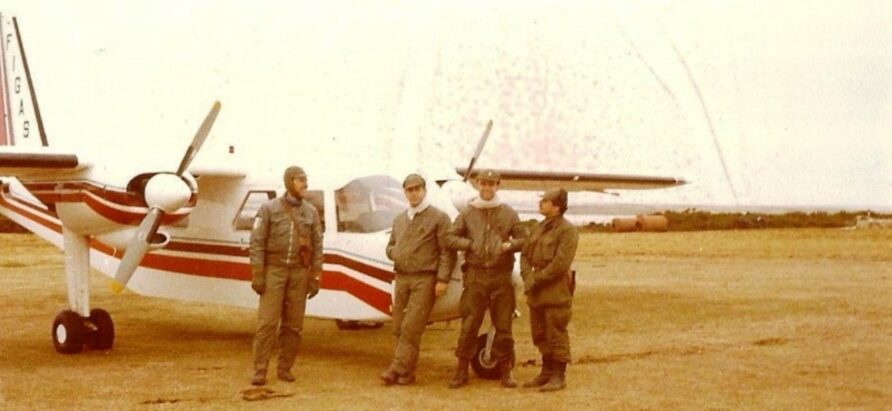
Perhaps the most important early arrival was the FAA’s Westinghouse AN/TPS-43F 3D radar, on the 2nd of April. Although originally intended to enhance local air traffic control, it would go on to be a vital component of the Argentine defence of the islands, and one that, despite the UK’s best efforts, remain operational until surrender.
On the 3rd of April 1982, the UN passed Resolution 502, demanding the withdrawal of Argentine forces, a cessation of hostilities and a political solution.
This came as a surprise to the Argentine leadership, they genuinely thought the UN would support their intervention.
The day after, the Vulcans were being prepared (and by prepared, I mean raiding museums and disposal locations).
The radar was first sited near the airport but then moved to Port Stanley on the 13th of April and disguised among several civilian houses, civilian houses the Argentine forces did, in fact, pay rent for.
A dummy was left in its place.
The FAA used the modern Westinghouse AN/TYP-43F and supporting Ejercitos Cardion AN/TPS-44 radar with a great deal of skill, using its capabilities to extrapolate the location of the aircraft carriers by plotting Harrier movements, for example.
The Cardion AN/TPS-44 was initially deployed to Sapper Hill, but was also later moved into Port Stanley.
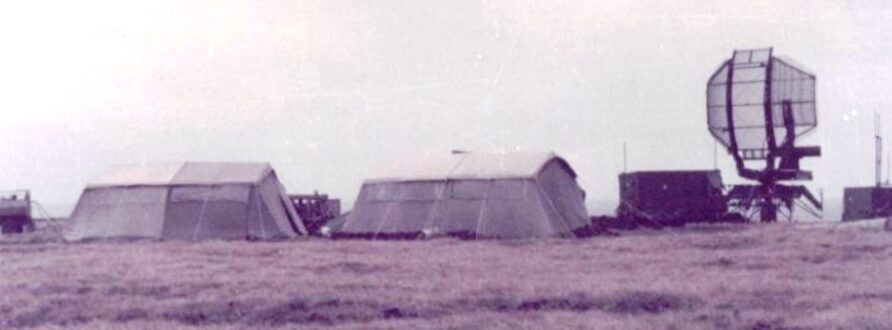
Providing local air defence for the airport and surrounding areas were a plethora of systems, including Roland
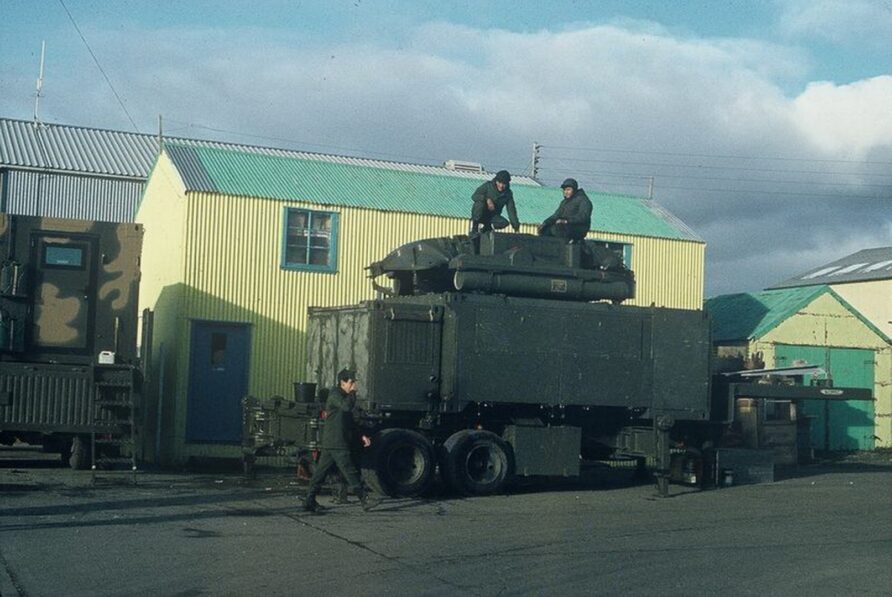
Tigercat and some different types of radar-guided (Skyguard and Super Fledermaus) and manually aimed medium calibre automatic weapons.
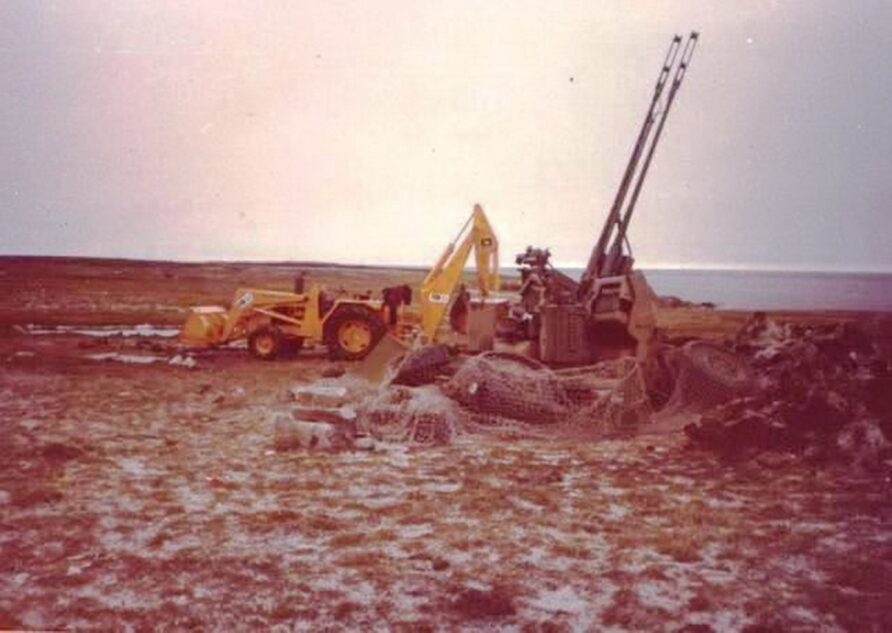
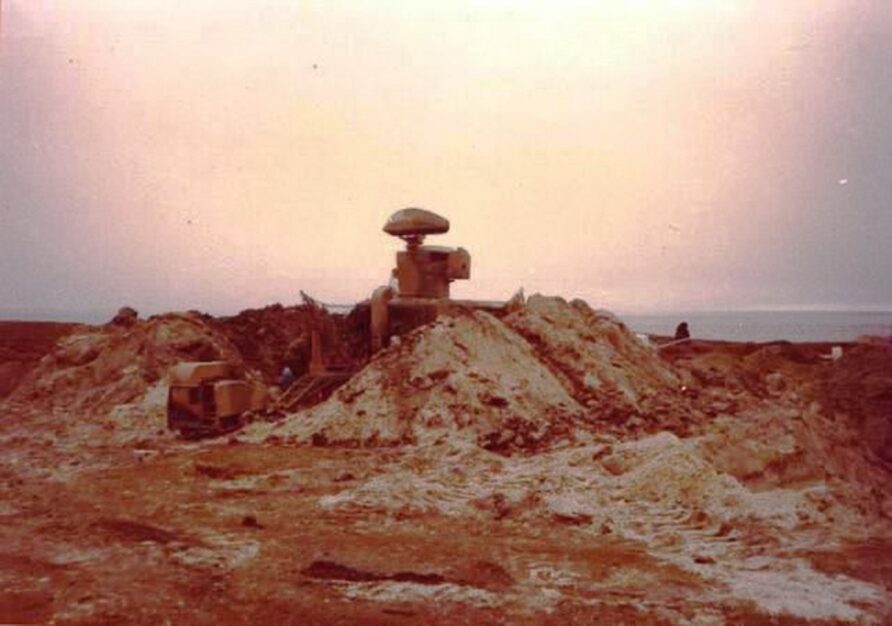
The air defence system was formidable and would also be used to provide advanced warning of ships approaching to attack the area using their guns, specifically, the Cardion radar.
Later in the conflict, they would also be used to support the ground-launched Exocet attacks and counter NGS using the Argentine 155 mm artillery.
The ‘British Military Machine’ was starting to move…
By the 7th of April, there was a realisation in the minds of the Argentine leadership that the world, and more importantly, the UK, was not going to accept the existing state of affairs.
On the 9th of April, US Intelligence reported that Argentina was lengthening the runway at Stanley to accommodate C-130′, A-4 Skyhawks, Mirage/Dagger and Etendard combat aircraft.
This precipitated a crash programme of reinforcement and because of the Maritime Exclusion Zone declared by the UK on the 12th of April and the fear of British submarines meant the bulk of this additional equipment and other stores would have to travel through ‘BAM Malvinas’.
Equipment was taken off ships and broken down for transport via the hard-pressed C-130 force.
By the 10th, the operational tempo of this airlift operation had increased markedly, as had the type of equipment by now streaming into Stanley, radar equipment, anti-aircraft guns, artillery and vehicles, for example.
By the time of the start of combat operations at the beginning of May, the combined Argentine force included 46 aircraft, these would be joined by an additional 12 Pucara and 2 MB339 in May.
They operated from the three main locations of Pebble Island, Stanley and Goose Green, the latter two protected by a formidable integrated air defence system.
Of the 60 aircraft thus deployed, only three would escape destruction or capture.
By the middle of April, RAF Victors and Vulcans had started airborne refuelling practice, and the fleet was well on its way South.
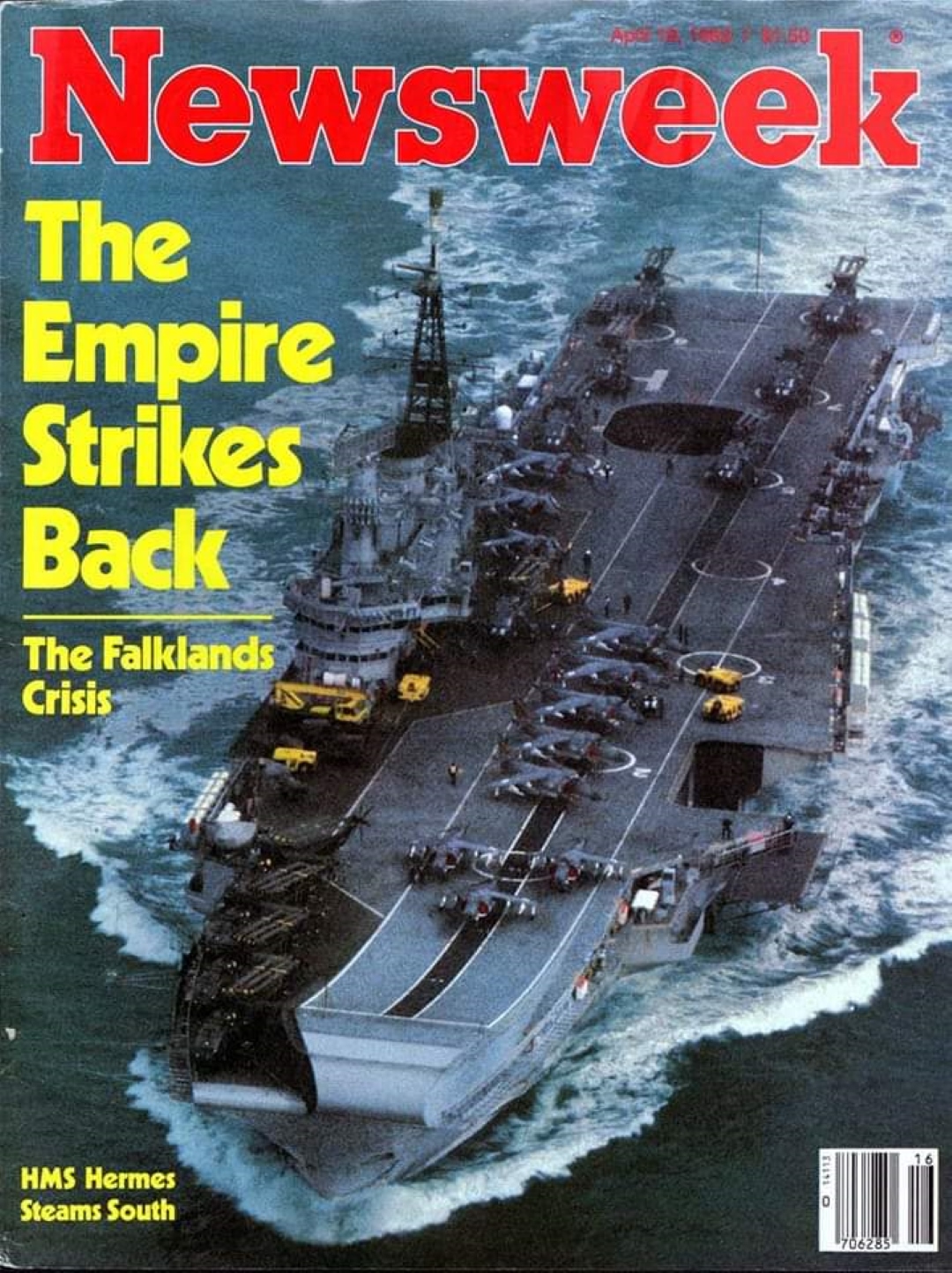
On the 22nd of April, Rear Admiral Woodward requested plans on how the Sea Harriers could be used to interdict Stanley Airport, and this prompted more serious consideration of earlier discussions about the use of the soon-to-be withdrawn Vulcans.
Initial plans had considered a light bomb load to reduce the tanking and fuel requirement, but after tests on Garvie Island, this was revised to the full 21, thousand-pound bombs.
RAF Wideawake at Ascension Island was extremely busy.
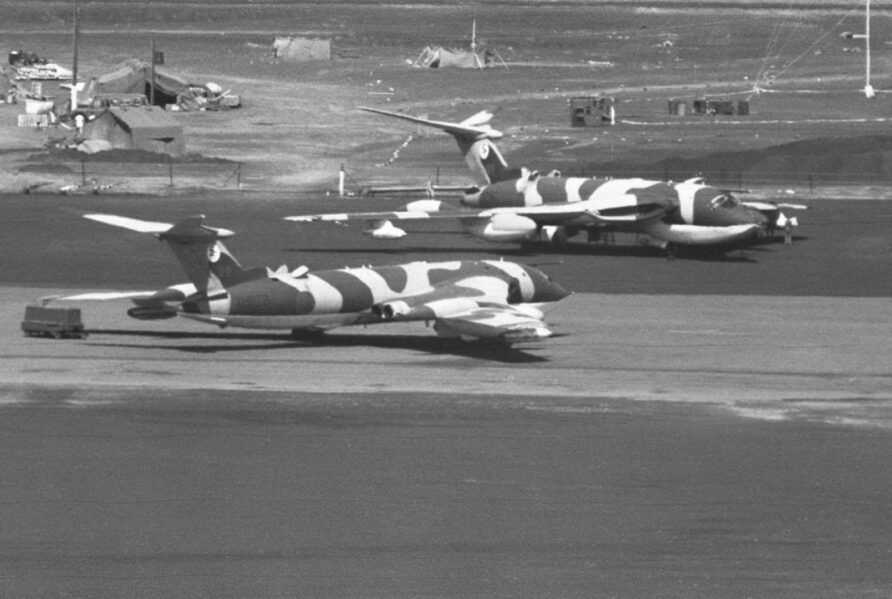
In the following days, there was considerable debate about the merit of the Vulcans, their potential for other tasks, comparisons with the Sea Harrier and the political implications of launching offensive operations off the US base at Ascension.
These debates eventually concluded, Sea Harriers were too important for air defence and not best suited to runway denial were the main decisive points in the debate.
By the end of April, diplomatic efforts had been exhausted, the Argentine forces were facing up to the inevitable, South Georgia had been retaken, and the first Vulcans had arrived at Ascension Island.
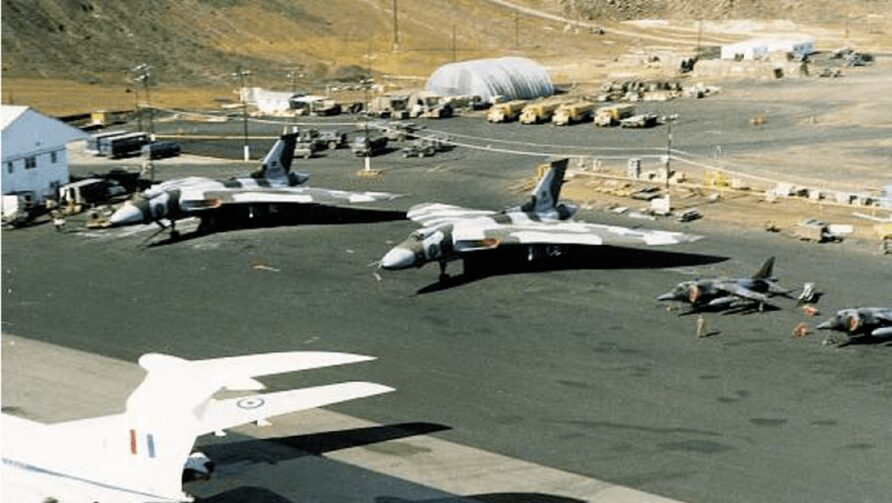
If April was a busy but relatively peaceful month for the invaders, May was to be very different indeed.
The Raids on Port Stanley
Argentine forces at Stanley Airport were about to get a wake-up call, XM607 was in its way.
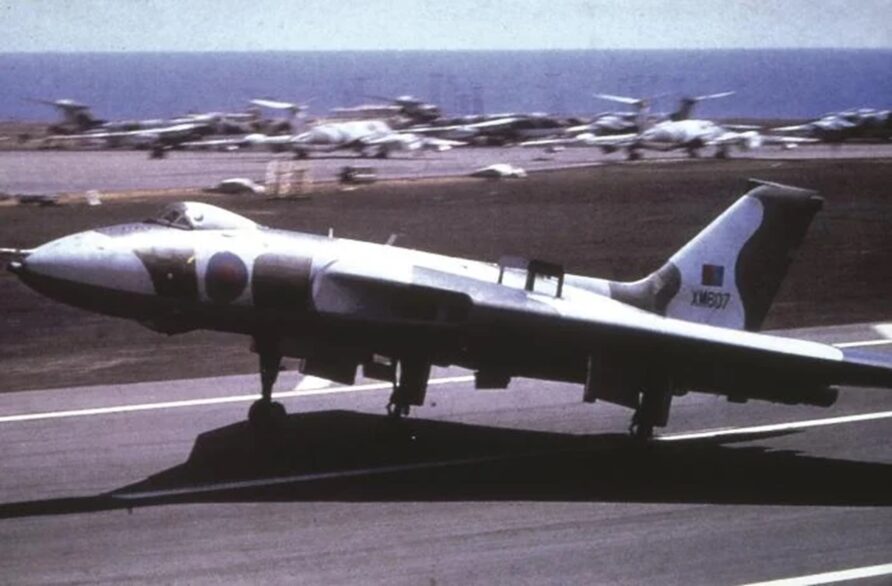
I am not going to dwell on the superb airmanship and improvisation that preceded Black Buck 1 because they are amply covered by many excellent authors such as Roland White with Vulcan 607, Wikipedia is also excellent, and even a casual online search presents many other sources of information.
At 4 am, Vulcan XM607 delivered its bomb load of twenty-one, one thousand pound bombs, at an angle of 35 degrees across the runway at Stanley Airport.
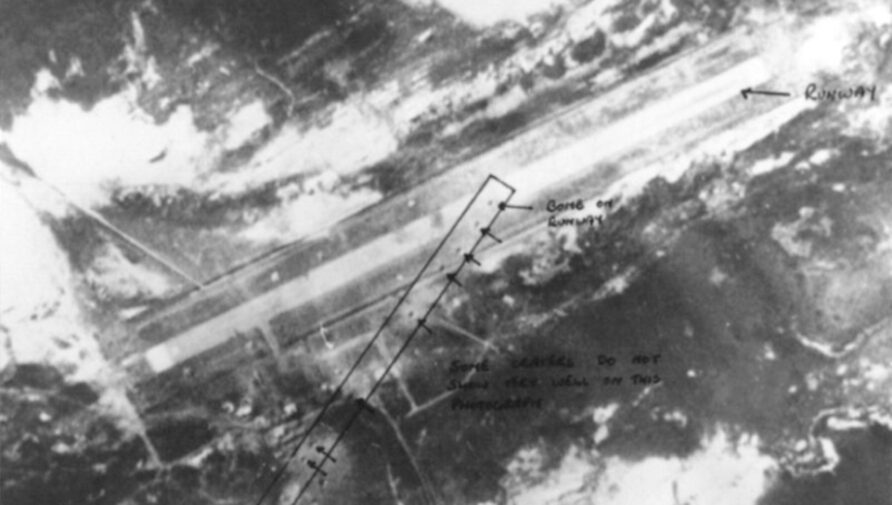
It was a bravura feat of arms that took the world, Argentina, and especially, those at Stanley Airport, completely and totally, by surprise.
A follow-up by nine Royal Navy Sea Harriers of 800 Naval Air Squadron with cluster and one thousand pound bombs and naval gunfire from HMS Alacrity, HMS Glamorgan, and HMS Arrow caused further damage.

The attacks caused damage to the runway, control tower, fuel supplies and the ‘Quonset’ storage building.
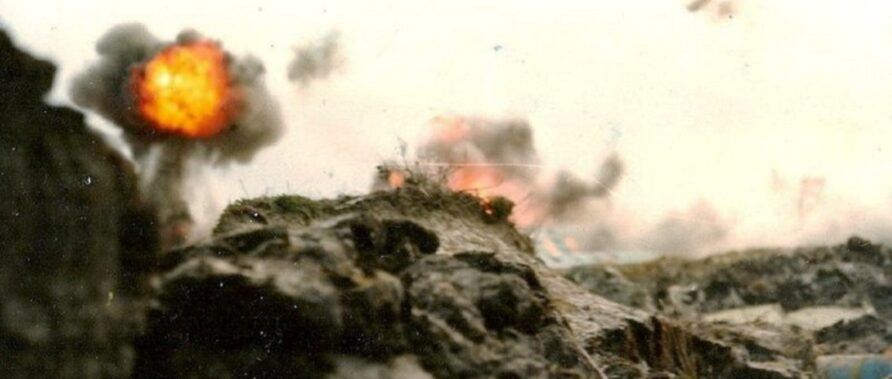
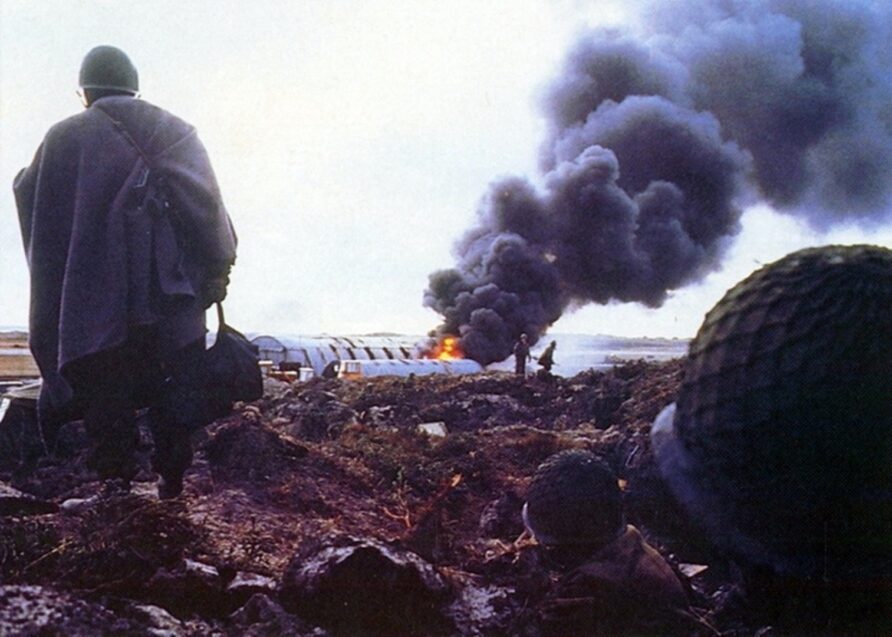
The FIGAS Islander was damaged by one of the Sea Harriers cluster bombs and subsequent attacks.
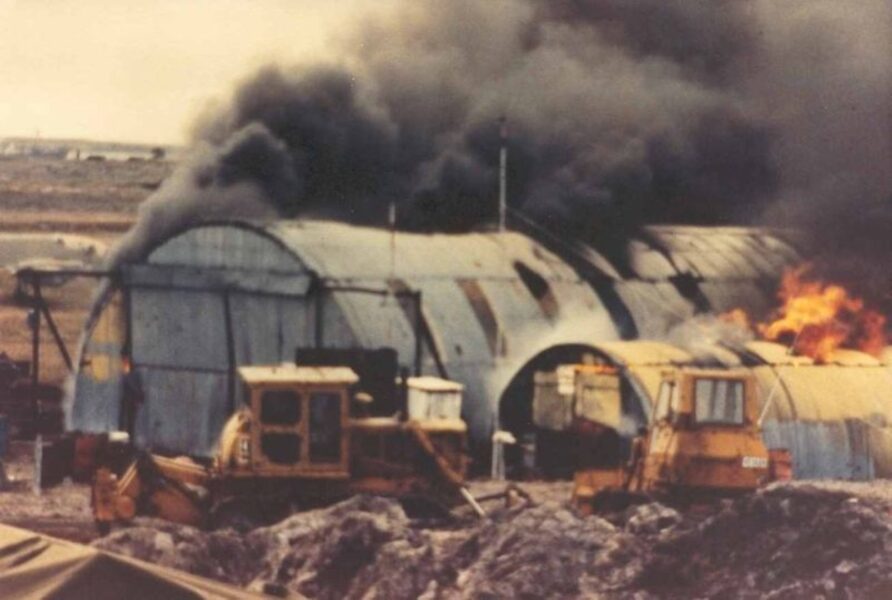
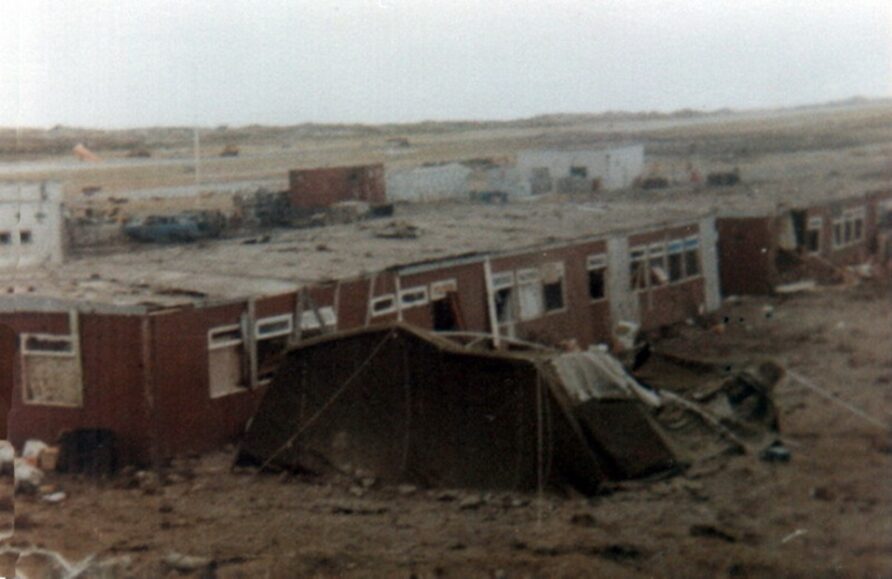
These attacks also destroyed the three civilian registered Cessna light aircraft operated from Stanley Airport.
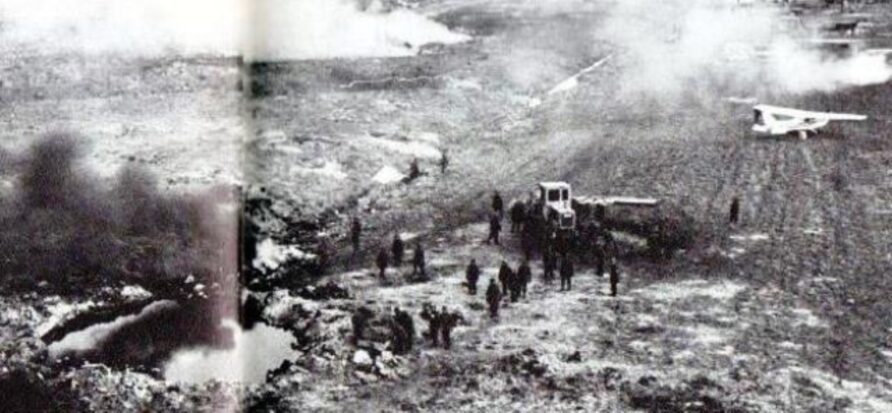
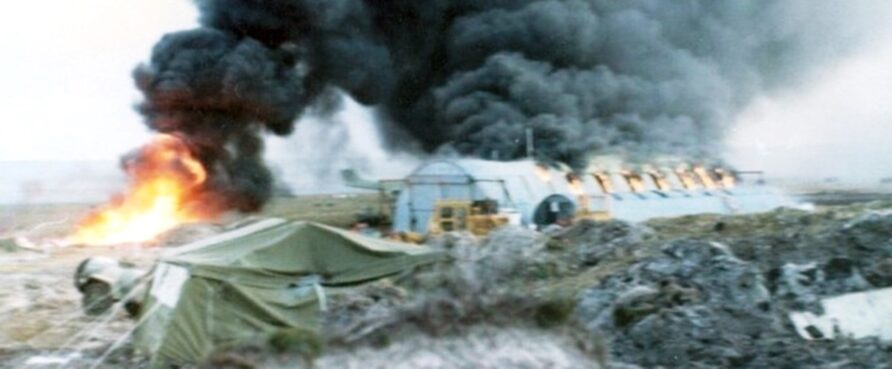
Life became a lot grimmer for the invaders.
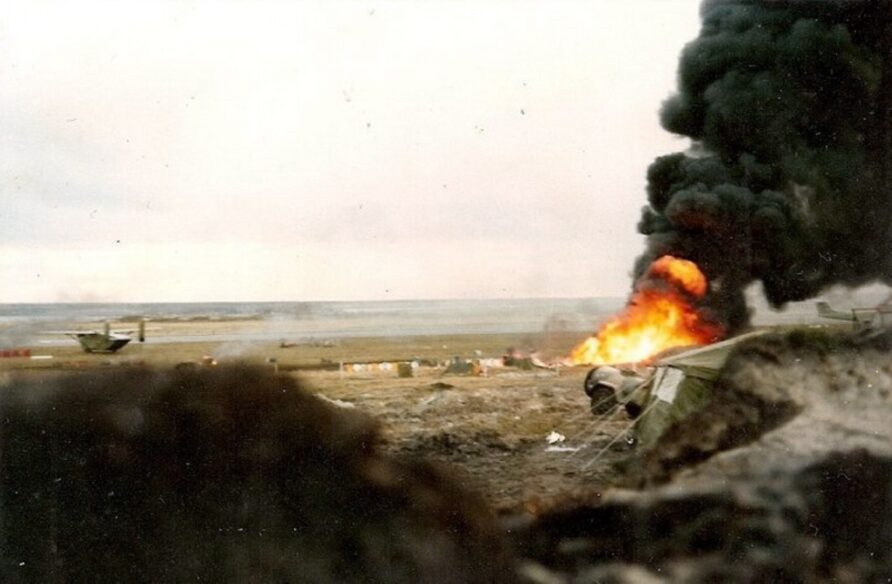
A Mirage, Dagger, and Canberra were shot down and a similar Sea Harrier/NGS attack was carried out at goose Green, resulting in a destroyed Pucara.
During this engagement, a Grupo 8 Mirage was damaged and attempted an emergency landing at Stanley Airport, it was shot down by Argentine ground forces.
The aftermath of Black Buck I and Harrier raids also caused the hasty departure from Stanley harbour of two Argentine merchant vessels without having fully unloaded their cargo.
The 20,000 tonnes cargo vessel Formosa was later attacked by the Argentine Air Force and sailed all the way back to Argentina with an unexploded bomb in her hull, alongside nearly 4,000 railway sleepers and 200 rails that were to be used for field defences in the hills surrounding Stanley.
The other, the 10,000 tonnes Carcaraña, departed Stanley with 50 tonnes of aviation fuel, all B Company GADA 10s ammunition and vehicles, a multi launcher rocket system and various other stores.
The FIGAS Islander (VP-FAY) was destroyed, its tail severed, during the attacks on the 2nd
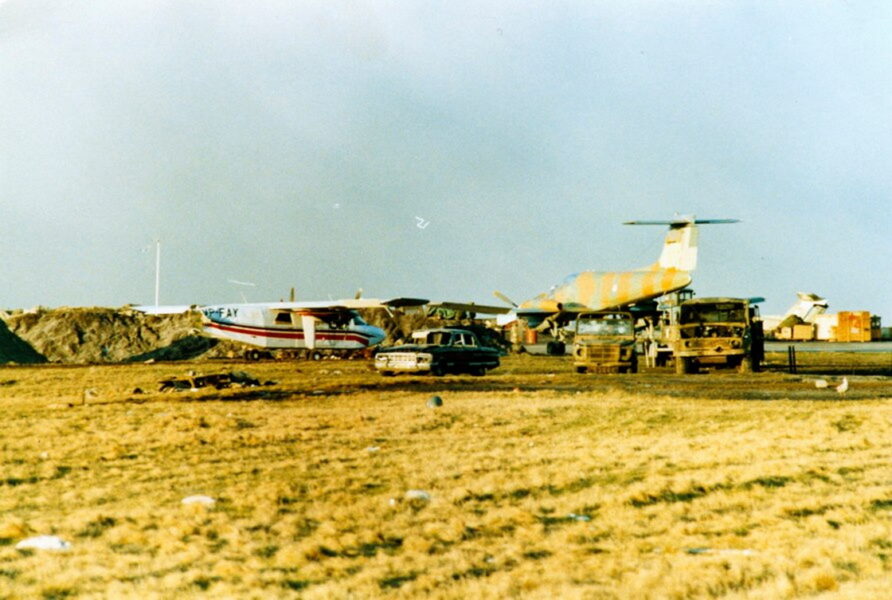
Although not at the airport, the FIGAS Beaver float plane was also destroyed during later attacks, the image below is post surrender.
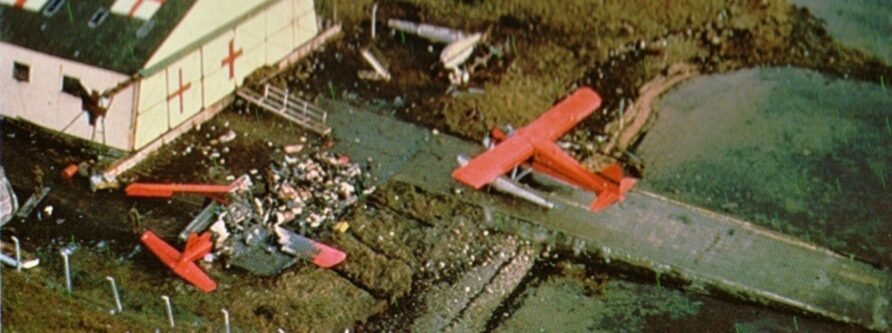
Video, including footage from an Argentine TV camera crew…
The airport control tower was relieved of its glass.
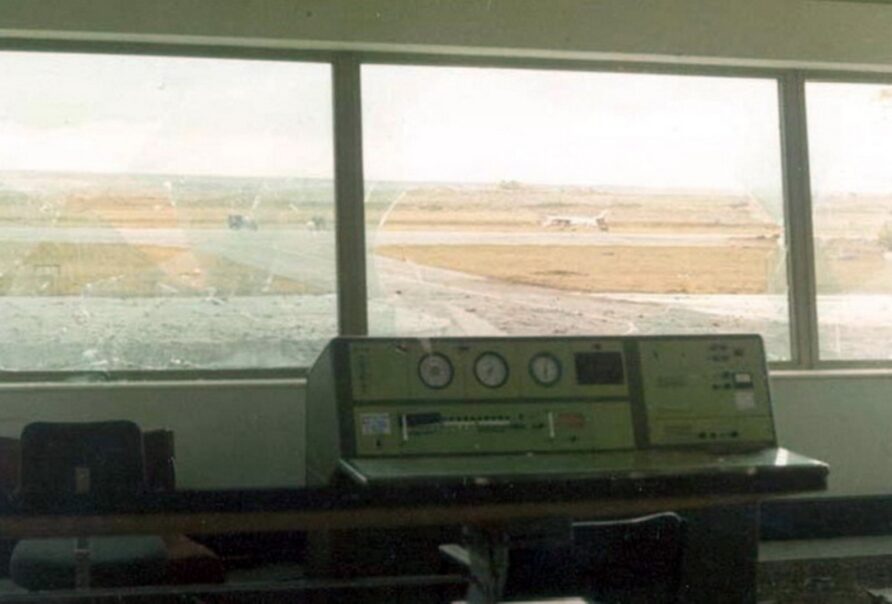
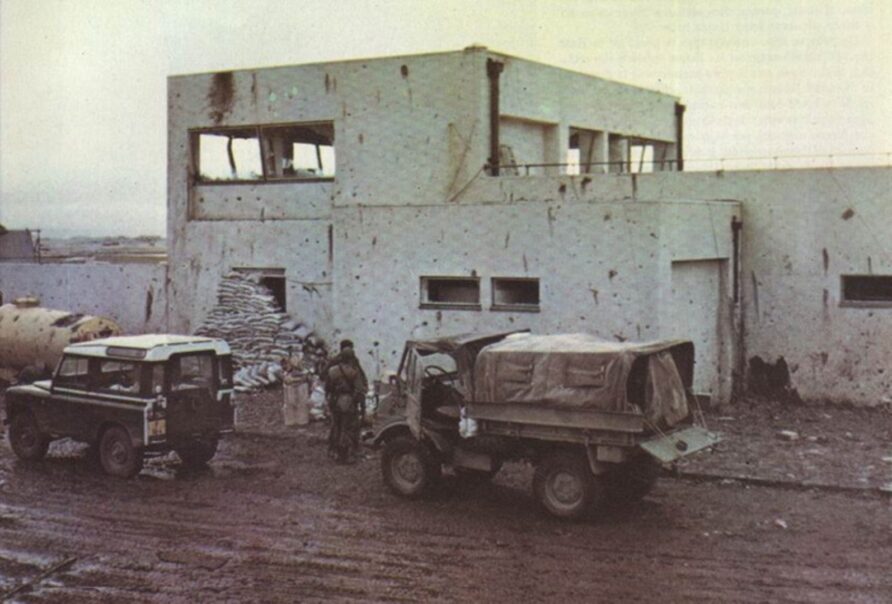
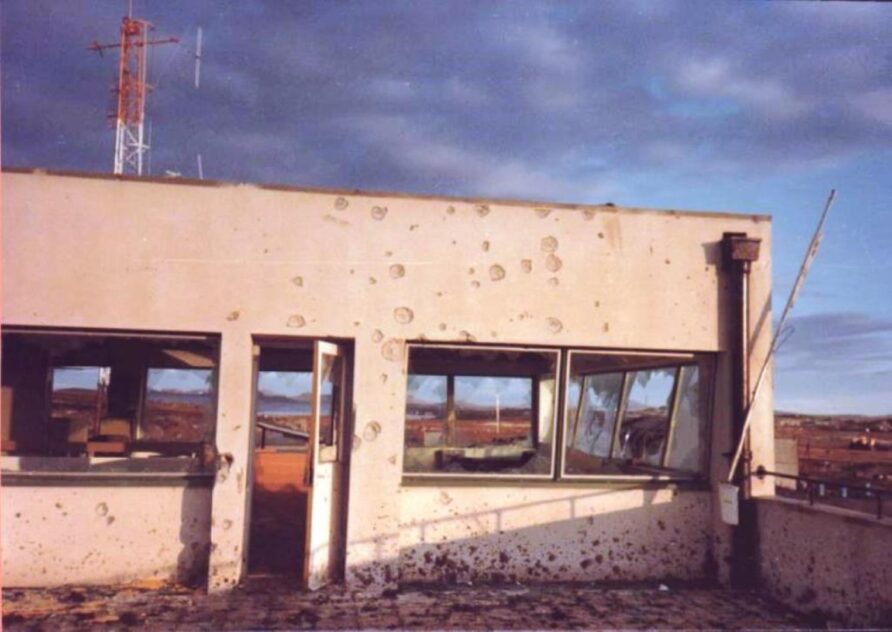
And ventilated.
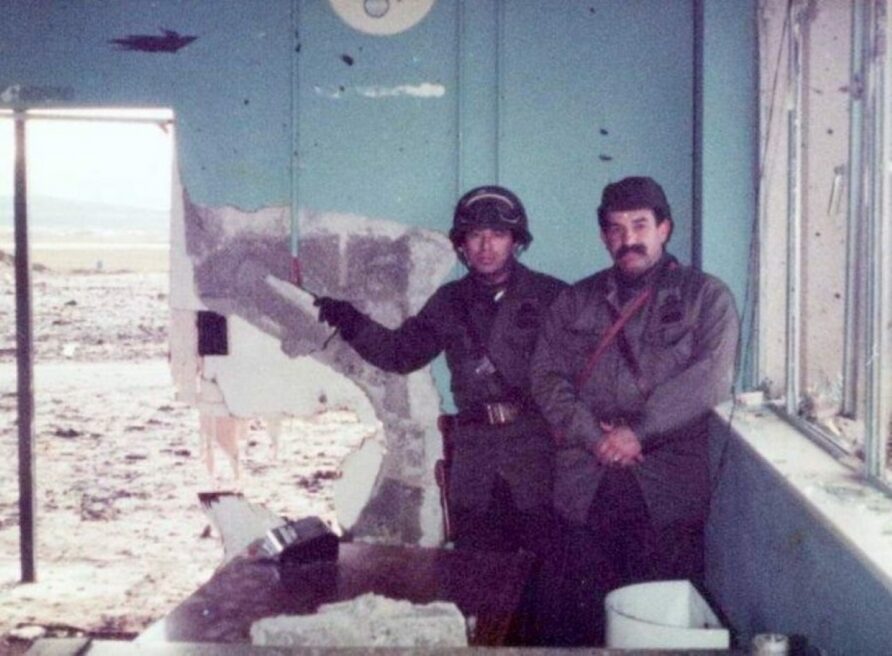
But, at least, the defending force’s supply of girly magazines survived!
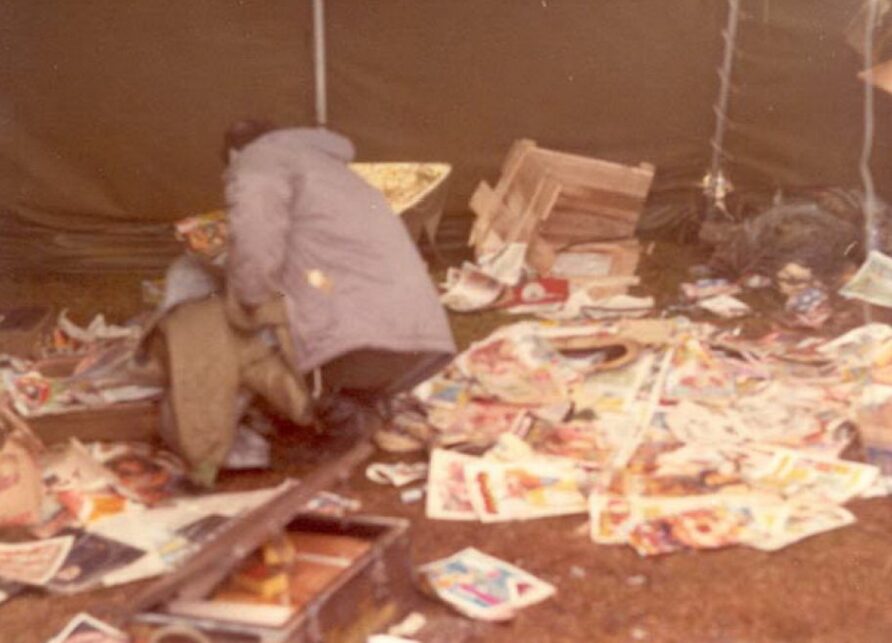
From May 2nd, all resupply flights to Stanley Airport were conducted at a low level and in radio silence and visual blackout.
The inevitable cartoon appeared…
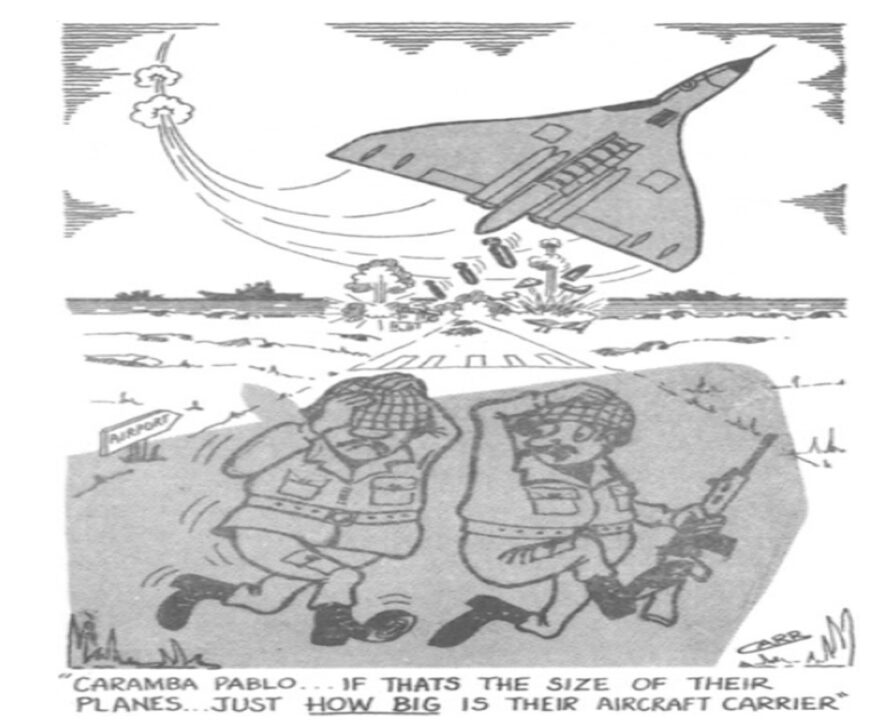
Although not related to the airport, the next day saw the Royal Navy sink General Belgrano with a loss of 368 lives.
On the 3rd, a Skyvan was destroyed at the airport by naval gunfire.
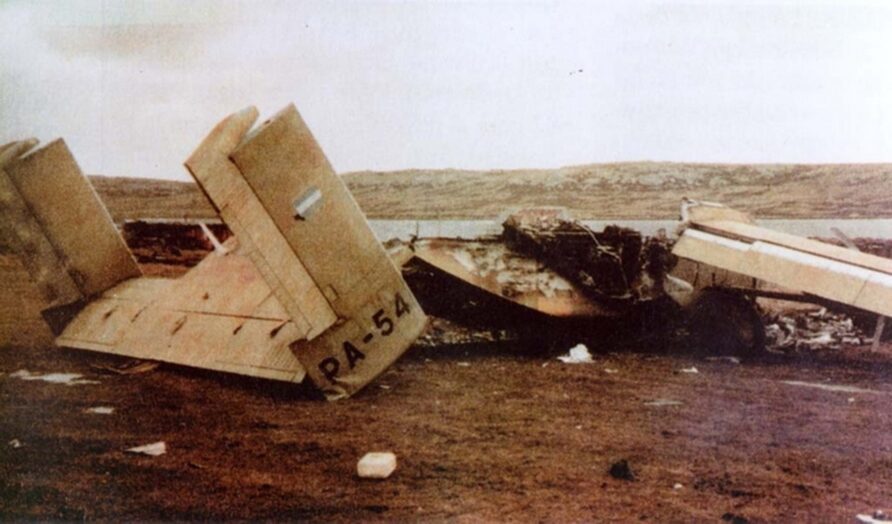
Later that night (early hours of the 4th), Black Buck 2 delivered another load of 21 thousand pounders, the bombs landing to the east of the runway.
A Sea Harrier was lost to enemy ground-based cannon gunfire near Goose Green.
Two Sea Harriers were lost in what is assumed to be a mid-air collision in thick fog on the 6th, and Argentine forces struck HMS Sheffield.
On the same day, another Skyvan was lost in an accident whilst trying to take off.
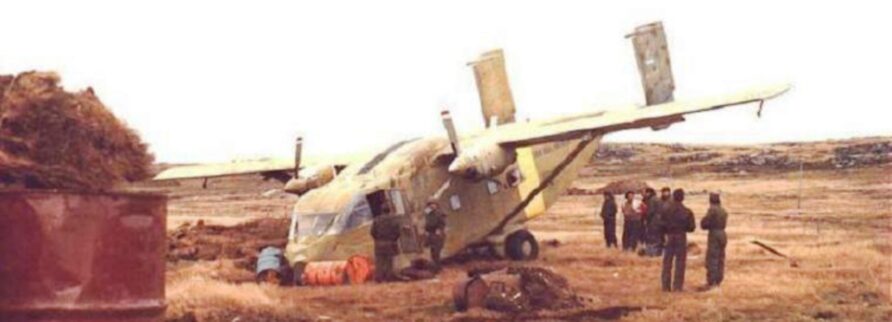
On May 7th, the Total Exclusion Zone was announced, any Argentine warship or military aircraft found more than 12 nautical miles from the coast would be liable to attack.
During the first couple of weeks of May, despite the intense start to the conflict, diplomatic efforts to bring the conflict to an end would continue.
Positions around the airport were attacked with naval gunfire on the 9th and 10th, and the first blockade running transport mission into Stanley took place on the 15th
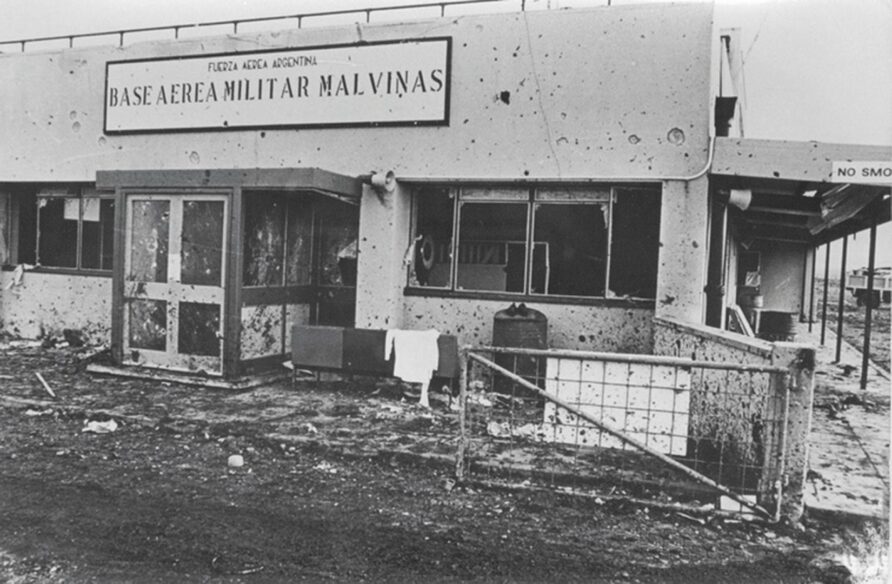
A FIGAS Beaver was damaged on the 10th
Sea Harriers attacked the airport on the 15th, 16th, 17th, without significant effect and also on the 17th, a Fokker F-28 flight brought in equipment and evacuated wounded personnel.
Back Buck 3, against the runway at Stanley, was aborted due to severe weather.
On the 18th, the Harrier GR.3’s joined the task force from the Atlantic Conveyor.
OPERATION SUTTON commended on the 21st, the landings as San Carlos. Launching from Stanley Airport, the first attack on the ships in San Carlos water was from an MB339 (4-A-115), piloted by Lt Guillermo Crippa.
For this extremely heroic lone attack, he was awarded Argentina’s highest award for valour.
A damaged Skyhawk attempted an emergency landing at Stanley Airport, but a damaged left undercarriage forced him to eject safely nearby.
The pilot was rescued by an Army UH-1 (AE-424).
On the 23rd, another Sea Harrier attack on Port Stanley Airport was marred by the accidental loss of a Sea Harrier.
The 24th would see the first Sea Harrier and Harrier GR.3a attack on Port Stanley Airport, but fusing issues meant that those that hit the runway failed to detonate.
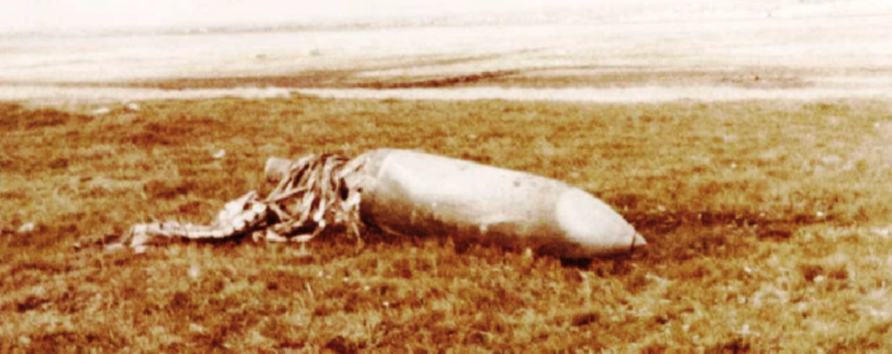
On the 24th, 4 Harrier GR.3’s and two Sea Harriers launched another attack against Stanley Airport.
The Sea Harriers performed defence suppression by tossing 1,000-pound bombs 45 seconds before the GR.3’s arrived to target the runway with their 1,000-pound retarded bombs.
One Pucara and one helicopter were damaged during the attack, with some minor damage to the runway.
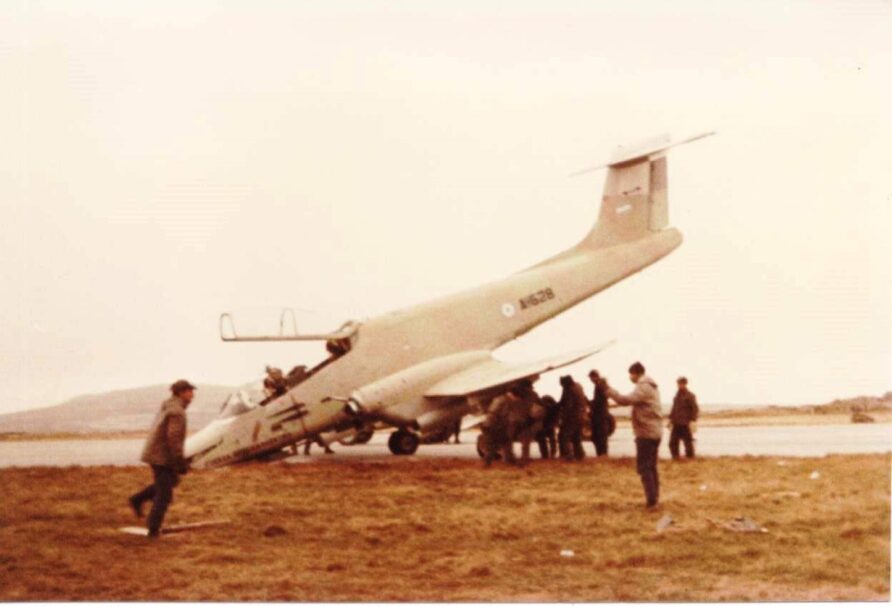
Future attacks against the runway used high angle attacks to achieve desired penetration.
From Wing Commander Peter Squire’s diary;
At midday a mission was tasked as a six aircraft attack on the runway at Port Stanley Airfield. Each pair of GR.3s was led by a Sea Harrier.
The 1(F) pilots flying the mission were Wg Cdr Squire, Sqn Ldr Pook, Sqn Ldr Harris, and Flt Lt Rochfort. The attack was carried out with the GR.3s formatting on Sea Harriers in loose vic formation for a simultaneous release of bombs.
Following the release of his weapons, Sqn Ldr Pook climbed into the airfield overhead to observe ‘fall of shot’. Bombs from the first three aircraft were seen to impact on the West end of the airfield whilst those from the second wave fell approximately 100 yards north of the Eastern threshold.
Whilst in the overhead, Sqn Ldr Pook was locked up by Roland and saw the missile in flight. It peaked at about 15,000ft – some distance below him. He also saw a Tiger Cat launched against the second wave; this too fell short.
Sqn Ldr Harris and Flt Lt Hare later carried out a further similar mission to drop free-fall 1,000lb bombs against Port Stanley Airfield runway from a level delivery at 20,000ft.
The bombs were dropped singly, but aiming for this method of delivery is imprecise, the fall of only 3 bombs being seen and these fell in Yorke Bay.
Harris and Hare both saw AAA and Roland fired during the attacks but their aircraft remained out of range.
Sqn Ldr Harris flew a final late singleton mission to carry out a further medium-level bombing of Port Stanley Airfield runway but owing to the weather, this was changed to 30-degree loft. All 3 bombs fell short of their target
On the same day, laser-guided Paveway II bombs were airdropped to the fleet by RAF C-130 Hercules aircraft and Flt Lt Glover was transported to Argentina aboard a C-130, from Stanley Airport.
On the 25th, another set of sorties was launched against Stanley Airport, two Sea Harriers and four GR.3s.
This time, the bombs were dropped from 20,000 feet (ca. 6 km), none of them hit the runway, some falling into Yorke Bay. The last sortie was forced to release at medium altitude, again, none hit the runway. Roland and Tiger Cat missiles were launched against the attacking aircraft.
It was thought at this time that an arrestor gear system had been deployed to Stanley Airport to support the Super Etendard or Sky Hawk.
The day after, a Fokker F-28 flight to Stanley airport was completed and another sortie against Stanley Airport was attempted.
Three sorties against British forces at Goose Green were launched from Stanley airport throughout the 28th using Pucara and MB339, 3 Pucara and MB339 were lost.
The day after, two flights of Fokker F-28’s and one Electra flew into and out of the airport.
On the 31st of May, following a visual sighting by a Sea Harrier of a ‘swept-wing aircraft, possibly Etendards’, two GR.3’s and Sea Harriers were launched. No such aircraft was found, and it is thought likely they were the Aermacchi.
A single Fokker F-28 flew into and out of Stanley Airport.
Black Buck 5 was executed against radar installations in Port Stanley, to little effect.
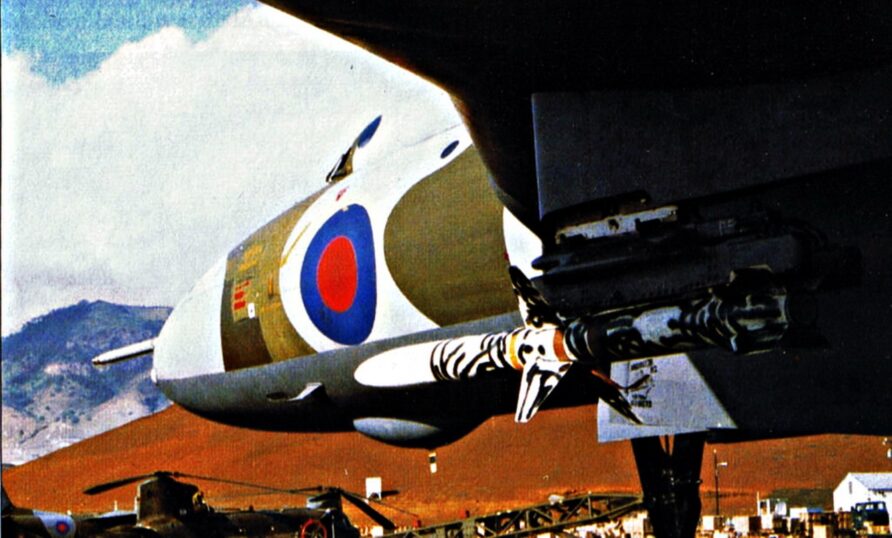
On the 1st of June, a C-130 (TC-63) was shot down.
The same day also saw a Sea Harrier from 801 NAS shot down with a Roland missile near Port Stanley. A helicopter and Pucara were launched from Stanley Airport to locate the pilot who had ejected, but were unsuccessful. He was rescued later by a Sea King of 820 NAS.
The 2nd saw an F-28 flight into and out of Stanley Airport and the day after, Black Buck 6, also against mobile radar.
This time, it was more successful and managed to damage the Skyguard radar and kill three personnel.
The day after, two MB339’s were flown back to Argentina from Stanley Airport. Between the 8th and 12th, several F-28 flights were completed. An Argentine C-130 also flew in a number of trailer-mounted Exocet missiles on the 11th and, following some excellent improvisation, were used against HMS Glamorgan on the 12th
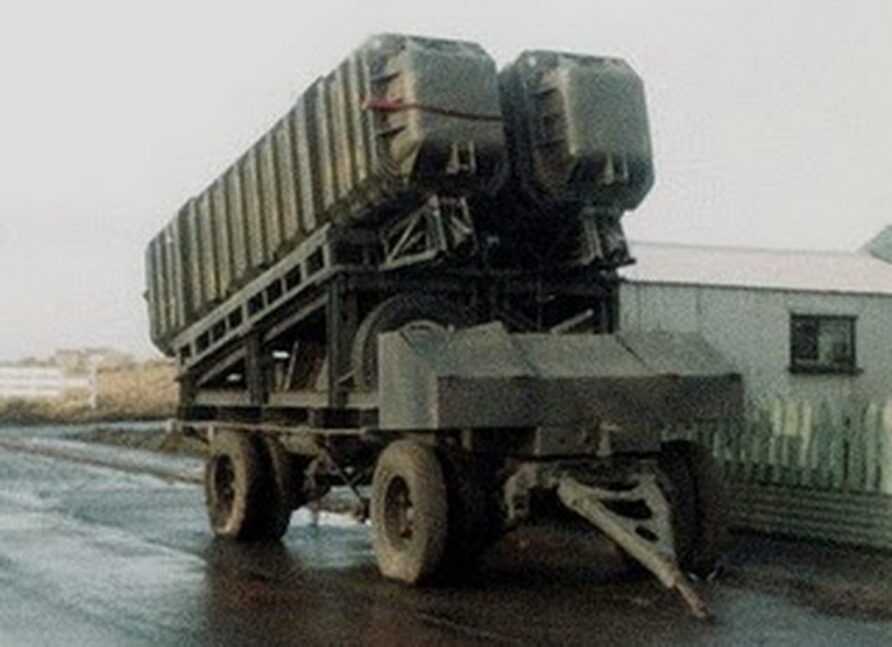
Black Buck 7 was mounted against stores and aircraft at the eastern end of Stanley Airport.
The final supply flight by C-130, carrying 155 mm ammunition, was flown into and out of Stanley Airport, the night before the surrender of the Argentine forces on the 14th.
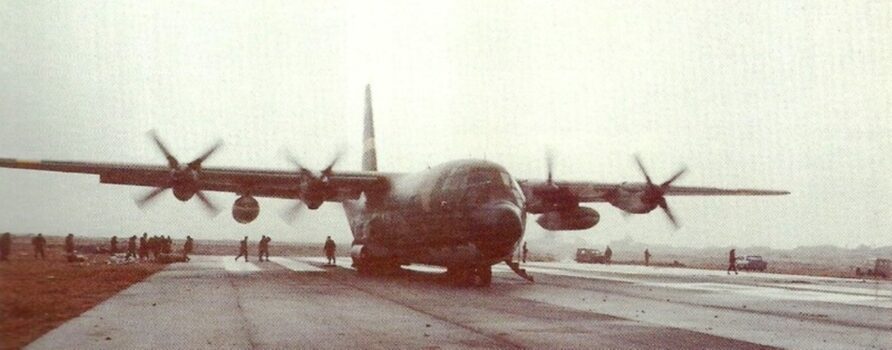
All three privately owned Cessna light aircraft at Stanley Airport were destroyed during the attacks.
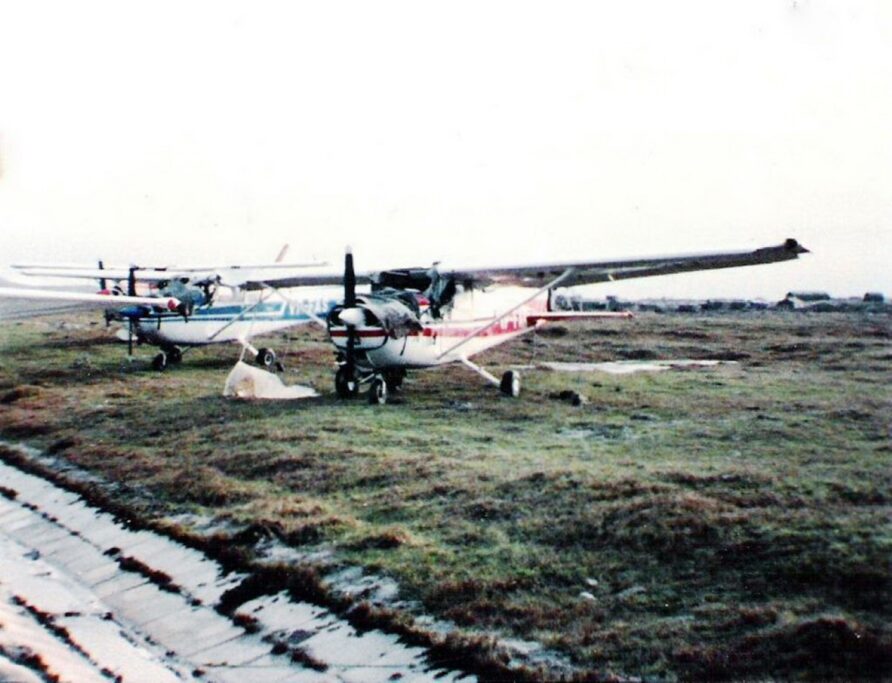
At the cessation of operations, Stanley Airport had suffered three Vulcan strikes, nine multi-aircraft attacks by Sea Harrier/GR.3 and many attacks using naval gunfire.
The total munitions expended included 50 one thousand pound bombs, 135 five hundred pound bombs, many cluster bombs and over 1,000 4.5″ shells from Royal Navy vessels.
The garrison (25th Infantry Regiment and School of Military Aviation Security Company) suffered only three casualties, but there were reportedly significant casualties in other units at the airport.
The airport itself remained operational throughout the conflict, the F-28 force alone managing to transfer over 500 tonnes of supplies and hundreds of personnel.
Between May 1st and June 14th, the C-130(H)’s of the FAA completed 31 flights into Stanley Airport, carrying 514 passengers and 434 tonnes of supplies in addition to evacuating 264 wounded personnel.
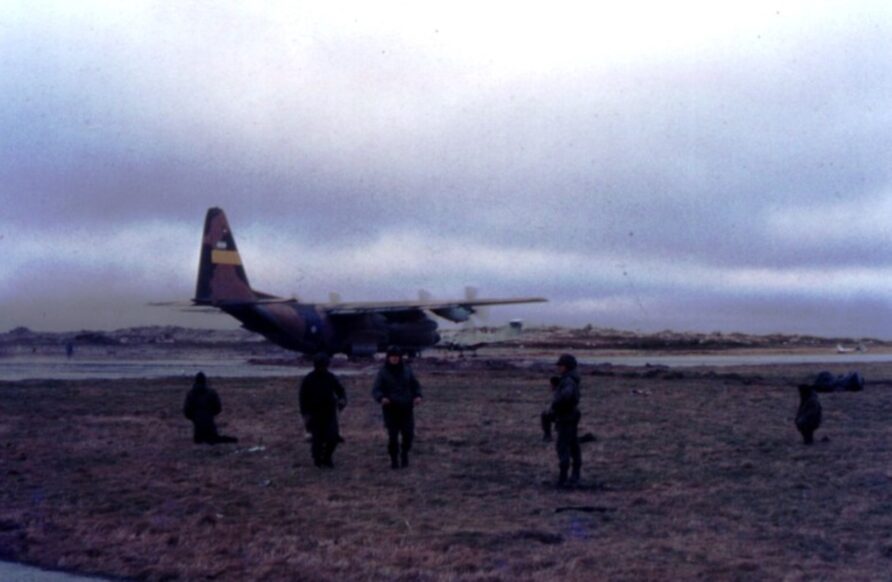
Both Hercules and F-28 flights would be carried out at night and time spent on the ground were minimised.
Post Conflict
There is a persistent myth that the Argentine forces were a bunch of frightened, underfed and ill-equipped conscripts with no clue of their business.
Nothing could be further from the truth.
Their equipment, often, was superb, in part, much better than that enjoyed by British forces. Defensive positions were well sited and constructed, they had made excellent use of visual deceptions and the radar and ECM equipment were not only extensive but exceptionally well operated as well.
Many were volunteers, thought that right was on their side and fought with great skill, determination, and gallantry. They were not short of most things, there were ample rations, ammunition and equipment, it was just poorly distributed which meant there were many local shortages outside Port Stanley, especially of food.
However, the rift between the officer/SNCO and other ranks was enormous, logistics were inconsistent and several exhibited behaviour that could be reasonably be considered a war crime. At the end of the day, they had no effective campaign plan because, quite simply, they did not expect such a resolute response.
The best soldiers on the planet, sailing 8,000 miles across the open ocean, supported by equally fine air and sea forces, with firm intent, fighting skill, discipline, and centuries of tradition behind them was simply not within their range of expectations.
The occupiers were a spent force.
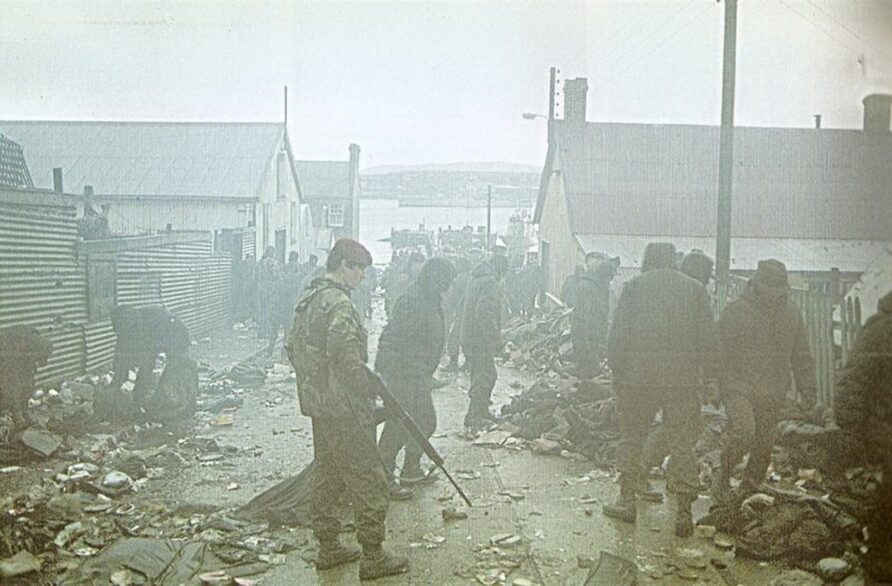
Following the surrender of the Argentine forces, it was now time to consolidate and prevent a rematch.
Although Argentina had accepted the Instrument of Ceasefire they only recognised this locally, there was no wider recognition of the cessation of hostilities so although they were down for the count, the British government recognised that the nature of the unfinished business needed sensible and sturdy consolidation.
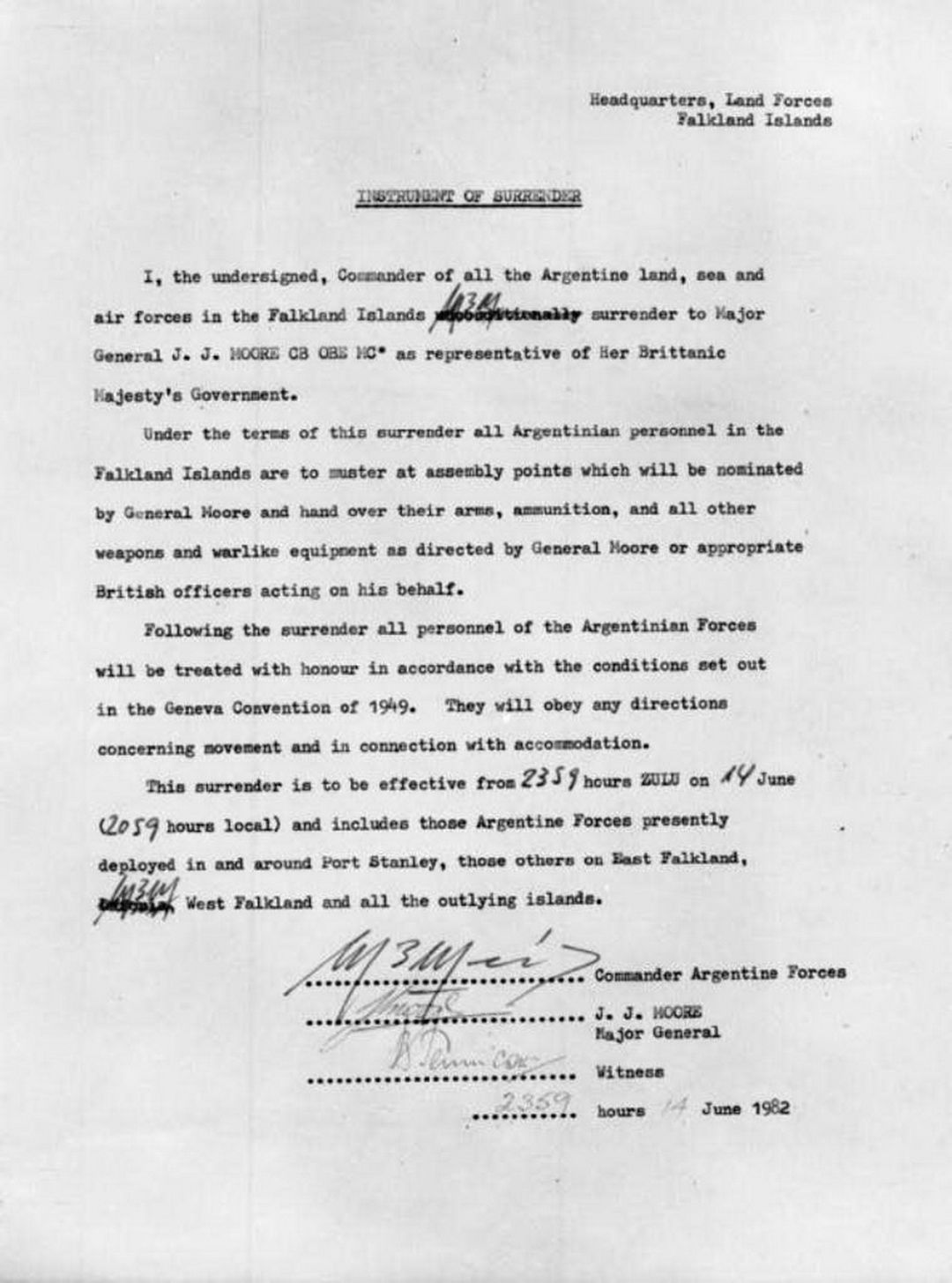
Unfortunately, the scale of the other problems facing both the victorious military forces and the civilian inhabitants of the Falkland Islands was immense, there were many priorities, each one of them, number one.
Disposal of the detritus of war, getting the defeated Argentine forces home safe and well, restoring damaged or destroyed utilities, keeping everyone fed and watered, rotating British forces out of the theatre, satisfying the demands of the world’s media and basically getting the islanders back to some semblance of normality all competed with rehabilitating the airport.
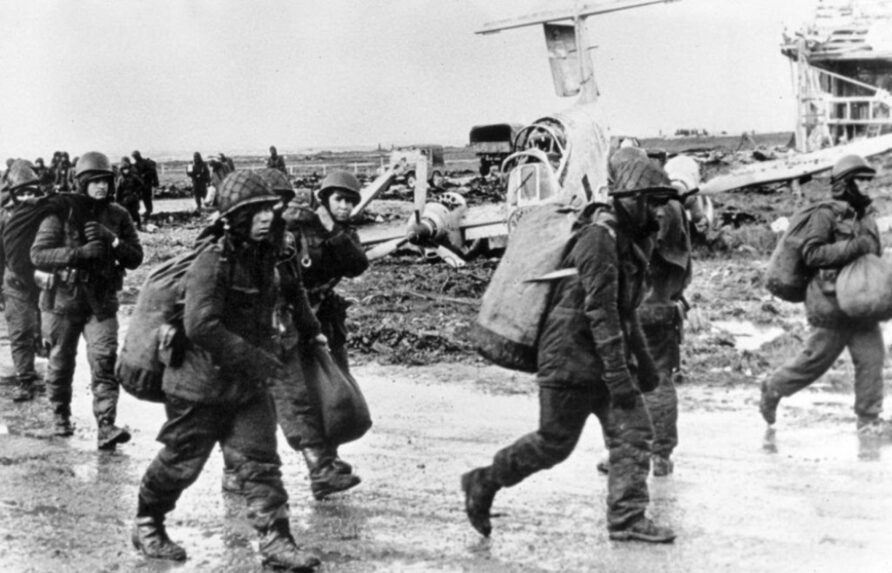
That said, commanders were entirely focused on the airport facilities, it might have been competing with other resource demands, but it was generally beating them as well. Unlike the Argentine forces, we recognised the strategic value of air defence from the islands.
For several weeks, there was also a real fear that elements of the Argentine forces might try an armed publicity stunt.
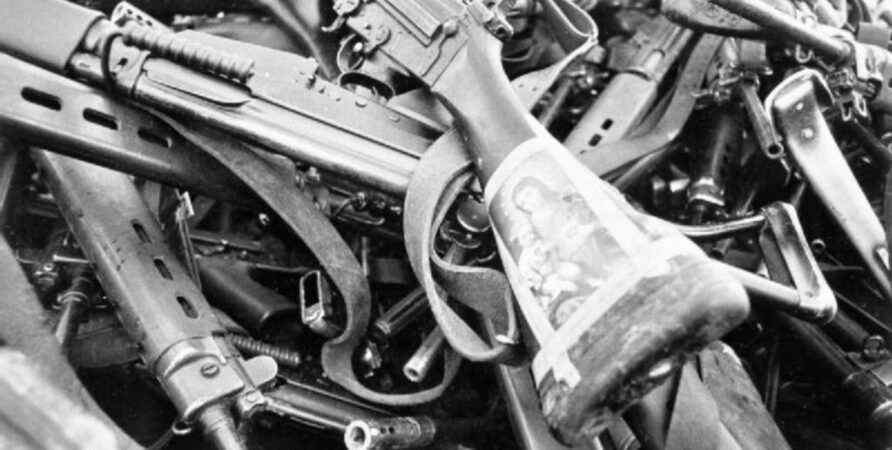
Whilst there might have been some professional respect for the Argentine forces, despite several examples of conduct that fell far short of acceptable, and pity for their plight, much of this evaporated when the extent of damage to Stanley and the degree of booby traps in an area full of civilians became apparent.
Argentine forces had deliberately set many complex booby traps in the latter stages of the conflict in civilian houses and places of business. These were often linked to attractive items like boots, binoculars, or thermos flasks and many of the discarded munitions were also booby-trapped, some even attached to propane cylinders.
Water supply in Port Stanley was always a problem, Argentine forces even turned all the taps on in houses they occupied and opened fire hydrants. This was in addition to Argentine personnel deliberately treating almost every room in some houses as a latrine.
A vast quantity and variety of mines had been laid, and not just in out of the way locations.
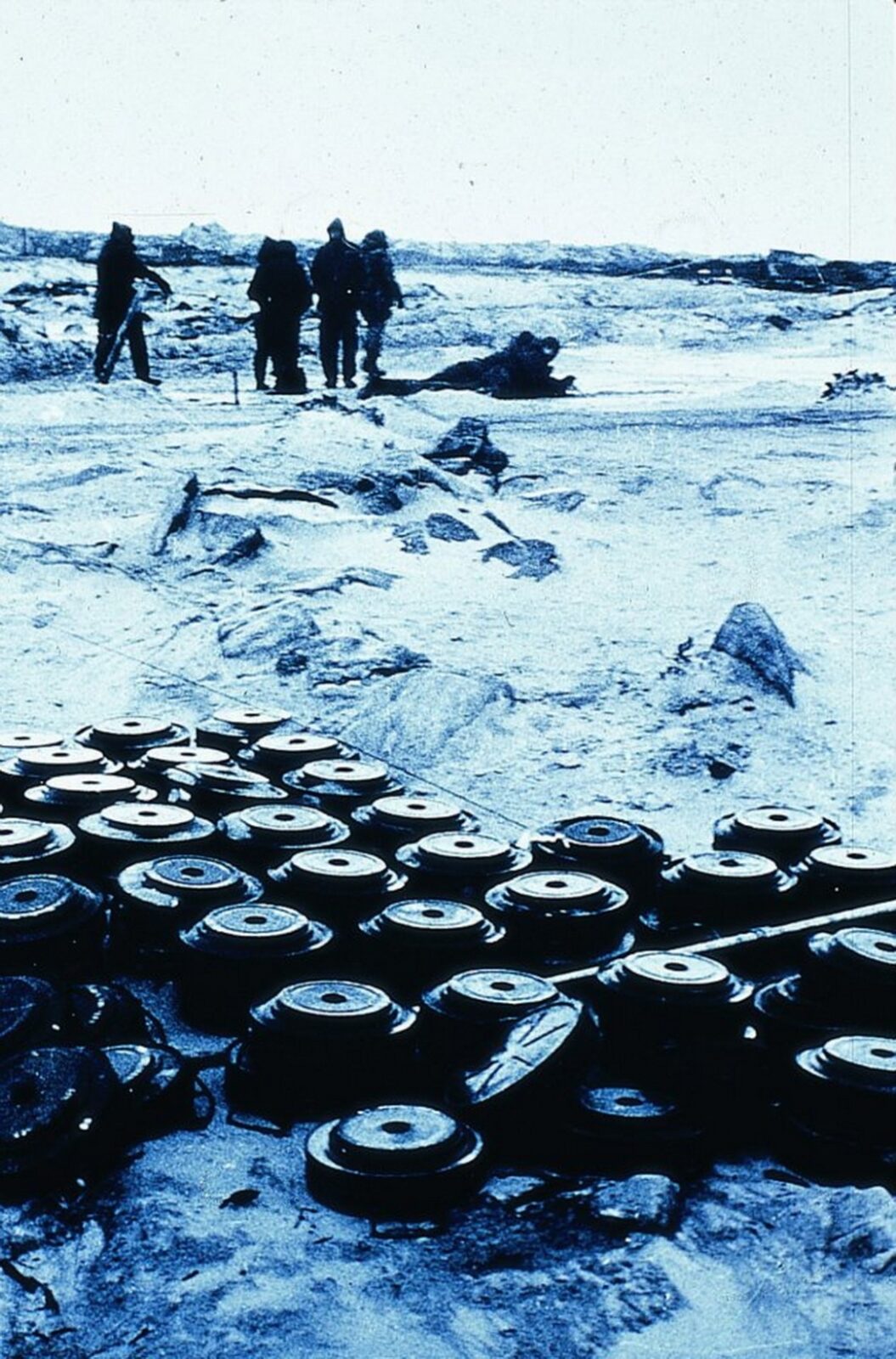
The hazard to civilians (especially children) and service personnel was enormous.
On June 14th, Major Roddy McDonald, the OC of 59 Independent Squadron Royal Engineers, managed to track down the Argentine chief engineer, one Lt. Col Dorago, to assess the scale of the mine problem.
Other personnel from 59 joined in, a warning was broadcast on local radio and through the military chain of command, and fourteen selected Argentine volunteers were utilised to complete the recce.
By the end of the day, the full realisation of the scale of the Argentine mining and booby-trapping efforts had become apparent.
It was staggering.
They simply did not know how many or where mines had been laid, records were incomplete or incorrect, markers had been removed and mines had shifted in peat and deep sand.
The problem was worsened because the Argentine chain of command allowed almost any unit to lay mines, marines, artillery, and all manner of infantry units, not just the professional combat engineers.
After several casualties, the initial clearance effort changed to one of ‘marking only’
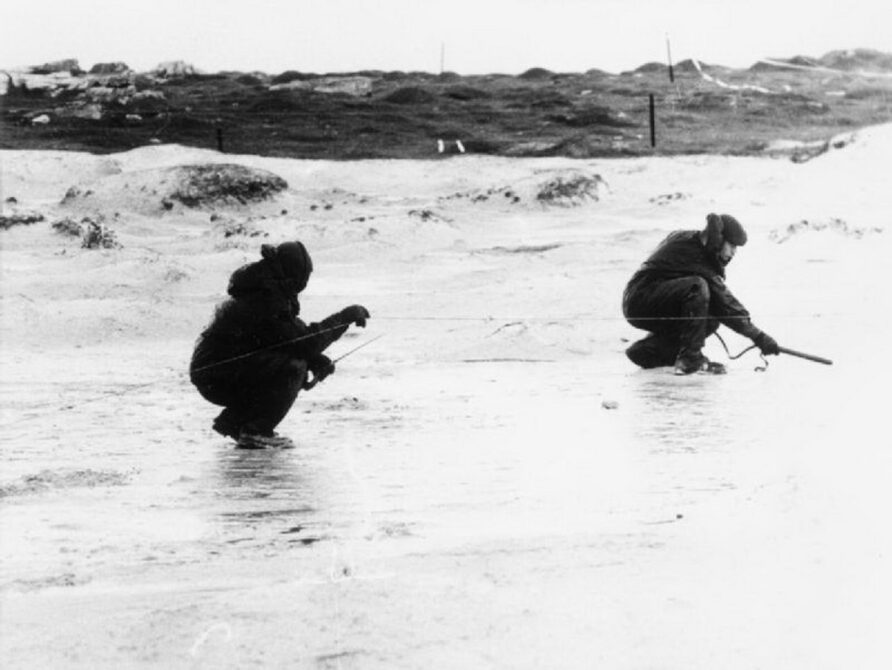
The POW volunteer force of Argentine combat engineers expanded, formed a close working relationship with British forces, and received special privileges and pay not enjoyed by other POWs.
A joint guard of honour and bugler were provided for the burials of Argentine soldiers discovered during the clearance operations and in thanks for the rapid Medevac and treatment of an injured Argentine member of the demining team, they paid for and cooked a barbecue for British members of the team and OC of 9 Parachute Squadron RE.
9 PARA left for the UK on the 17th July and were replaced in the mine clearance role by 69 Gurkha Independent Field Squadron RE.
Desalination equipment was lost on the Atlantic Conveyor, as well as tentage for five thousand personnel, exacerbating the problems. 9 Squadron and 61 Field Support Squadron RE managed to get water supplies running after four days, and this was supplemented with water dracones towed into Port Stanley harbour.
In addition, to mines and booby traps, an equally huge problem was that of unexploded munitions of every kind. Everything from small arms ammunition to napalm canisters to anti-aircraft missiles to flares was strewn around the area, half-opened and often poorly accounted for.
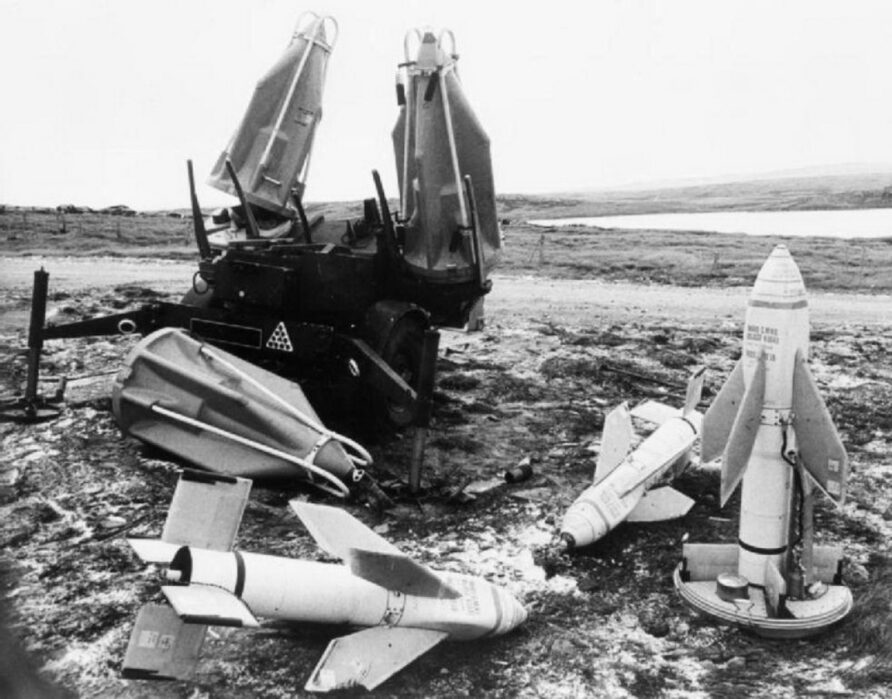
‘Dumdum’ small arms ammunition was found in addition to a large stock of SA-7 MANPAD missiles fresh off the plane from Col. Gaddafi.
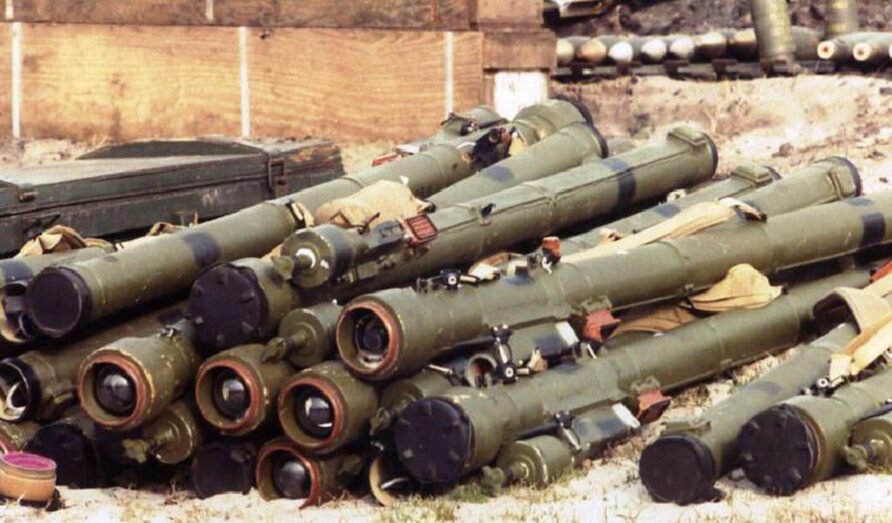
Grenades, flares, rockets, cannon shells, mortar bombs, small arms ammunition, aircraft bombs, missiles, napalm, and artillery ammunition all needed to be tackled.
Unboxed ammunition was recovered to the UK but anything else was made safe and destroyed by a combined Royal Navy, Royal Army Ordnance Corps, Royal Engineers and Royal Air Force team of EOD specialists.
The area of Stanley, a town that normally supported about 800 people, was no home to ten thousand POWs, about five thousand UK military personnel, and, of course, the permanent residents.
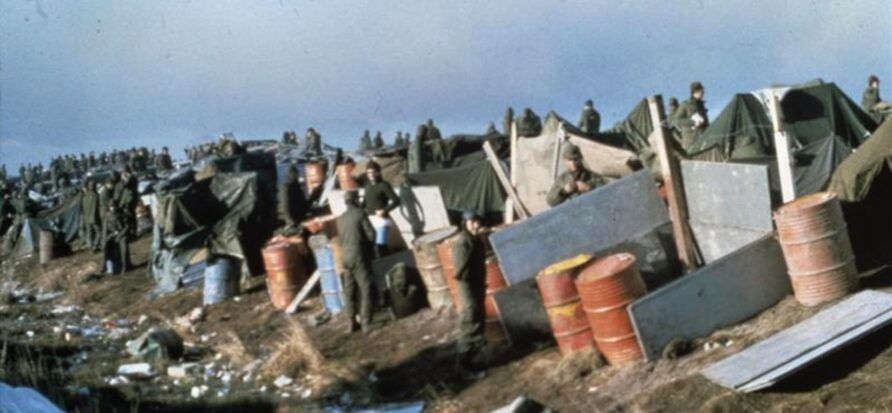
And all this was before the problems of the airport had been addressed.
There were three broad objectives for the British Forces concerning air operations.
ONE; Re-establish basic air operations at Stanley Airport such that they could support Harrier and Hercules aircraft. This would allow much of the task force, especially the aircraft carriers, to return to the UK, and replacement forces to arrive quickly.
TWO; Extend and reinforce Stanley Airport to allow the Harriers to depart and be replaced with Phantoms.
THREE; Select a suitable location for a large military airfield that could support all current and future combat and transport aircraft.
Phase One — Establish Operations at Stanley Airport
Stanley Airport, formerly BAM Malvinas, was in an equally poor state as Port Stanley.
The image below, reportedly taken the day after the surrender, shows Stanley Airport, and the famous dummy crater.
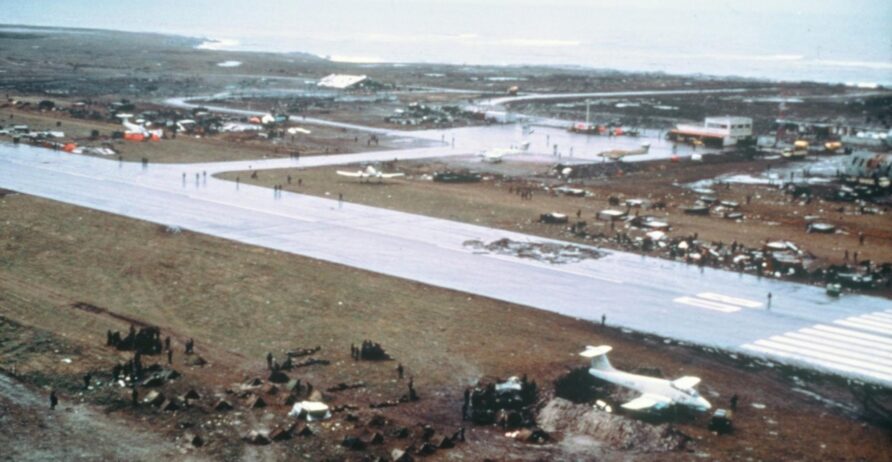
Clearance
The first task was to conduct a survey and make safe any exploded munitions, booby traps and mines, of which there were plenty.
This task would fall to both the Royal Engineers and Royal Air Force EOD teams. No.1 Bomb Disposal Group RAF would play a considerable part in clearing Stanley Airport of unexploded munitions, but that had a difficult start to the campaign. On the 27th of March, they boarded RFA Sir Bedivere with all their vehicles and equipment but when loading had been completed, were ordered off again.
Another four-man team clearing unexploded cluster bomblets from the West Freugh range in Scotland had been killed, and the embarked team were disembarked to complete the task. The team would eventually join the task force by being flown to Ascension Island to catch up with Sir Bedivere.
The team cleared munitions in San Carlos and Goose Green, especially the leaking napalm canisters and mines at Goose Green.
By the time the team had finished its deployment, it had cleared over 900 unexploded bombs, numerous mines and booby traps and tonnes of napalm.
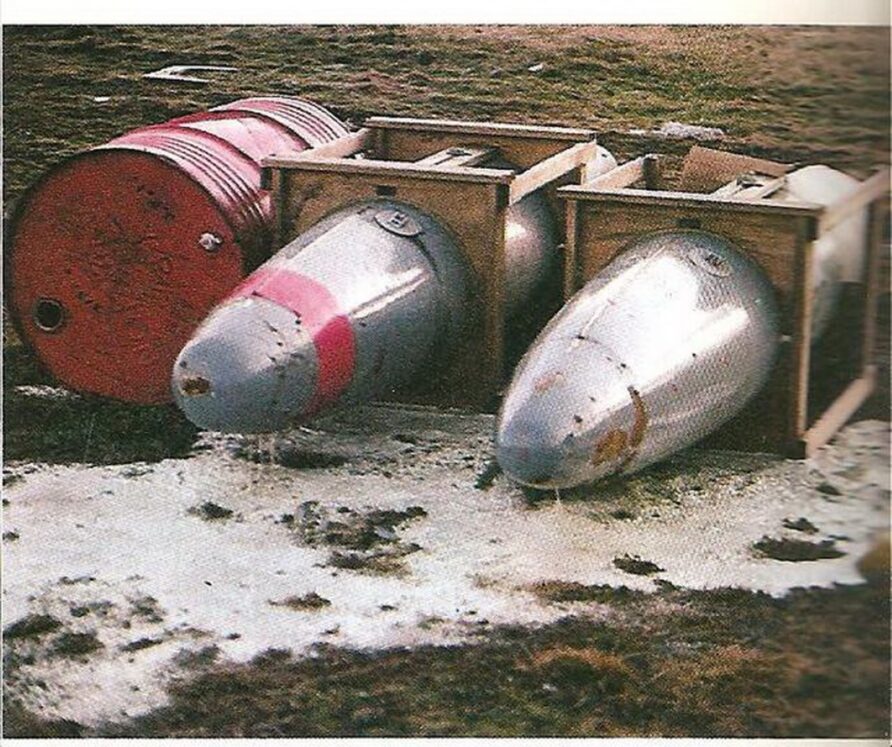
The Argentine aircraft that were left at Stanley Airport were also cleared of booby traps, munitions removed and to prevent accidents by the ever-present ‘trophy hunters’
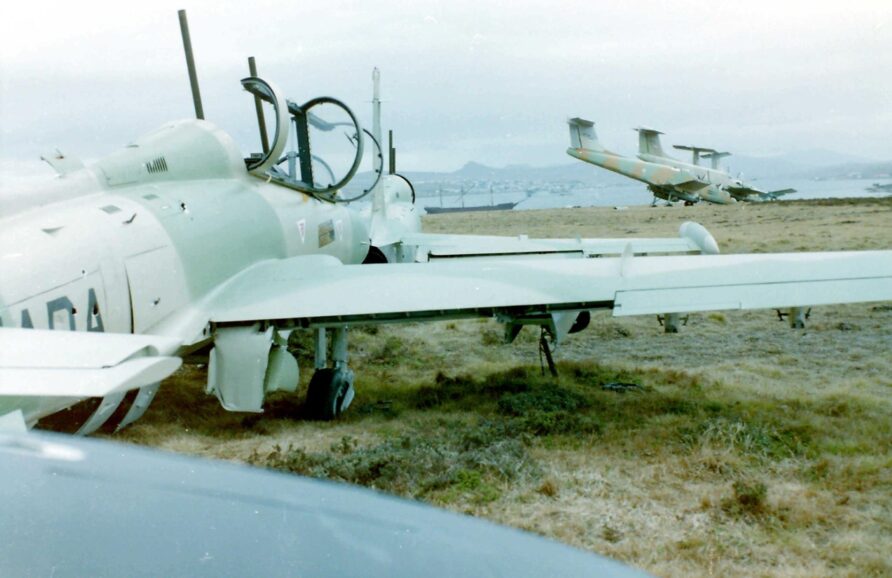
The ejection seats were removed (firing the ejection seats was also used to initiate booby traps)
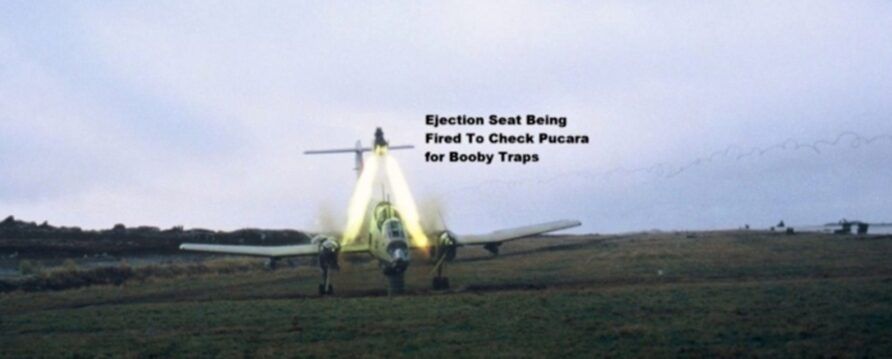
Once made safe, aircraft were then moved to an assembly area for eventual disposal
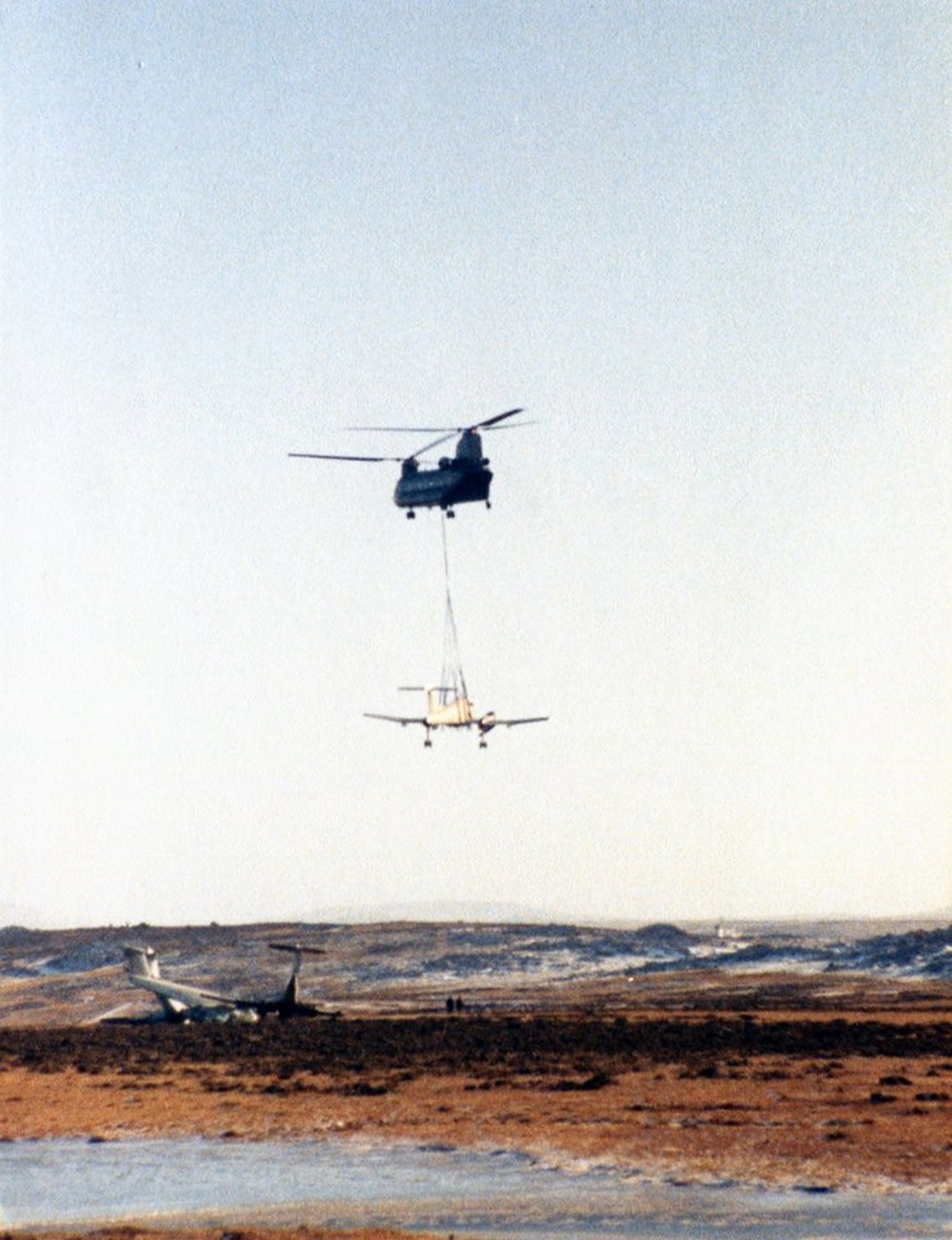
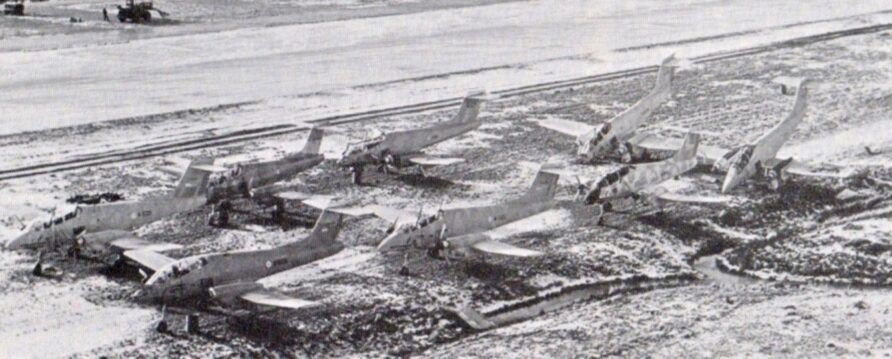
Several PoWs volunteered to remove none explosive debris and sweep the runway after they assumed that such endeavours would earn them a priority ticket home, quite how they came to this belief has never been determined!
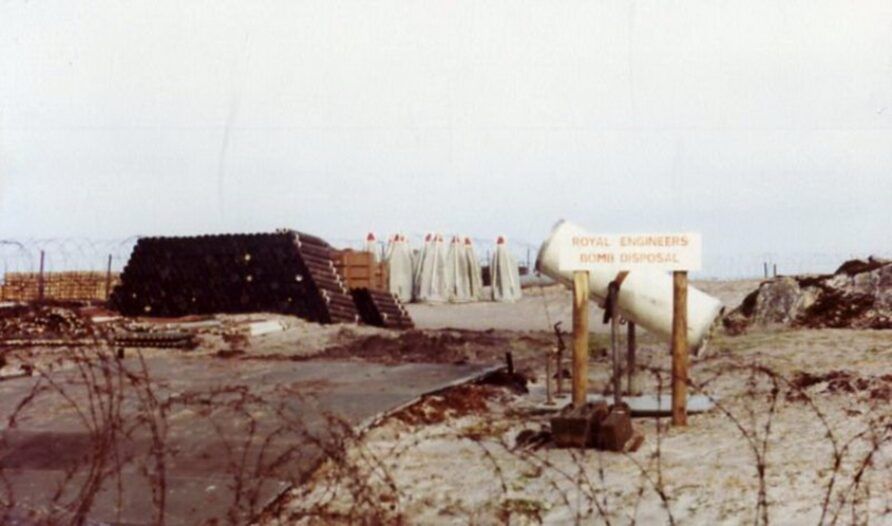
Several Exocet missiles were also found, the canisters of which would be used later.
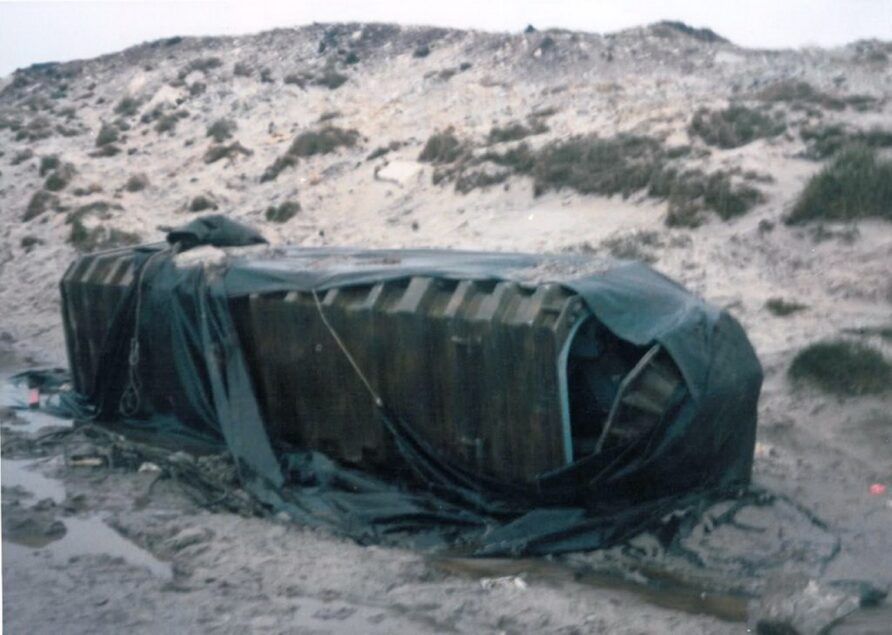
The BAM Malvinas sign was repositioned.
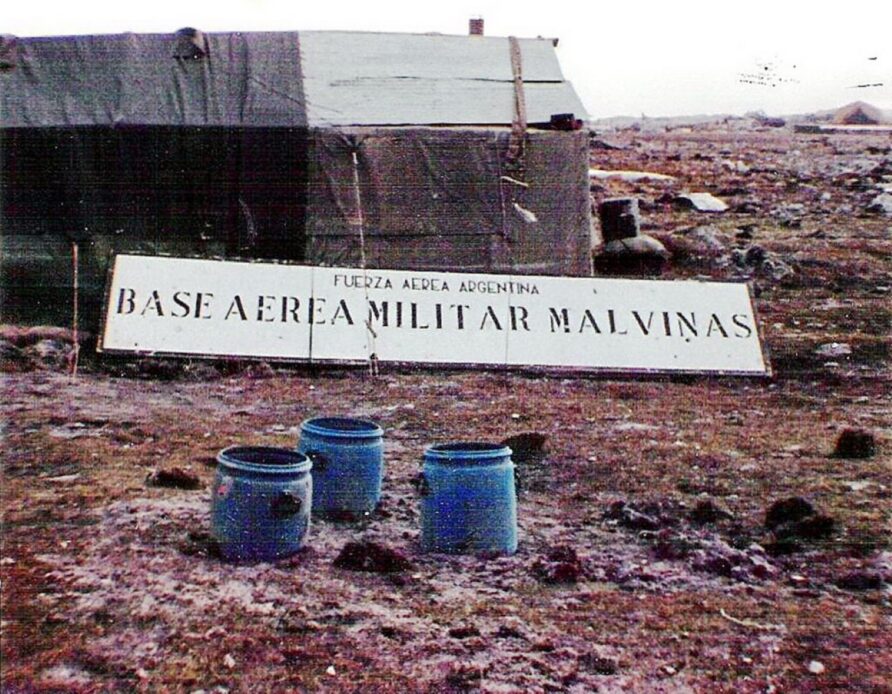
Making Good the Runway
During the conflict, 5 bombs cratered the runway.
The first and deepest was from Black Buck I and the others were much shallower, from retarded bombs dropped by the Sea Harriers/Harrier GR.3a’s.
There were also over 1,000 shallow scabs from rockets, BL 755 bomblets, 4.5” shells and cannon fire.
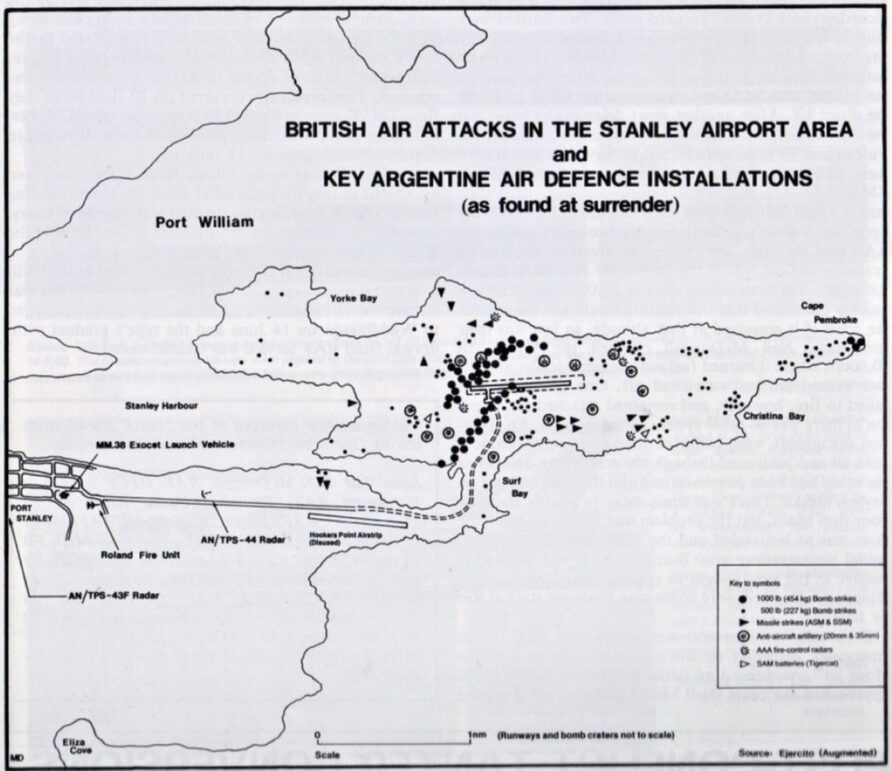
59 Commando Squadron Royal Engineers (with a troop from 20 Field Squadron) filled in three craters and about 500 of the scabs on the Northern half of the runway, the repairs were made by using magnesium phosphate cement called Bostik 276.
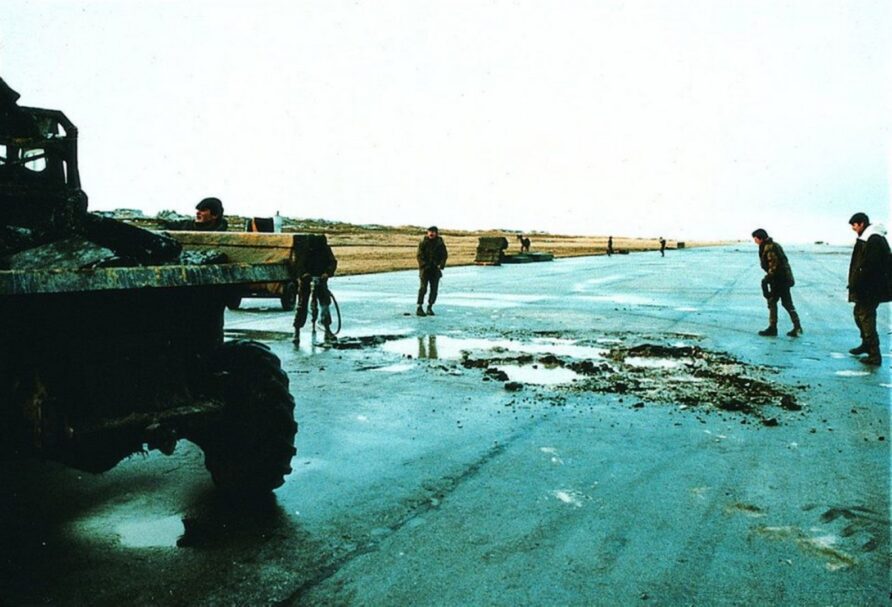
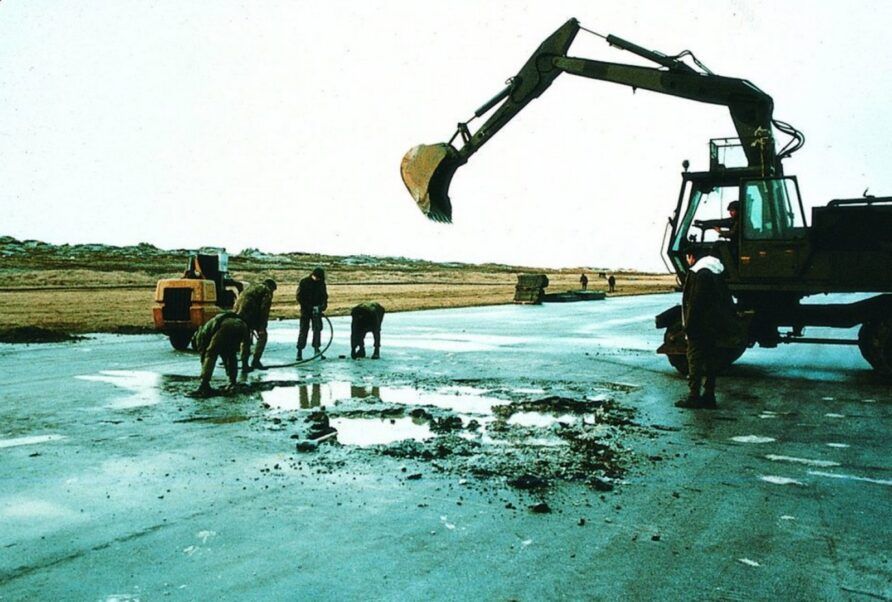
The thousand-pound bomb craters on the runway were backfilled and a quantity of AM-2 repair matting was used to cover them.
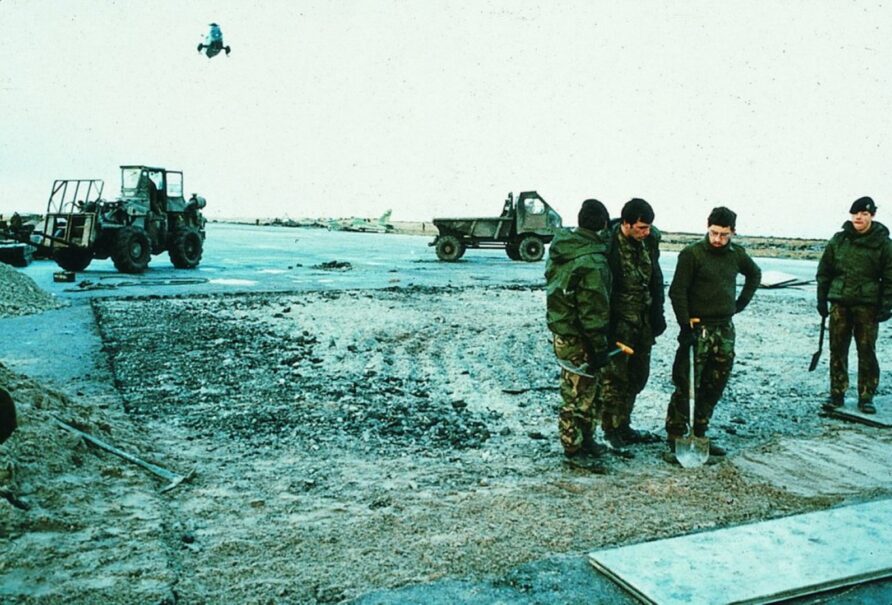
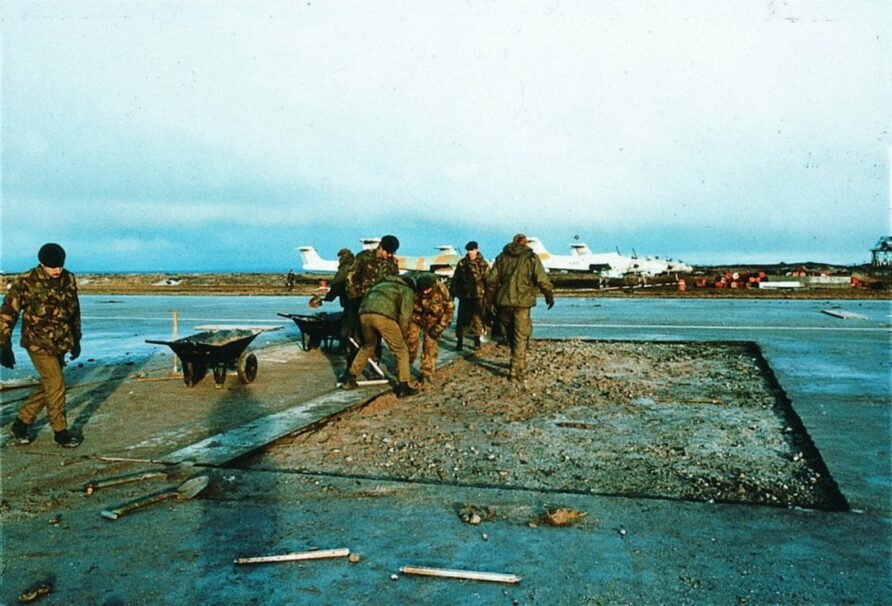
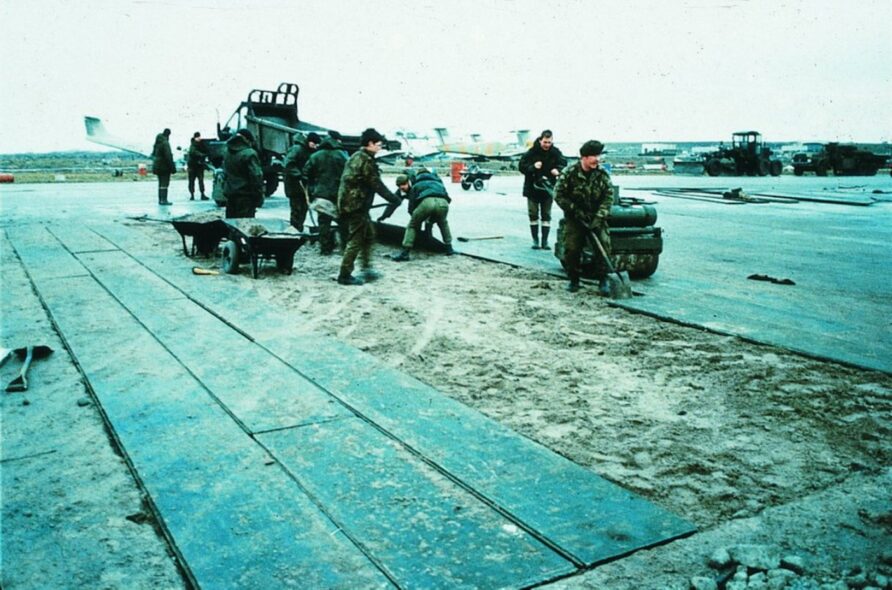
It was also discovered that Argentine engineers had used filled oil drums to fill the Vulcan crater, these were removed.
This allowed the runway to be used for planned Hercules flights.
The first RAF Hercules landed on the 24th of June 1982, ten days after the surrender, a magnificent, and generally unrecognised achievement.

Harrier Operations and Airport Development
Using PSA-1 from the Port San Carlos FOB and a quantity of AM-2 matting left at the airport, a short parallel runway, to the north of the main runway, was also created for use by Harriers.
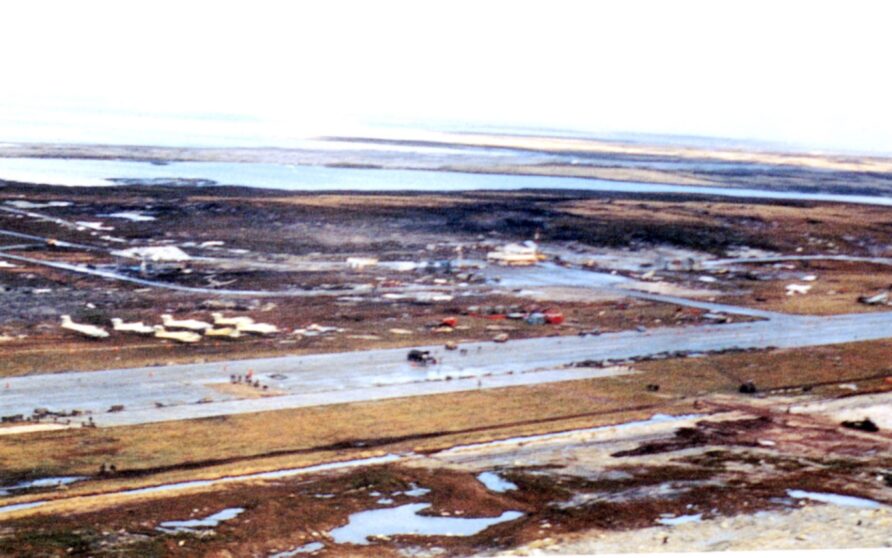
The RAF Harrier GR.3 detachment, armed with Sidewinders, went ashore to Port Stanley Airport on the 4th of July and operated in the air defence role.
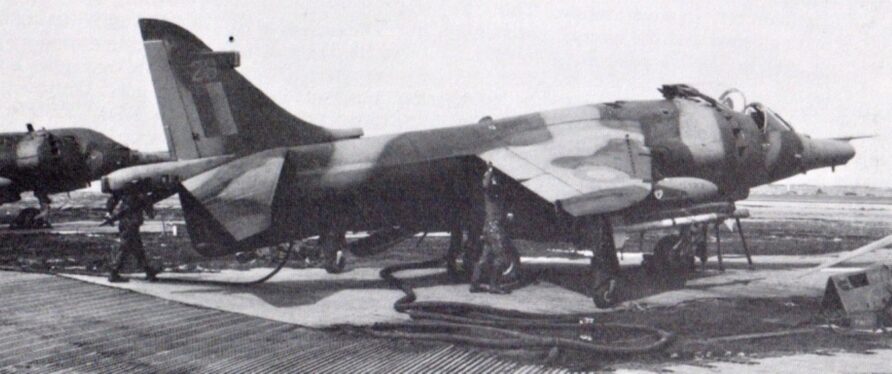
A number of Rubb shelters were installed to provide sheltered maintenance spaces, but the weather was so severe, a number were dislodged and damaged aircraft.
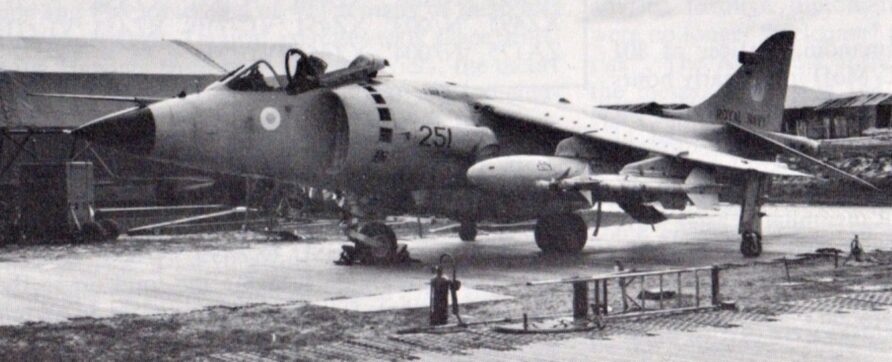
11 Field Squadron Royal Engineers also supported the repair effort and as can be imagined, the tasks were extremely varied. Not widely known is that to create a drainage culvert, the engineers used a pair of empty Exocet missile containers.
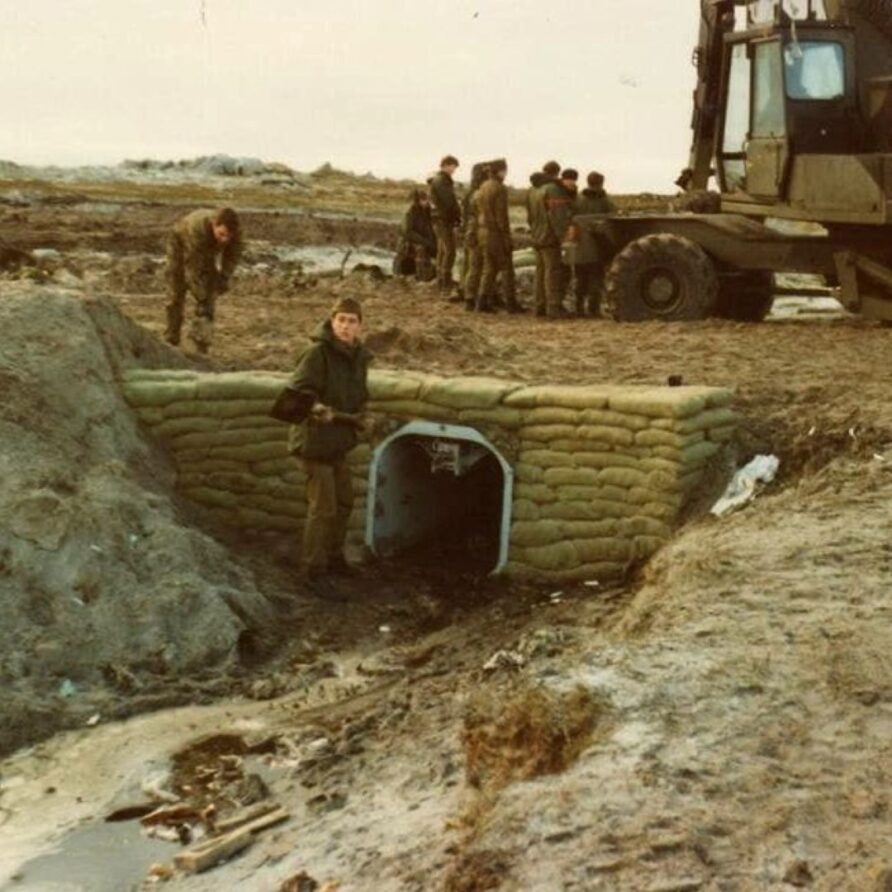
In addition, to the runway, the airport support facilities were enhanced greatly, and the sign was changed as well.
The RAF’s 259 Radar Detachment were embarked with their equipment on the STUFT vessel St Edmund on the 20th May 1982. A couple of days after surrender, they came ashore and started work on assembling a mobile radar and TACAN navigation system.
These facilities were then extended and replaced with additional facilities installed at Windy Ridge.
These temporary repairs accommodated 77 Hercules and many hundreds of Harrier sorties before the runway was closed for a more permanent repair and extension on the 15th of August, three weeks after the first Hercules landed.
Phase Two — RAF Stanley
The initial repairs had not repaired the southern half of the runway width and whilst this offered a bare minimum for Hercules and Harrier operations it was not sufficient for anything else.
The runway would need to be properly repaired and extended to support safer Hercules operations and the replacement of Harrier with Phantoms, a much more potent air defence aircraft.
When it became clear that victory would be achieved, the state of the runway at Port Stanley Airport became an issue of serious planning, it would be central to any post surrender defence of the islands. In May 1982, 50 Field Squadron Royal Engineers was given the task of creating an expeditionary airfield at Port Stanley, expectations were, of course, that the Task Force would prevail.
The requirement called for the main runway that would be 6,100 ft (1.86 km) long (from 4,100 ft (1.25 km)), the full width of 150ft (ca. 46 m) and having an LCN of 45 to accommodate fully loaded and fuelled Phantom’s.
In addition to the main runway was a requirement for five Rotary Hydraulic Arrestor Gear (RHAG) sets, sufficient power provision, extensive parking apron, dispersal areas with shelters, roadways, engineering shelters and bulk fuel facilities with a ship to shore pipeline.
Experience with the dispersed air locations supporting the Harrier GR.3 force in Germany was vital, but it also demonstrated to the design team that the UK did not have enough equipment, much of the existing UK expeditionary airfield equipment and stores went down with the Atlantic Conveyor.
The US AM2 aluminium matting system was the answer to the runway problem.
In Washington, the Air Attaché (Air Vice-Marshal Ron Dick) was despatched to obtain a large quantity of AM2 aluminium matting, arrestor gear and other supplies. The United States was exceptionally cooperative and opened up their war stocks. 50 Field Squadron (Construction) arrived on the 14th of July 1982 and established a project office behind the Stanley Airport control tower.
The 17,000 tonnes MV Strathewe arrived at Port Stanley on the evening of the 17th of July at moorings provided by the MV Wimpey Seahorse. Naval Party 2150 and members of 11 Field Squadron Royal Engineers provided the labour for offloading together with the Composite Port Squadron of the Royal Corps of Transport and was completed on the 5th of August.
The MV Strathewe also carried two 150 tonnes RCL’s (L105 Arromanches and L106 Antwerp) and the heavy stone crushing equipment needed for the runway sub base.
The Cedar Bank was unloaded during the same time frame. Because Port Stanley had no permanent berthing facilities suitable for such large ships, they both had to be offloaded whilst at anchor in Port William Sound.
Making this task more difficult was the weather and the shortage of equipment and suitable slipways.
Enter the RCL and Mexeflote.
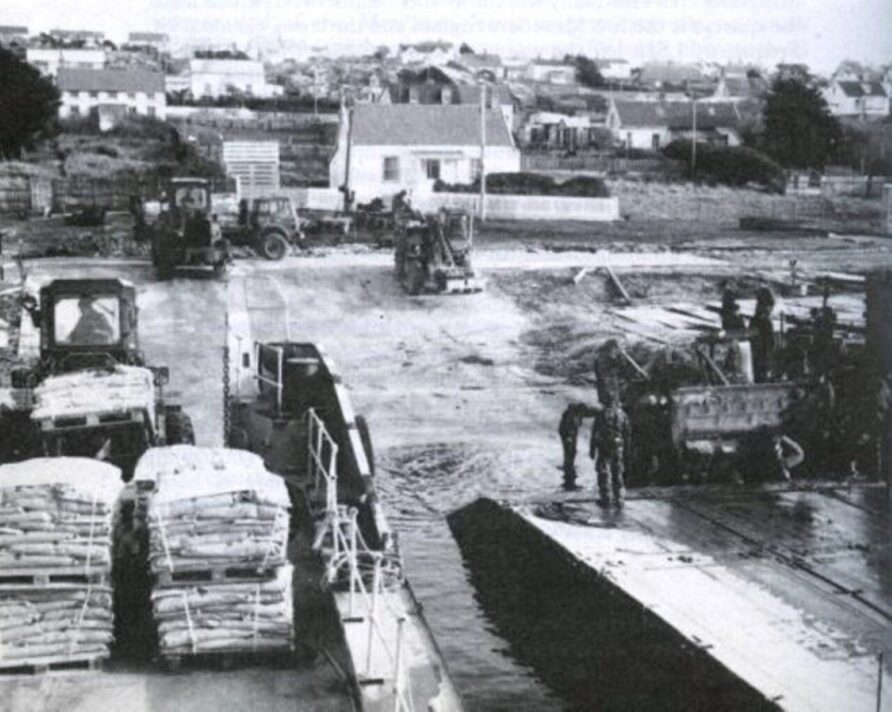
The importance of the Mexeflotes and their 17 Port Regiment RCT operators cannot be overstated, without their efforts, the materials required to construct the facilities at the airport would have taken an immeasurable amount of time longer than required.
With a journey time between the ship and B slipway in Port Stanley Harbour of between 30 and 40 minutes, the maximum weights would have to be exploited. AM2 and construction plant is heavy, and even the Mexeflote was seen to struggle on occasions.
Slipway B was the only useable slipway for heavy stores and had to be repaired and reinforced by the sappers before use.
One particularly challenging load was the pair of 45-tonne rock crushers required at the Mary Hill quarry near the airport, the operation had to be carried out at night because they would not fit under the overhead power and telephone wires in Port Stanley, the wires were temporarily lifted as the equipment was very slowly pushed and pulled into place by a recovery vehicle and Combat Engineer Tractor.
In one incident, a pair of Haulmatic earthmovers were lost over the side of a Mexeflote during poor weather. They were eventually recovered, repaired and rechristened as Aquamatics!
A great deal of stone aggregate was needed to provide a sub-base for the AM2 matting. This was obtained from the quarry near the airport at Mary Hill, the source of quartzite for the original runway.
Due to the quantities required for the extension, the quarry needed some additional development and the resultant rock extracted was harder than expected, which resulted in some problems with the crushing equipment as wear rates exceeded the expected.
Blasting operations would often shower the runway with small rocks and dislodge the AM2 matting, which needed clearance and repair.
60 Field Support Squadron, Royal Engineers would eventually provide over 25,000 tonnes of crushed rock for the construction activity.
The new runway was to be 2,000 feet (0.61 km) long, at 6,100 feet (1.86 km) and was to have a single uniform layer of AM2, all, obviously, at a single height.
The extension was at the West end of the runway, where Black Buck 2 had dropped its stick of bombs to stop the Argentine forces from extending the runway.
The soil conditions were poor, a mix of peat and sand with a very high water table. AM2 is a 12 or 6 feet (1.83 m) by 2 feet (0.61 m) interlocking aluminium sandwich construction ‘plank’ that fits together to form a single surface. 4,700 tonnes were used at Port Stanley at a cost of £10 million.
The official US description of AM-2 is;
The AM2 is an extruded aluminum mat with a solid top and bottom. The panel is 12 feet long and 2 feet wide requiring a placing area of 24 square feet
The panel is extruded in 6061 alloy aluminum and tempered to the T6 condition. The panels coated with antiskid compound weigh approximately 6.3 pounds per square foot.
The connectors consist of overlap and underlap connections on the ends and hinge joint connections on the sides. The side connectors are integral parts of the basic panel extrusions.
The panels can be placed at the rate of 573 square feet per man hour The AM2 mat qualifies as a medium duty mat based on performance but not on weight.
The AM2 is packaged in bundles containing 11 standard length panels 2 half-length panels and 13 locking bars. In computing material requirements N (equation 17 1) is rounded up to the nearest half panel and a waste factor of 10 percent for new panels and 15 percent for recovered panels is used.
The area to the West of the runway would be used for the extension, but it had a high water table, was peaty and at a different level to the main runway.
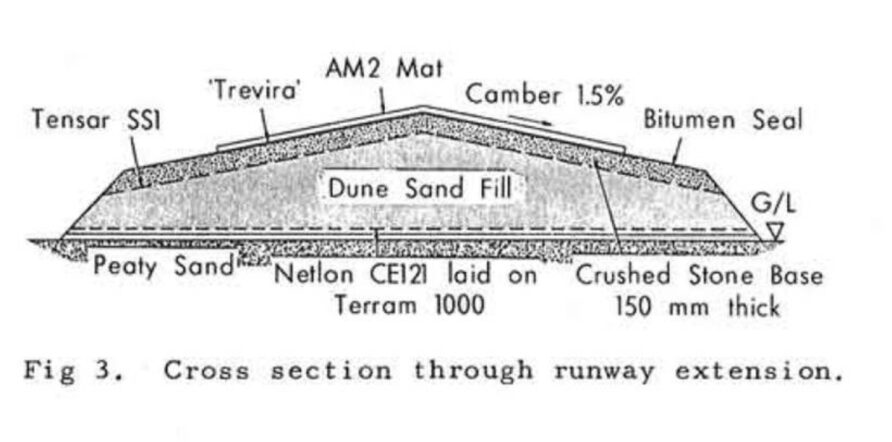
New techniques including the use of geotextiles such as the Tensar Stabilisation Grid and Terram textile layers were used to great effect.
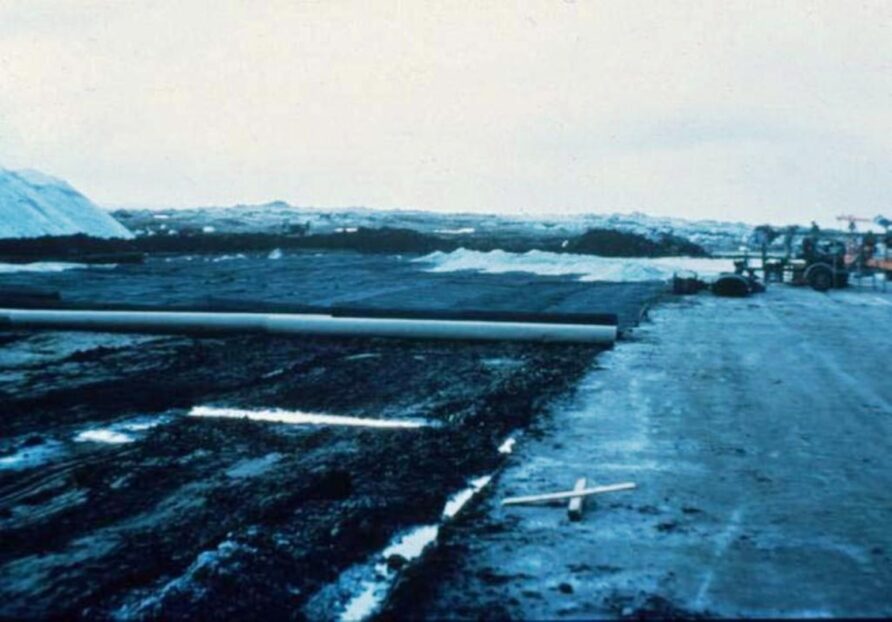
The key factor in planning the resurfacing and extension was to minimise disruption to air operations.
As much preparation as possible therefore was carried out before, lest Argentina takes advantage of the gap in air cover from the Harriers, although the cover was available from the Fleet Air Arm.
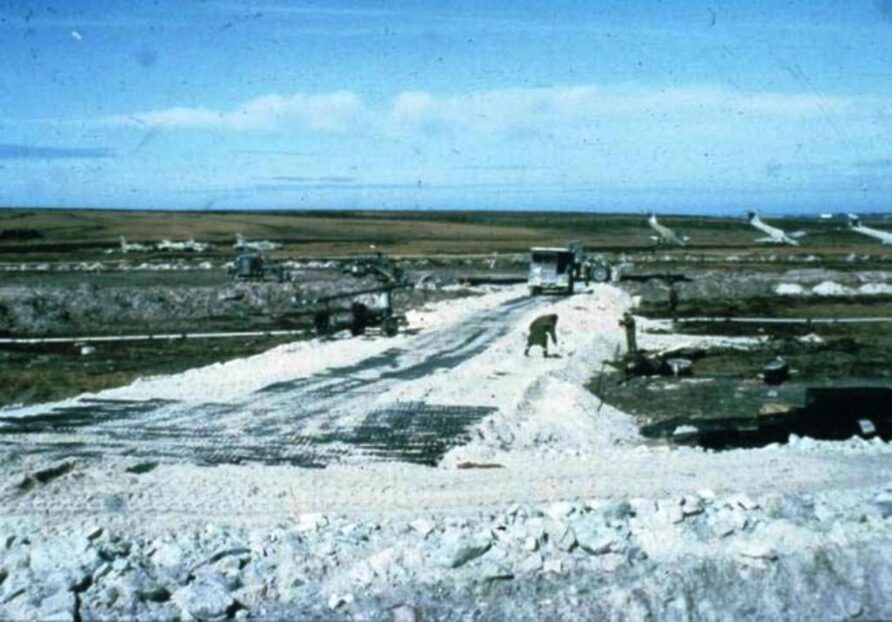
Despite this cover, speed was of the essence because Hercules flights were being heavily utilised.
Part of the preparations included practising the best techniques, team size and how the installation rate could be best supported by the store’s delivery transport and handling equipment.
The last C130 Hercules departed on the 15th of August, and the runway was closed for refurbishment. The multiple teams swung into action, eight troops of 26 men, Royal Engineers, infantry from the 1st Battalion The Queen’s Own Highlanders and even the odd sailor and airman for good measure.
Two teams were on the go at any one time, working three on nine off shifts.
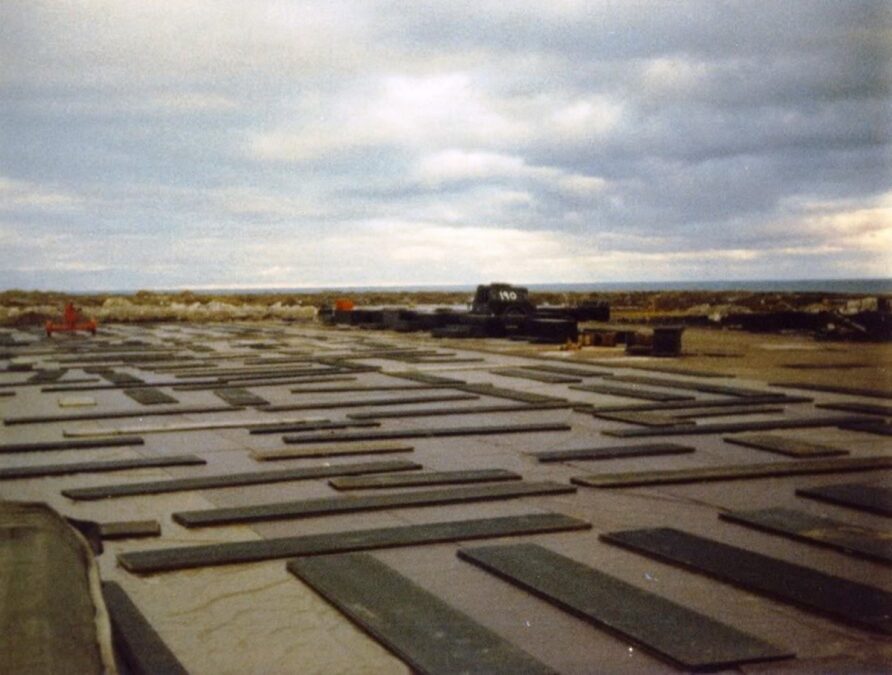
The wind was a major problem and if a panel’s grip was lost in high winds, the result could be fatal. Competition, intense rivalry and the odd side bet characterised this phase, so much so that it was reported in bad weather, the teams had to be ordered to stop.
Operating conditions were very difficult and in one unfortunate incident a working party of Royal Engineers from 11 Field Squadron and Welsh Guards were injured whilst waiting to cross the runway, some severely, when a Sidewinder missile was accidentally fired from a Harrier.
A bulk fuel facility was established near the runway and a pipeline laid across the mined terrain to the beach at Yorke Point. This pipeline was apparently earmarked for disposal but had been squirrelled away by an enterprising QM at Long Marston and sent south.
A floating pipeline was then used to connect the main pipeline to a beached fuel-filled dracone.
When empty, the dracone would be towed out, by a Royal Corps of Transport workboat, to a waiting tanker anchored in Port William and refilled.
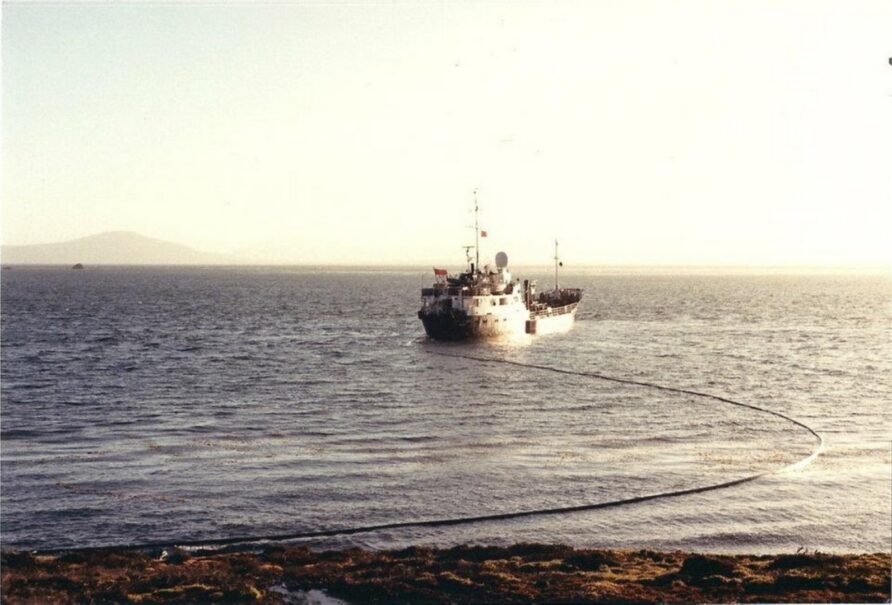
The three, later five, Rotary Hydraulic Arrestor Gear (RHAG) required concrete foundations but when complete, could dissipate 65mJ of energy to allow a tail hook equipped 23-tonne aircraft landing at 130 knots to come to a complete stop in 350ft (ca. 107 m).
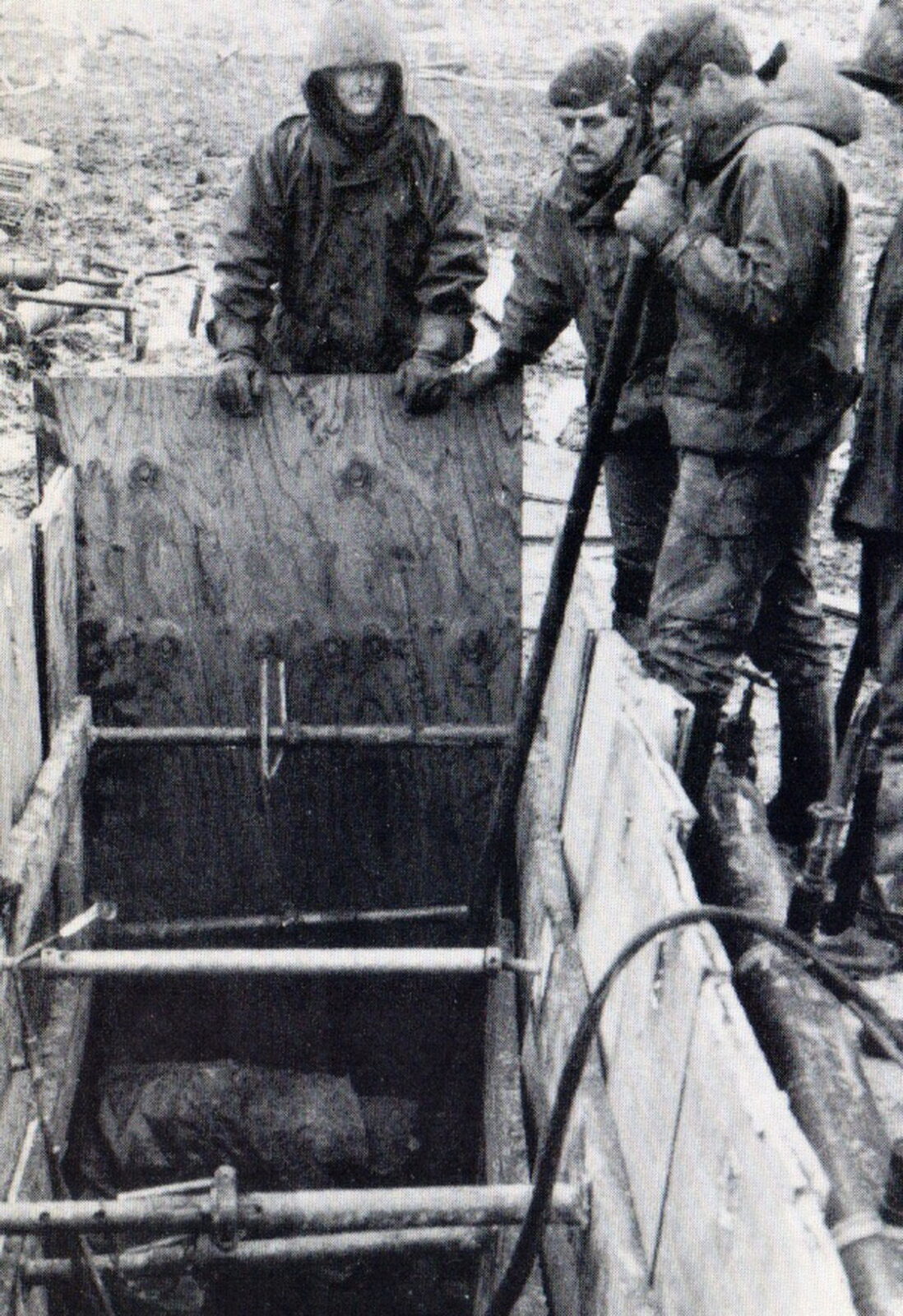
The RAF Hercules would still fly in this period, instead of landing, they would airdrop supplies at Seal Point and even used the snatch method to pick up sacks of outbound mail.
From the Lyneham Village website;
In this period, the Hercules maintained a regular service to airdrop supplies and also to collect mail, using the snatch method developed at short notice during June/July at the Joint Air Transport Establishment based at Brize Norton.
The equipment in the aircraft comprises a grappling hook trailed on 150 ft (ca. 46 m) of nylon rope, and a pair of powered winches used to wind the rope, hook and mail bag back onto the aircraft after the snatch.
Ground equipment comprises two poles 22 ft (ca. 7 m) tall and 50 ft (ca. 15 m) apart, with a loop of nylon rope slung between and the mail bag (up to 100 lb (ca. 45 kg)/45 kg in weight) attached to this loop by another 150 ft (ca. 46 m) length of rope.
The poles are set up so that the rope between is at right angles to the wind, and DZ (Drop Zone) markers are set up at 300 ft (ca. 91 m) and 600 ft (0.18 km) distance on the approach. Trailing the grappling hook, the Hercules flies at 50 ft (ca. 15 m) above ground level to snatch the bag.
About 30 snatches were made in this way before sufficient length of runway was again available at Port Stanley.
Two days ahead of the scheduled completion date, the complete runway was ready on the 27th of August. The first Hercules landing on the new billiard table smooth surface was completed the day after.
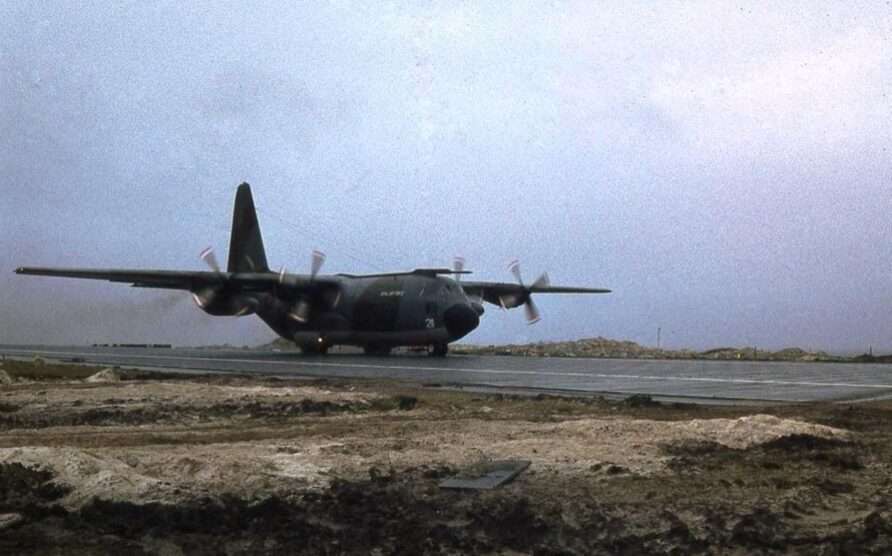
Upon completion of the runway, the Royal Engineers proudly erected a suitably painted sign (signwriting being an RE trade) proudly announcing the opening of Holdfast Airport.
It wouldn’t last long, of course, after a Vulcan sized sense of humour failure, the RAF removed it and renamed the place RAF Stanley!
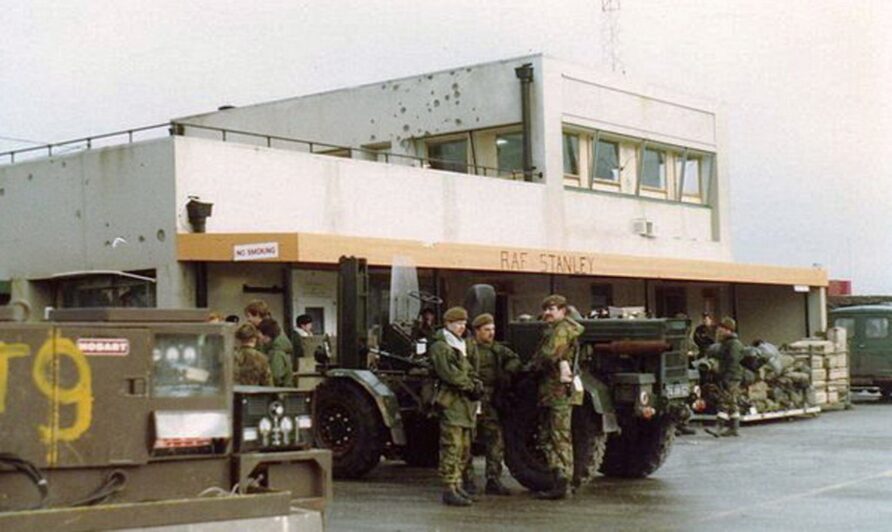
The Sappers couldn’t moan too much, though, given their original sign was too large.
As can be seen in the image below (with kind permission of Sqn Ldr Pete Kettell RAF Ret’d), when they pushed the last section in, the first section was pushed out.
Measure twice, paint once.
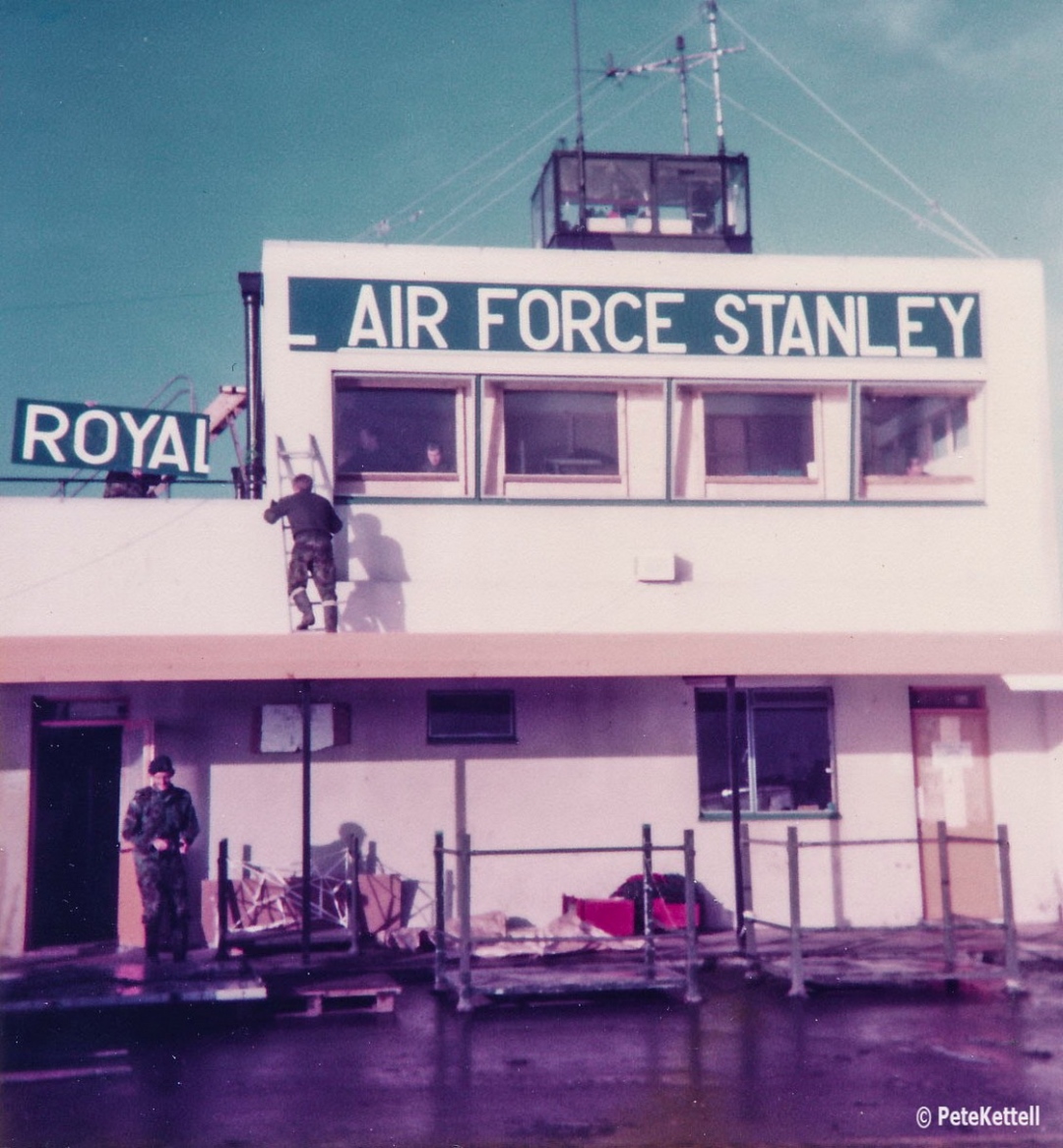
Members of the RAF movement squadron arrived and painted the tower green, with 3” brushes.
And an appropriately sized sign fitted.

The control cabin on the roof above the sign was eventually recovered to the UK and used at Priština Airport by the RAF in 1999.
Rubb and spandrel type hangars, together will all manner of engineering and logistics support facilities, were installed and improved.
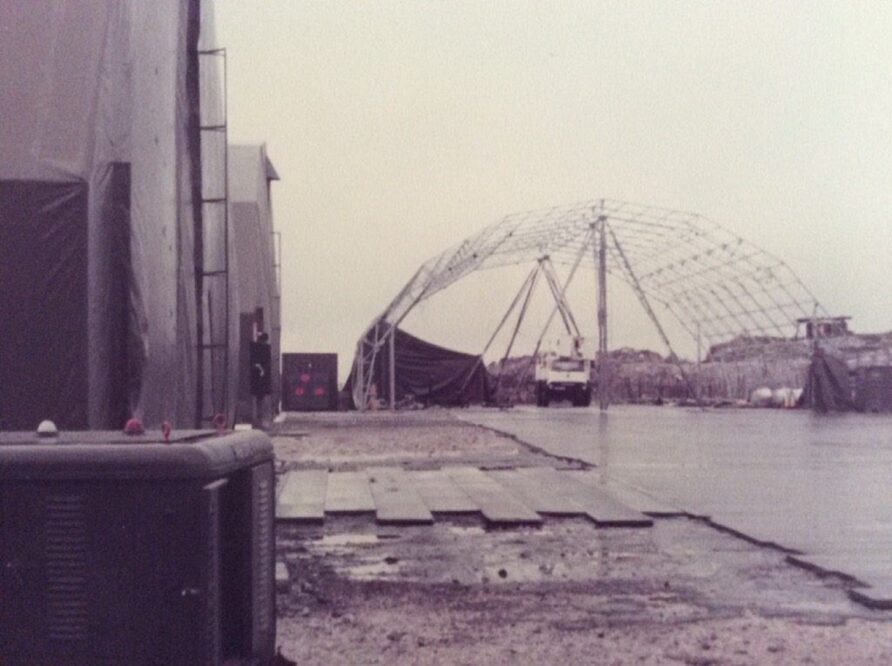
Helicopters (including Bristow SAR) and Harrier GR.3’s continued to operate from the new facilities
New additions arriving air-freight.
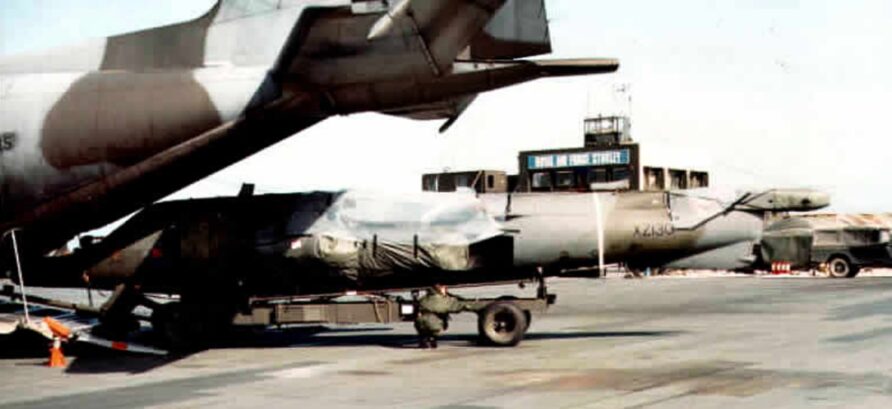
Helicopters (including Bristow SAR) and Harrier GR.3’s continued to operate from the new facilities.
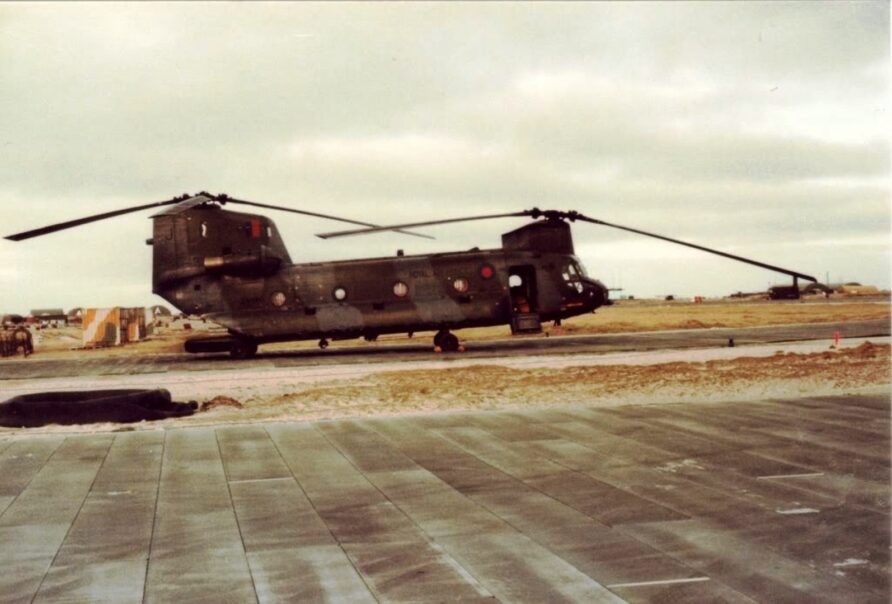
With the completion of the extended runway at RAF Stanley, the first Phantom from 29 Squadron located at Ascension arrived on the 17th of October., shown below.
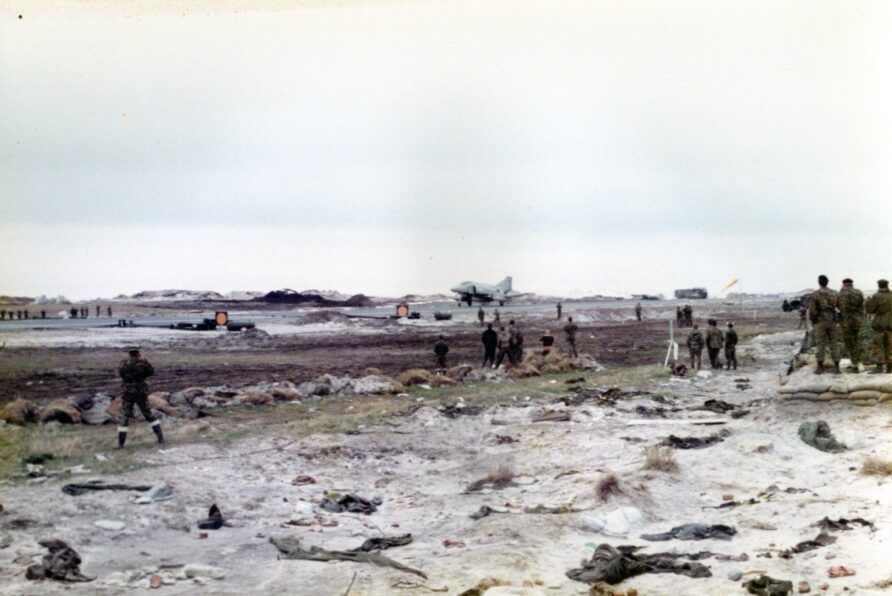
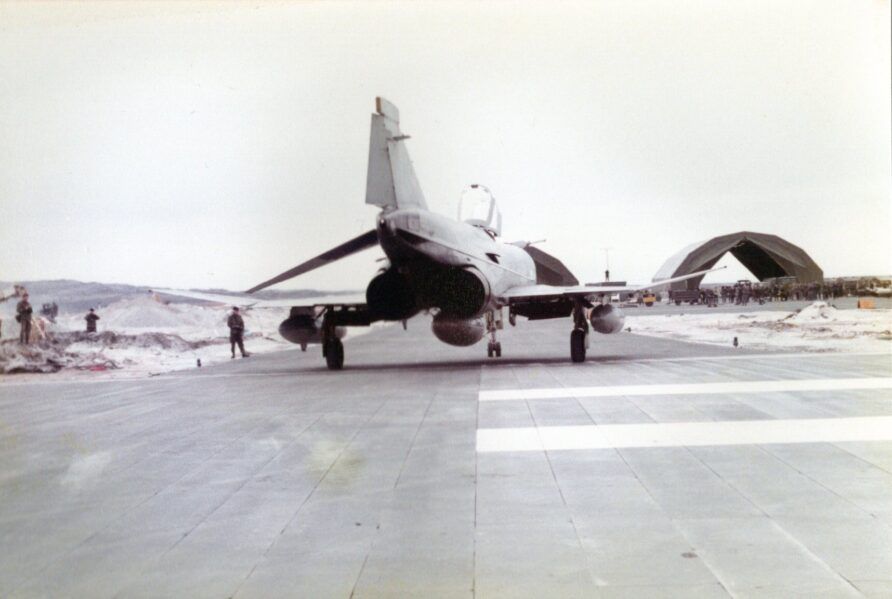
Seven other Phantoms were to follow in short order although, in the interim, the Harriers would soldier on.
These were replaced later by 23 Squadron. 18 Squadron, who had been operating Chinooks since the conflict, continued to use RAF Stanley.
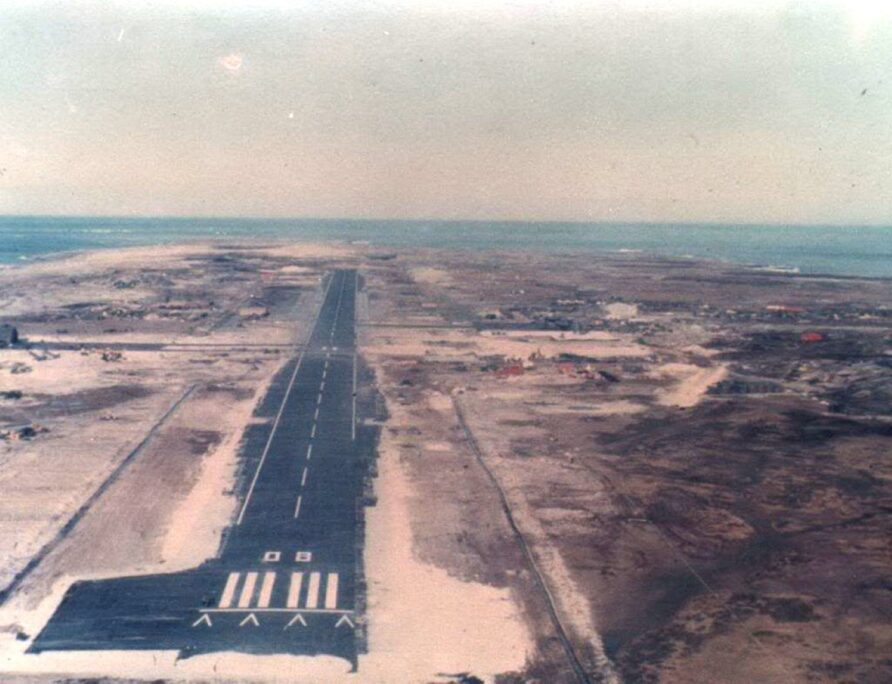
The image below shows the Rotary Hydraulic Arrestor GEar (RHAG) in action.
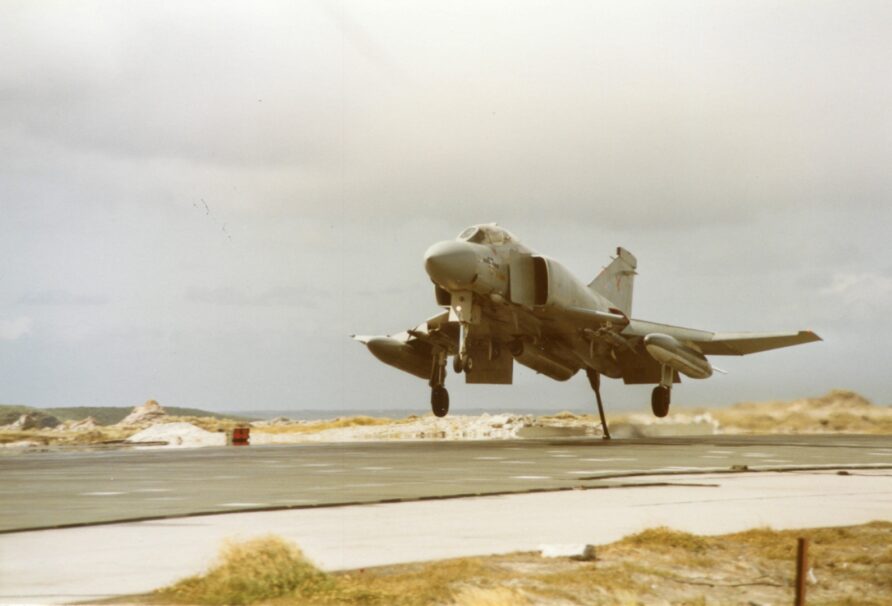
The AM2 can be clearly seen in these images
Elsewhere, 29 Squadron, with three F4 Phantom FGR2’s, took over the Quick Reaction Alert task at Ascension Island from the Harriers of 1 Squadron on the 25th of May.
Hercules refuelling tankers would also have to play a significant role in operations at RAF Stanley, as did Nimrods and, reportedly, Buccaneer aircraft.
With repeated use, AM-2 has a tendency to ‘walk’ down a runway and so every six weeks, OP BENDER (honestly) would be carried out to pull the complete runway back into position using chains and heavy vehicles.
This at first took 36 hours to complete but was reduced to 12 hours by the end of RAF Stanley’s use.
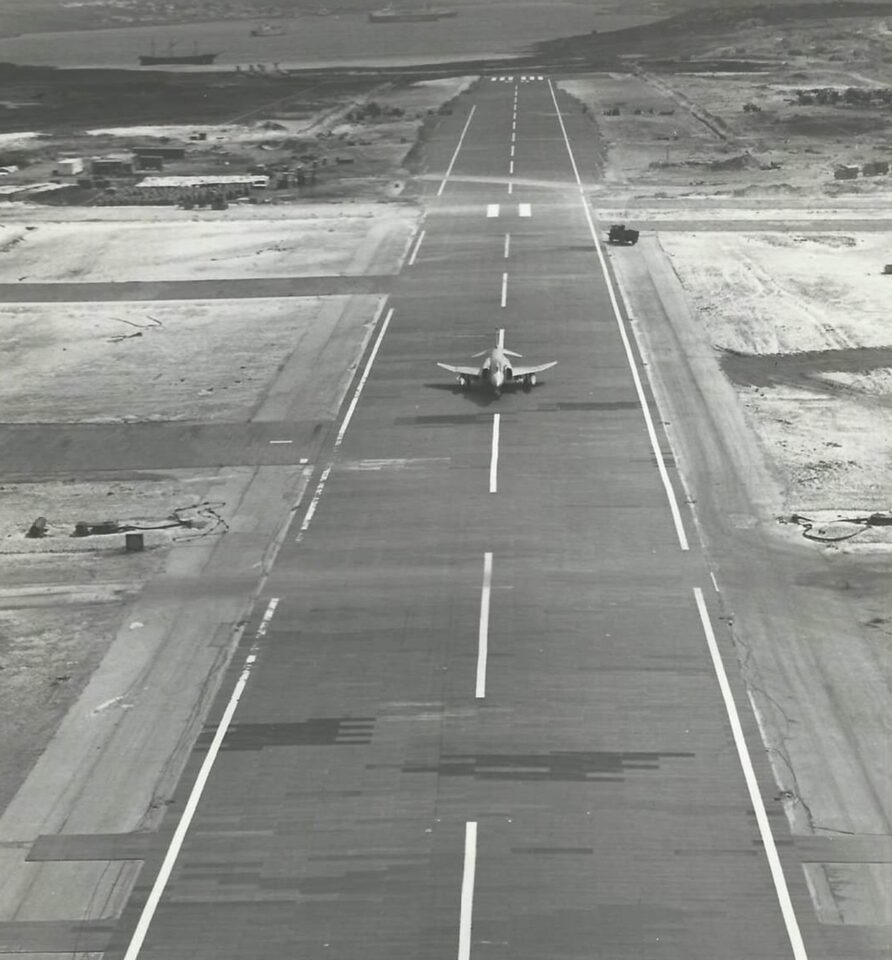
Quarrying continued and would present a hazard to flight operations, but this was carefully managed.
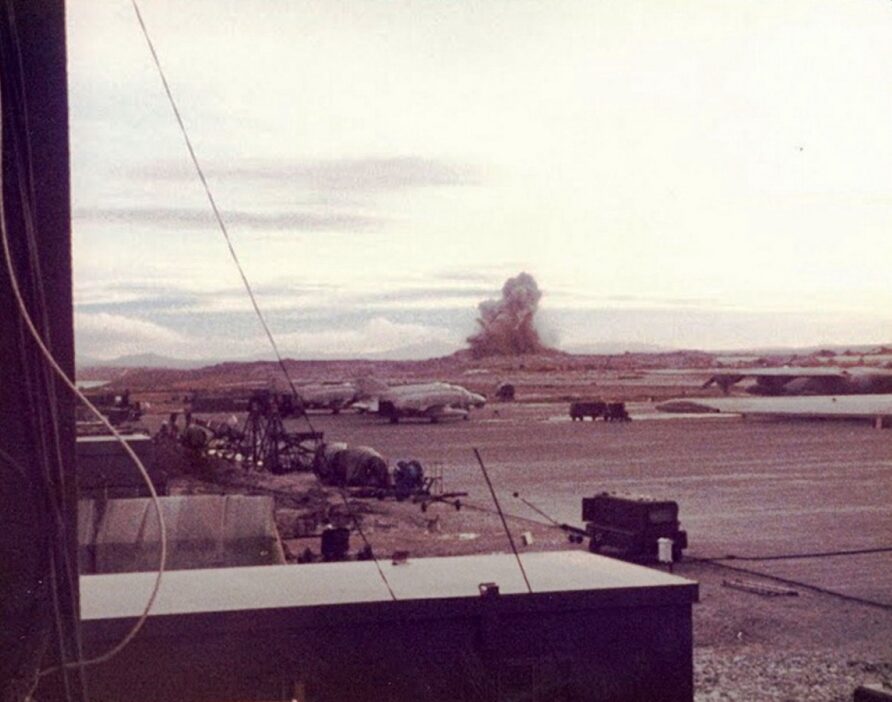
Joining the Phantoms at RAF Stanley in the Falklands Islands Air Defence Ground Environment (FIADGE) were two radar stations, first on Mount Kent, then Byron Heights and Mount Alice, where they remain to this day.
Each site required 700 ISO containers of equipment and materials to be flown there by Chinook.
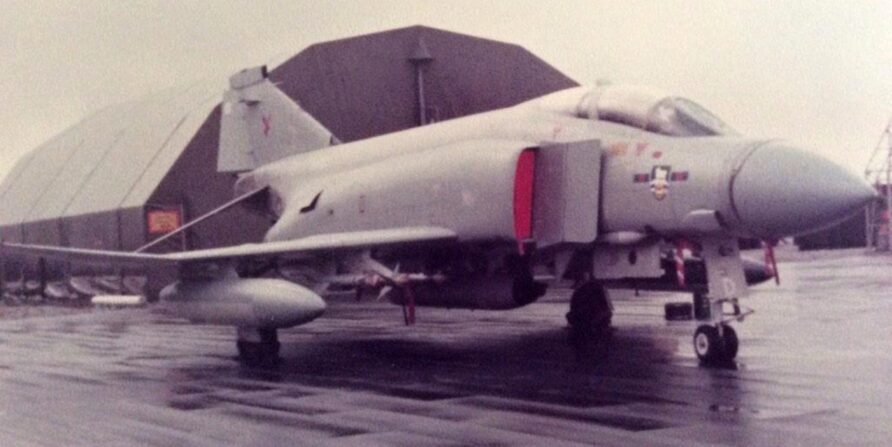
RAF Stanley even had a famous visitor, or two.
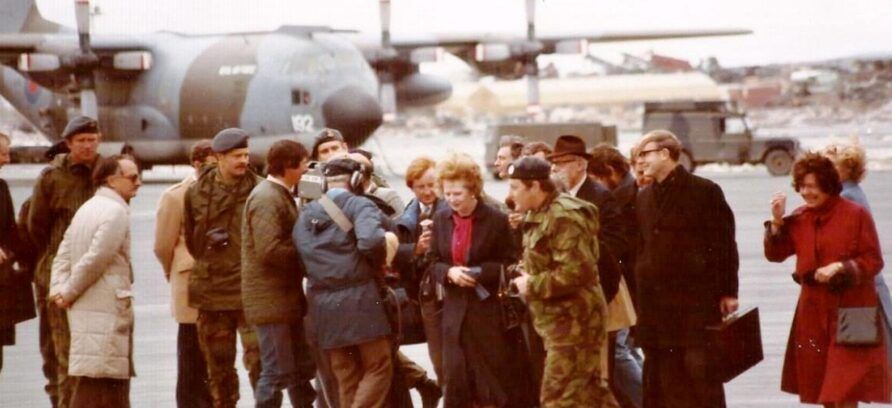
Margaret Thatcher visited the airport in January 1983, transported there in an RAF C130 Hercules that had been fitted with a VIP pod. The 24×9×8 ft (2.44 m) pod contained four ex VC-10 seats, bunks, and washroom facilities.
The Prime Minister’s Hercules took off from Ascension Island with an accompanying Hercules, at 1,300 nm the Prime Minister’s rendezvoused for refuelling with a Victor tanker (itself having been refuelled a 1,000 nm south of Ascension Island), at 1,800 nm the Victor refuelled the Hercules Tanker.
Finally, at 2,600 nm, the Hercules tanker refuelled the Prime Minister’s Hercules and returned to Ascension Island.
The return flight was to use the same aircraft but unfortunately, it developed problems at RAF Stanley, forcing the ‘Iron Lady’ to travel back on a standard Hercules, without the comfort pod.
Phase Three — RAF Mount Pleasant and Beyond
Plans were made for a large, strategic airbase on the Falkland Islands in 1983
In June 1983, Michael Heseltine MP made the following statement to the House of Commons
With permission, Mr. Speaker, I will make a statement about the Government’s decision on the construction of a new strategic airfield in the Falkland Island.
The Government believe that the defence of the Falkland Islands, the support of the garrison and its reinforcement in emergency depend on permanent and improved airfield facilities; and the Government welcome the recent useful report of the Defence Committee which supports this view.
The present airfield at RAF Stanley is temporary and operations are restricted by the length and strength of its single runway. Therefore, we have examined the alternatives of improving RAF Stanley or of building a new aifrield on a clear site at Mount Pleasant, which is between Stanley and Darwin.
We have now decided that the right course is to build at Mount Pleasant. This is less expensive, even allowing for the cost of a road between Mount Pleasant and Stanley, and is much less likely to involve unforeseen delays and interruptions to the construction work. Most important, the use of RAF Stanley by the garrison will not be restricted while the new airfield is being built.
The new airfield will be able to operate wide-bodied aircraft, civil as well as military. This will enable us to make welcome savings in the running costs of supporting the garrison; it will greatly reduce the amount of time required to reinforce the garrison if need be; and it will give a powerful boost to the economy and infrastructure of the islands.
Tenders have been received from three consortia of British civil engineering contractors and a contract for the construction of Mount Pleasant airfield will be placed very shortly by the PSA with the consortium of Mowlem-LaingAmey Roadstone Construction. The value of the work to be executed under this contract, together with the costs of sub-contracts and shipping, is approximately £190 million. To this will be added the cost of the Stanley to Mount Pleasant road and a separate contract to install Government-furnished communication and navigation aids, making a total of about £215 million.
This order of cost was allowed for in the additional provision for Falklands expenditure included in the Defence budget and will not therefore add to planned public expenditure or necessitate offsetting reductions in defence expenditure elsewhere. The labour force will be recruited in this country. Work on the site will begin this autumn—the Falklands spring— and the new runway should be usable from April 1985. The whole airfield complex, including all the necessary facilities, will be complete by about February 1986.
I believe that this statement will be generally welcome, both in Parliament and in the Falklands, and will be seen as another practical sign of our determination to ensure the security of the islands.
In the same year, the Falkland Islands Government Aviation Service (FIGAS) took delivery of two new BN Islanders, replacing those destroyed during the conflict.
Building such a large airfield, with all modern facilities, in the harsh and remote conditions of the Falkland Islands was an incredible feat of civil engineering and project management.
Everything had to be transported in.
The main runway and essential support facilities were completed by April 1985, with additional facilities completed in the following years.
Stanley Airport was returned to civilian use soon after and the AM2 runway matting removed.
FIGAS has since taken delivery of a number of additional BN Islanders.
The current Aerodrome Plan can be found at this link and there are a number of ‘camp airstrips’ on both East and West Falkland, an example below at Fox Bay.
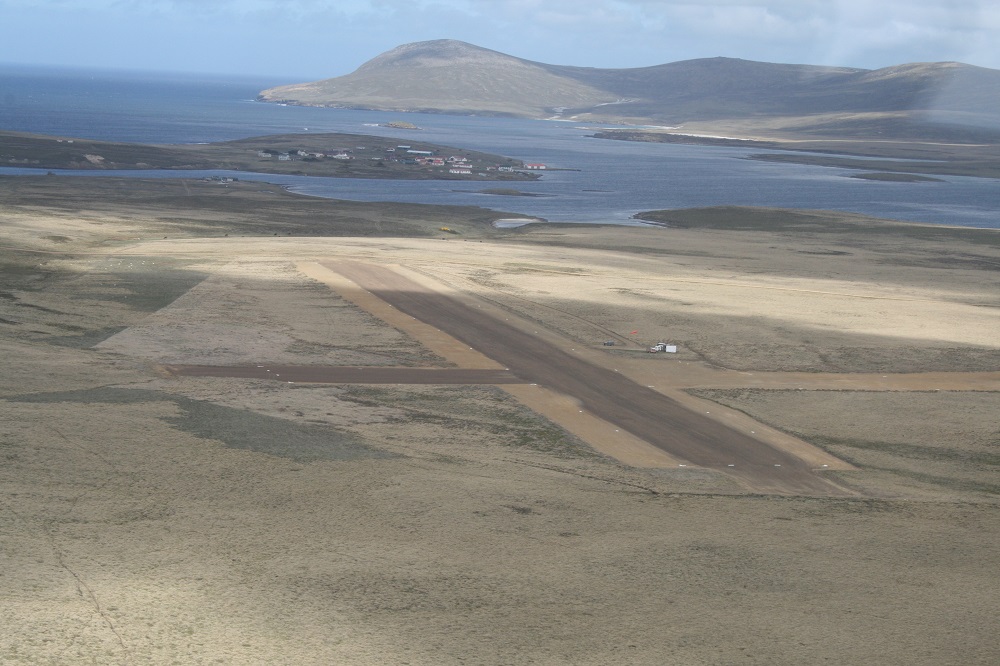
The Airport today, with that all-important sign.
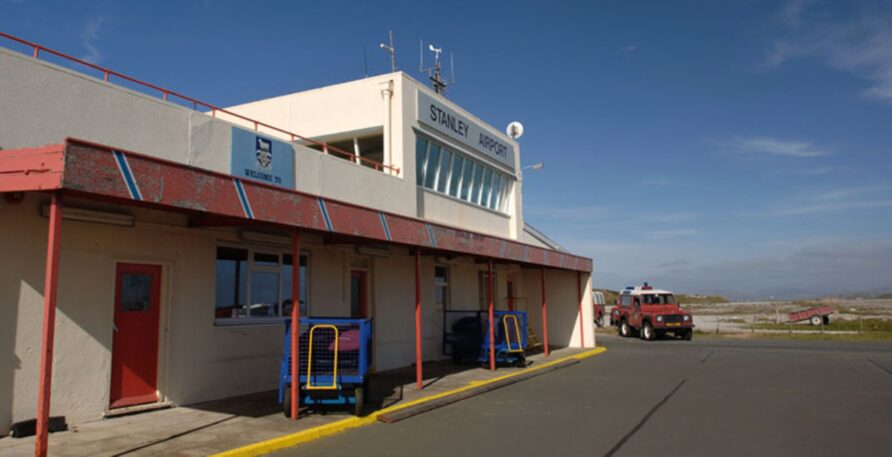
FIGAS continues to operate a fleet of Britten Norman Islanders, servicing remote airstrips and the main airport at Stanley.
Click here for a fantastic aerial view of the airport, you can still see some craters.
A Short Note…
Think Defence is a hobby, a serious hobby, but a hobby nonetheless.
I want to avoid charging for content, but hosting fees, software subscriptions and other services add up, so to help me keep the show on the road, I ask that you support the site in any way you can. It is hugely appreciated.
Advertising
You might see Google adverts depending on where you are on the site, please click one if it interests you. I know they can be annoying, but they are the one thing that returns the most.
Make a Donation
Donations can be made at a third-party site called Ko_fi.

Think Defence Merch
Everything from a Brimstone sticker to a Bailey Bridge duvet cover, pop over to the Think Defence Merchandise Store at Red Bubble.
Some might be marked as ‘mature content’ because it is a firearm!
Affiliate Links
Amazon and the occasional product link might appear in the content, you know the drill, I get a small cut if you go on to make a purchase
Back to the Article…
Observations and Discussion
Airpower was going to be fundamental to success or failure in the 1982 Falkland Islands conflict, and the Black Buck raids by RAF Vulcan’s against Stanley Airport and the occupying Argentine force were indicative of the importance of denying occupying forces a functional runway.
The Black Buck Vulcan missions tend to evoke strong opinions, and discussion can often descend into a childish and narrow argument.
There are numerous books and online resources that look at the actual missions, and that they demonstrated superb airmanship and improvisation is not in doubt, but not much that examines their actual effectiveness.
So I want to present what, I hope, is a fair-minded and reasonable look at their effectiveness, and some claims and counter-claims made in numerous books, magazines, blogs, and forums.
I intend to do this by looking at them from a ground perspective, engineering, and logistics.
Before starting, I want to make clear a few things.
I am not a professional historian, aviation civil engineer or photographic analyst, have spoken to no one who was there, was not there myself and only had access to open-source information when writing. This means that anything that follows this sentence must be viewed in that context.
This is merely one opinion of many, not authoritative or final. Read my ‘working out’ and agree or disagree with the conclusions, but please do not lose sight of those limitations.
That they were superb examples of airmanship, skill, adaptability, and determination is not in dispute, discussing their effectiveness does not detract in any way whatsoever from that.
Discussion tends to narrow down into single subjects, but in viewing the effectiveness of the raids, one has to look at the bigger strategic and political picture. Information we know today may well not have been known then, there was no internet or immediate communications, planners and other personnel had to work on limited information at a breakneck pace, let’s not forget, it was all over in ten weeks.
I also think most commentary tends to a narrow focus on events immediately before and after Black Buck, ignoring what came before and after the conflict.
Both these aspects are neglected, but they are all related to any analysis.
So, with that in mind, and as if the Internet doesn’t have enough Black Buck commentary, here we go, a few thoughts on that, and what went before…
Before the Invasion
The belligerence and attitude of the Argentine government were well known, so when the contract for the construction of Stanley Airport was let to Johnson Construction in 1973, it would not have been totally outrageous to ensure that pre-built demolition chambers were installed at key locations on the runway.
The concept of pre-built demolition chambers in major infrastructure projects was, at the time, relatively common.
The cost of creating such chambers during the build phase would have been negligible.
These would have allowed the rapid denial of the runway using simple explosives, well, within the non-specialist skill-sets of Naval Party 8901 (Royal Marines).
However, given that LADE operated services from Stanley Airport, this might not have been a politically acceptable solution, but there were other alternatives available.
One such alternative to a pre-built demolition chamber is the Rapid Cratering Kit, in service at the time, as they are today.
Although the modern version is shown below, the principle is the same. A shaped charge (beehive) is used to, effectively, drill a hole in the asphalt or concrete runway surface. The cavity (or camouflet) is filled with a larger charge of explosives and when detonated, the resultant crater is much larger than simply placing the explosives on the surface.
They are very effective and quick to deploy.

Typically, the explosively drilled hole extends between two and three metres and with a charge of 30 kg, the resultant crater can be up to 8m wide and 3.5m deep. The total packed weight is approximately 60 kg.
If NP8901 had, among their strength, a section from 59 Commando Squadron Royal Engineers, they may well have had some engineer stores, including RCK’s.
There is no doubt they would have had the skills and time to use them on the runway, possibly on pre-surveyed and marked locations on the runway.
Placed on the centre-line and at regular intervals down it, repairs would be difficult and the ‘undermining’ effect would have created significant structural weakness simultaneously on both sides of the runway.
The Official History of the Falklands Campaign records some information about runway denial;
On the other hand, having been given no advice other than to dispose of his meagre forces and do what he could, Hunt might have appreciated a bit more information.
No guidance was given on how the Argentine forces might arrive, including their likely use of amphibious personnel carriers, though this might have helped when choosing which beach to defend.
The only suggestion received was to crater the runway, but there was no time to do this properly: it would have involved drilling holes to insert dynamite. All that was possible was to attempt to block the runway with vehicles.
In the House of Commons, a year after the conflict had concluded, Dennis Healey MP made the following statement;
When the Argentines finally invaded the islands, they did so with a comparatively small force of marines. Yet at that time we did not even have sufficient explosives on the islands to crater the airfield. The result was that the Argentines used the intervening weeks before the task force arrived to build up a formidable force of arms on the islands.
Hard not agree with Dennis.
This is my first observation, nothing at all to do with Black Buck;
Lacking a couple of thousand pounds worth of explosives and some forethought on combat engineering, over two thousand tonnes of highly important enemy war material and four thousand personnel would have had to travel on ships, running the gauntlet of the five Royal Navy SSN’s in the area.
Or maybe, the defenders would have had to do without those reinforcements (men and materials), thus changing the character of the entire campaign. There is no guarantee that the merchant ships would have been detected and attacked, but the simple fact remains, without the runway, the defenders may well have looked very different in terms of capability and size than they did.
It should also be noted that AM-2 runway repair matting was available at the airport, surplus from the airstrip at Hookers Point. AM-2 is a valuable commodity; that it was not adequately secured and disposed of before the invasion, may also have been a large mistake, if the Argentine combat engineers had made better use of it.
As we know, these opportunities were not taken and so, we must look at the next chapter in the story, the role of the runway after the invasion.
Reinforcing the Argentine Garrison in April 1982
It is widely agreed that the root cause of Argentina’s rash actions in invading the Falkland Islands in April 1982 was four beliefs;
- That the UN and world opinion would fall behind Argentina,
- That in the interests of Pan-American and anti-Soviet Cold War relations, the United States would pressure the United Kingdom to accept the status quo and negotiate from a position of weakness,
- That Chile, despite poor relations with Argentina, would forget all that and in a show of Latin American solidarity, settle any differences quickly, and
- That the UK would not respond militarily, after all, it had been vacillating on the subject or many years with the Foreign Office trying its best to make side deals with Argentina and several factors such as the withdrawal of HMS Endurance, intended sale of HMS Invincible and the 1981 British Nationality Act merely serving as more encouragement.
Because it believed that all four would come to pass, the invasion plans did not include a serious defence plan, simply because it was not thought they needed one.
So, whilst the UK was hastily putting together the Task Force in early April, Argentina was also putting together a hasty reinforcement plan and defence strategy for ‘Las Malvinas’
This is all well documented.
From the end of the first week of April, the realisation set in that the UK was not afraid to use force and had the will and wallet to prevail.
In recognition that they would be in a fight, and that the fight would not just be in and around the Falkland Islands, the Malvinas Operational Theatre (TOM) command was replaced by Teatro de Operaciones del Atlántico Sur TOAS), or South Atlantic Theatre of Operations command.
At the same time, TOAS set about a massive mobilisation, moving and assembling forces throughout Argentina. The commander and deputy were both from the Armada, clearly, the naval forces of Argentina were still in the driving seat.
On the 7th, the UK announced a Maritime Exclusion Zone would come into force on the 12th
By the 10th of April, the number of flights into ‘BAM Malvina’s’ had increased dramatically
Knowing full well the capabilities of British nuclear attack submarines and likely transit times from the UK, very little freight would flow into the Falkland Islands by sea from this time. Civilian cargo vessels used by Argentina for transport tasks to the Falkland Islands included the Rio Cincel, Río Carcarañá, Formosa, Córdoba, Bahía Buen Suceso, Isla de Los Estados, Yehuín and the Mar del Norte.
The movements of the rest of the fleet are well documented, but in summary, they took the MEZ seriously.
Some blockade running was attempted by the civilian vessels listed above, but after the middle of April, much of the transport to the Falkland Islands by Argentine forces was conducted by air, through BAM Malvinas/Stanley Airport.
The Electra and Fellowship aircraft of the Armada 1 and 2 Escuadrilla de Sosten Logistico Movil, transported 500 tonnes and 1,500 personnel between the 2nd of April and 30th of April.
The ‘Córdoba’ transport vessel was loaded at Puerto Deseado with Ejercitos armour, heavy artillery, ammunition and other supplies, ready to sail. But on the 12th was unloaded because of the inability of the Armada to guarantee her survival.
She was unloaded and her cargo moved by road to Comodoro Rivadavia for transport by C-130 Hercules, an estimated 100 flights worth.
It was all flown to Port Stanley.
Equipment that was deemed critical, including radar, anti-aircraft systems, helicopters, and artillery were all airlifted from the 12th onwards. The anti-aircraft guns of GADA601 and GADA101 were offloaded from ships and reloaded onto aircraft, arriving piecemeal by the 19th.
Between the 19th and 29th of April, the C130 Hercules, of the FAA Grupo 1 Escuadrón I de Transporte Aéreo flew 91 missions into BAM Malvinas, Grupo 1 F-28s, 74 missions, Aerolíneas Argentinas 737’s, 36 flights, and BAC 1-11, 4 flights. Between them, in just 10 days, they transported 1,544 tonnes and 2,844 personnel.
Adding that to the Armada’s tally in the final half of May 1982 brings the total to over two thousand tonnes of high-priority cargo and 4,300 personnel.
Turnaround times of 15 minutes were not unusual, and every single aircraft would carry their maximum fuel load, and not needed for the return flight would be decanted into pillow tanks and drums to build up stocks.
S2-E Tracker, Pucara, MB-339A, T34C Mentor and Skyvan, either operated from or transited via, BAM Malvinas.
On April 28th, the Total Exclusion Zone (TEZ) was announced, this being up to the 12 nm limit of the coast of Argentina.
Until that point, and a few days beyond, the runway at Stanley Airport was absolutely critical to the hastily arranged, but extremely well-implemented reinforcement plan.
Clearly, the runway was a strategically important asset to the Argentine forces. In the same period, the UK was making assessments of how it would likely be used by Argentina, and what could be done about it. The next section, therefore, takes place over the same time as this one.
As a lead into the next section, a summary of Black Buck from the RAF;
RAF 2007 Falklands 30th anniversary Edition
http://www.raf.mod.uk/rafcms/mediafiles/C0054AE0_1143_EC82_2EE9013F84C9F82E.pdf
Was it worth it? Little credit is usually given to the effect of the BLACK BUCK missions (three bombing attacks and two Shrike (anti-radar missile) attacks). Most military historians fail to mention that ‘BLACK BUCK 1’ opened the UK’s action against the Argentine forces. The actual damage caused by all the attacks was small, but their effect was considerable. Port Stanley airfield was denied to fighter aircraft for the rest of the war. But, possibly more importantly, Britain demonstrated an ability to attack the Argentine mainland, and for this reason, squadrons of Mirages were redeployed from the south to defend airfields and HQs in the north of Argentina. This significantly reduced the numbers of fighter aircraft capable of operating over the Falklands, which could have supported their fighter-bombers, and made life very different for our aircraft. After the Shrike attacks, all radars were turned off whenever any aircraft was seen approaching within about 40 miles (ca. 64 km), thereby denying the enemy a clear picture of what was going on in the air around the Islands. The final BLACK BUCK mission, on 12 June, two days before the final surrender, will have been a further blow to morale, by demonstrating that while our ground forces may have been running out of supplies and munitions, Britain could continue to mount attacks from Ascension ad-infinitum
It is this assessment that usually sits at the centre of much of the controversy because let’s face it, it paints a fairly rosy picture.
Initial UK Intelligence Assessment
Underpinning the planning for Black Buck was an assessment of capability and likelihood.
What were Argentine forces intent for the runway?
Key to subsequent decision-making was a SECRET intelligence briefing document produced on the 7th April 1982 that set out the UK’s understanding of the potential to utilise Stanley Airport for enemy aircraft operations. Like many of the documents at the time, now available online at the Margaret Thatcher Foundation website. With the benefit of many decades of hindsight, we can second guess the assessment.
Airfield Development by Argentine Engineers. Argentine Air Force Engineers constructed a temporary airstrip 4000 ft (1.22 km) long 50 ft (ca. 15 m) wide in 1971 near Rookery Bay between Port Stanley and the existing airfield. This airstrip was surfaced with US AM2 aluminium surfacing expedient, which was lifted and removed from the Falkland Islands in 1978.
Yes and no, the ‘AM2 aluminium surfacing expedient’ was not lifted and removed from the islands. AM2 was already available at the airport and was used as a general construction material and means of providing temporary aircraft parking, more on this later.
With the engineer plant available on East Falkland, augmented by extra plant which is known to be in transit from Argentina, the Air Force Engineers could level and surface an entirely new airstrip on a suitable site like the one previously used at Rookery Bay. Alternatively, in 2 to 3 weeks it is estimated that the existing airfield could be extended to 6000 ft (1.83 km) maximum if a surfacing expedient such as the US AM2 was imported.
The assessment was correct in stating that the runway could be extended, after all, it is what we did, but underestimated by some margin the time taken to do so, and does not refer at all the enormous effort needed, again, as demonstrated by us.
We have no knowledge of Argentine ability to provide bulk refuelling facilities onshore.
There are several sites near the airport where an LST could beach, and this could be one way of bringing in a large quantity of fuel in drums or tanks. Even if they have no dracones and pillow tanks they could very quickly set up a significant reserve of aviation fuel near the airport
Again, correct, it is what we did.
Fuel for the Argentine forces operating on the islands was never a problem.
Argentine Air Force Air Transport Operations from Stanley. If pressed, the Argentine Air Force should be able to operate C130 Hercules into Stanley Airport carrying a maximum payload of 17000 kg. In addition, the Fokker F27 and F28s could fly in fully laden.
All this assumes that the aircraft do not refuel at Stanley and that they arrive from the nearest mainland base. Because there is no perimeter track and the apron is restricted, the number of sorties will be limited.
They should have no difficulty however in unloading and clearing a minimum of say 12 aircraft per day, which could give an inward airlift in the order of 200 tons of stores per day
A very accurate assessment, although it missed off a couple of aircraft used for the airlift
Argentine Offensive/Defensive Air Operations. The Argentine Mirage III, Mirage V and their A4 Skyhawks could operate from Stanley Airport with almost full payloads to defend the Island.
The limited parking area would again be a problem. If the Argentine Air Force Engineers chose to improve this, however, there is no reason why, say, 4 of these fighter aircraft could not operate from Stanley.
The factor most likely to limit the sortie rate is that of fuel supply. With forward planning and the engineer work described above, it must therefore be assumed that the Argentine Air Force could give themselves at least some air cover.
This is perhaps the most relevant, clearly, the UK intelligence assessment was that the runway at Stanley Airport could support all their combat aircraft and subject to fuel availability and engineering works, four of them could easily operate from Port Stanley.
No matter whether Argentina could or intended to, the UK’s view was that it could.
Therefore, on the balance of risk, something had to be done to make sure, whatever their intent or ability, they couldn’t do so.
And so the train of thought that resulted in Black Buck I left the station.
The Official History of the Falklands Campaign states;
It was unlikely that attack aircraft would be based on the airfield at Stanley since the pressing need there would be for air defence and the ground facilities would be critically over-stretched by a mixture of air defence, attack and transport aircraft. DCDS(I) assessed that the best form of air defence for Stanley would be afforded by stationing, say, four Mirage aircraft on the airstrip there.
Because of the lack of night operating facilities and as it was the simpler as well as the lighter of the two types, these would probably be Mirage V.
There was some intelligence suggesting an intention to extend the runway at Stanley by the 19 April to 4,000 metres using ‘fulminated concrete’ and if this were achieved it would open the possibility of operating 10 Mirage Vs, 58 Pucaras, and Super Etendards (with the Exocet capability) from the airfield, as well as four S2s (mid-1960s ASW technology).
The best estimate, however, was that only a limited air defence capability was likely to be available to the Argentines at Stanley, and even then, only in daylight and good weather
The SECRET intelligence briefing and Official History establishes that during the period bounded by the second week of April 1982, whilst lead elements of the Task Force were en route, the UK assessed that the use of Stanley Airport for fast jet operations as possible.
Yet, there is other evidence that would seem to contradict this.
An article by Air Vice Marshal Pat O’Reilly CB in the journal of the Worshipful Company of Engineers, states;
Originally, a grass strip, Stanley Airport’s runway (4,100 by 150 feet (ca. 46 m)) had been built by a British contractor in the 70s and intelligence on its construction was provided, before it was attacked, by courtesy of the Engineer and Railway Staff Corps.
A 60 strong corps of the Territorial Army, composed exclusively of unpaid officers of major to colonel rank (“all rank and no file”, as they would have it).
The Middle Warden is one of their colonels. The Corps brings together technical experts, generally at an executive level, to provide advice to our Armed Forces in key engineering disciplines.
Fortuitously, one of their number, a senior partner with the consulting engineers who designed and oversaw the build, was able to provide not only details of its construction but valuable information on where surplus equipment and materiel had been disposed of locally. Ironically, the airfield was developed to allow the Argentineans to provide a short-haul Fokker aircraft service to the mainland
The paper describes the input to the intelligence process by the Engineer and Railway Staff Corps.
The Army website describes the role of the Corps as;
The Engineer and Railway Staff Corps was founded in 1865, when there were many private railway companies, with the principal objective of ensuring “the combined action among all the railways when the country is in danger” and one of the main duties was “the preparation, during peace, of schemes for drawing troops from given distant parts and for concentrating them within given areas in the shortest possible time”.
In 1972, the Royal Engineers requested that the base of expertise be widened to include, where possible, engineers and other experts in the fields of airport design and construction, electrical and mechanical services, petrol and oil engineering, geology and soil mechanics, water and sewerage
An Institute of Civil Engineers Paper called Military Engineering in the Falkland Islands 1982-83 by Major General G. B. Sinclair, Brigadier F. G. Barton and Lt Colonel L. J. Kennedy, all Royal Engineer officers, describes their input in more detail;
At the same time, the RAF began asking questions about Port Stanley, Airport.
Initially, they were interested in the capability of the Argentines there and, through contacts in the Engineer and Railway Staff Corps of the Territorial Army (TA) with the consultants involved in the building of the airfield at Port Stanley, copies of the drawings for the airfield were obtained which gave details of its construction.
There was a runway 4100 ft long and 150 ft wide designed to load classification number (LCN) 16 although, in places, it could be as high as LCN 30.
The Air Staff were therefore advised that the Argentines would be able to operate lightly loaded Hercules transports from the airport but not fast jets, which was just as well for the Task Force.
This advice to ‘Air Staff’ would potentially have come after the initial intelligence assessment was prepared and discussed on the 7th of April.
How the Royal Engineer’s clear statement was interpreted, how it made its way through the intelligence analysis process and how ultimately it came to be completely contradicted in the intelligence document or ignored if received later, is not clear.
Differing opinions, opinions formed hastily and a general degree of uncertainty has been one of the defining characteristics of armed conflict for thousands of years. With the speed of response, it is not surprising therefore that there are differences and contradictions.
My second observation is a question;
Regardless of the input of the civil engineers and construction company that built the runway, and regardless of the professional opinion of the Royal Engineers, the prevailing intelligence assessment somehow formed that it was still possible to operate fast jets from Stanley Airport.
This professional advice would later be completely vindicated by the effort needed for UK forces to do the same
The Road to Black Buck
One of the most common criticisms of the Black Buck missions is that the RAF pushed hard for Black Buck to influence future defence reviews or, simply, to steal the limelight.
The Special Ministerial Sub-Committee of the Defence and Oversea Policy Committee (OD) on the South Atlantic and Falkland Islands (OD(SA)), or more commonly, the War Cabinet, was formed on the 6th of April 1982. The War Cabinet met daily and was the principal civilian decision-making authority until August 15th when it stood down.
To understand the inter-service relations at the time it is also important to understand the 1982 defence review, considered by many to be a triumph of the Royal Air Force over the Royal Navy, this is not the case, but there is no doubt the review had seen significant reductions to Royal Navy plans and capabilities.
In a Commons debate in May 1981, the then Secretary of State for Defence, John Nott, said;
Again as I said in my speech, we cannot continue to have frigates costing £130 million a time, excellent though they are.
With my right hon. Friend, I repudiate press reports that our modern ships are poor weapons platforms and not properly armed.
They are first-class ships, but, frankly, we cannot afford them in the numbers that we need. In the Navy debate last June I advanced the case for the type 23 frigate at half the cost, for the much cheaper minehunter and for seriously considering converting tankers to helicopter carriers for anti-submarine purposes, which is a sensible dual-purpose role for them.
All that makes a great deal of sense. Inevitably, the resources that any Secretary of State has are limited.
The best being the enemy of the good has all too often been the rack upon which Secretaries of State for Defence have been laid.
The Official History develops the theme of one service’s opinion of the other;
The active role of the First Sea Lord in persuading the Government that there was a serious military option available had inevitably been assessed by the other services in the light of the defence review.
Henry Leach was seen to have seized the opportunity to demonstrate the Royal Navy’s continued worth to the United Kingdom, with a degree of confidence that even senior members of his own service did not share.
It was reported that the initial Chiefs of Staff meetings did not go well, setting the scene for the reported disagreements to follow.
The Chief of the Defence Staff (CDS) at the time was Admiral Sir Terence Lewin, who fully appreciated the requirement for joint working, he reflected later, that the Chief’s meetings had a
tendency towards post-operational arguments
The point of detailing this is to establish that the inter-service political environment was subject to considerations of ‘slices of the pie’ after the conflict.
All three service Chiefs had their mind on whatever spending plans would result from the Falklands Conflict. There were also issues of command, the Army particularly raising concerns that it was providing the bulk of the manpower yet was commanded by an Admiral and a Royal Marines General.
Woodward made a request on the 11th of April about how the Sea Harriers could be best employed, and it was during this period that a more serious examination of using Vulcan was considered, it was considered earlier but then dropped, as early as the end of March, as the likelihood of conflict increased.
As plans developed, many debates and discussions ensued. During this, the best use of denying the airport was initially thought to be using the Sea Harriers, indeed, the Official History records the Chief of the Air Staff being concerned about Sea Harrier not being used effectively if only used for air defence.
It also records that an alternative option to using Vulcan’s was being investigated, but many operational, technical and political obstacles remained.
The second intelligence briefing, one that would form the basis of advice to the War Cabinet, was finalised on the 15th. This again pointed out that potential existed for the use of Stanley Airport by jet fighters, but unlikely for attack aircraft.
On the 20th, the service chiefs were reported to be concerned about the impact of a Vulcan attack on the civilian population, and the Chief of the Air Staff agreed a more detailed assessment would be carried out.
By the 23rd, a single Vulcan raid against Stanley Airport was deemed to be the most sensible, politically acceptable and operationally suitable mission.
The Official History records that at a meeting on the 23rd AVM Beetham was said to be;
an extremely hawkish proponent of the idea
A Chief of Staffs Committee meeting on the 23rd of April also considered the matter and concluded;
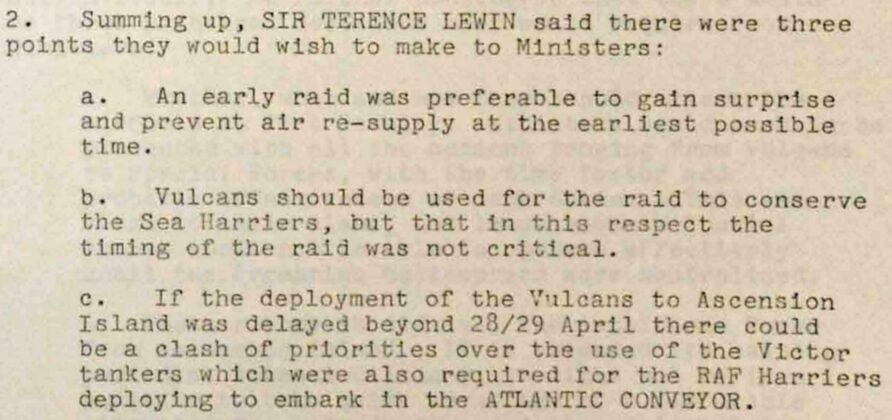
On the 24th April, the Official History records;
Intelligence indicated that there had been few improvements to the Stanley runway.
On the 27th, despite the advanced stages of planning and readiness, questions were still open on the raids, pages 38-41 of this document for example.
Because of the threat to the fleet and overall success of the campaign, a maximum effort joint operation was planned to put the runway and airport out of bounds for the Skyhawk’s and Mirages, regardless of whether the Argentine forces could, or intended to do so.
Despite concerns and misgivings, the service chiefs agreed that the attack stood a reasonable chance of success and that it should happen as soon as possible.
Once the diplomatic efforts by Haig had played out, the political path was clear for Black Buck and other offensive operations to commence.
Whilst the politics were settled, the operational matters were not.
Further debates ensued about the use of Sea Harriers for runway denial, based largely on a lack of understanding of the Vulcan’s capabilities and overestimation of the Sea Harriers capabilities. Issues of post-raid bomb damage assessment, the potential use for Vulcans in the anti-shipping role and concerns about Sea Harrier preservation also seemed to have been a cause for discussion and disagreement.
Accusations of the RAF not appreciating the capabilities of the FAA and the FAA not appreciating the capabilities of the RAF were detailed in the Official History.
A toxic mix of opinion and personality made decision-making difficult.
But ultimately, the Vulcan raid had both military agreement (CDS and Task Force Commander, both RN officers) and political approval (War Cabinet), without both, it would not have happened, it is as simple as that.
To the accusation of the RAF ‘muscling in’
Surely, all three services wanted to get stuck in, by all and any means, there were even several attempts by soldiers to stow away on ships before they departed.
Observation number three;
Black Buck was clearly an RAF suggestion and was pushed forward as an option because, obviously, the Vulcan was an RAF aircraft.
The option was considered in a joint decision-making framework and, ultimately, authorised by the War Cabinet on advice from the Chief of the Defence Staff. It would not have reached that far unless it was also agreed by the Task Force Commander, an Admiral of the Royal Navy.
Simply put, it would not have happened unless everyone agreed. It also seems to me that despite the obvious main task at hand, there was a degree of post-conflict positioning from all three services.
Glasshouses and all that.
Any objective analysis of the conflict would conclude that inter-service rivalry on both sides produced adverse outcomes.
Argentine Intentions and Actions for Runway Development and Fast Jet Operations
Despite professional advice to the contrary, the UK intelligence assessment was that Argentina could operate fast jets from Stanley and that this would be a grave threat to contend with, but what were Argentina’s intentions.
There are many conflicting accounts of Argentine forces intentions for the runway, and specifically, operating fast jets (apart from the MB339).
One account describes how a Canberra mission to South Georgia was planned for the 26th of April 1982 that would involve landing and refuelling at Stanley Airport, implying both intent and capability to do so.
The mission was aborted because of the proximity of the Royal Navy task force.
There is anecdotal evidence that AM2 panels were loaded on the Rio Cincel and transported to the Falkland Islands between the 7th and 10th of April, which would, at least, suggest some intent to develop Stanley Airport and this may well have formed part of the UK intelligence assessments described above.
In the declassified Rattenbach investigation report into the conduct of the armed forces and government of Argentina during the conflict, there is a small section on the runway, item 623, here (thanks to SP for the translation)
Regarding the enlargement of the Puerto Argentino RWY, major measures were taken in order to improve the airfield in order to be used by attack aircraft; while materiel for such works was allocated, only part of it was transported to the Islands due to the blockade (see the case of M/V ELMA Cordoba), and even that partial shipment was not unloaded on time. Nevertheless, (the AAF?) Should have stressed within COMIL (The Military Committee) on this aspect of aerial warfare, which fell under its exclusive jurisdiction
It would seem there was intent and, at least, some preparation to embark the necessary equipment and personnel.
We also know that some AM2 did arrive at the Falkland Islands, joined by that already there, leftover from the Hookers Point airstrip.
The AM2 was used to provide aircraft parking but whilst some claim that a 200m extension was created by Argentine engineers this seems implausible, given the soil engineering challenges we know from post-surrender surveys.
The three images below, all taken at Stanley Airport after the invasion, but before May, show AM2.
ONE; the Fokker F-28 TC-53 that was damaged and parked to the east of the runway, some time after the 18th of April
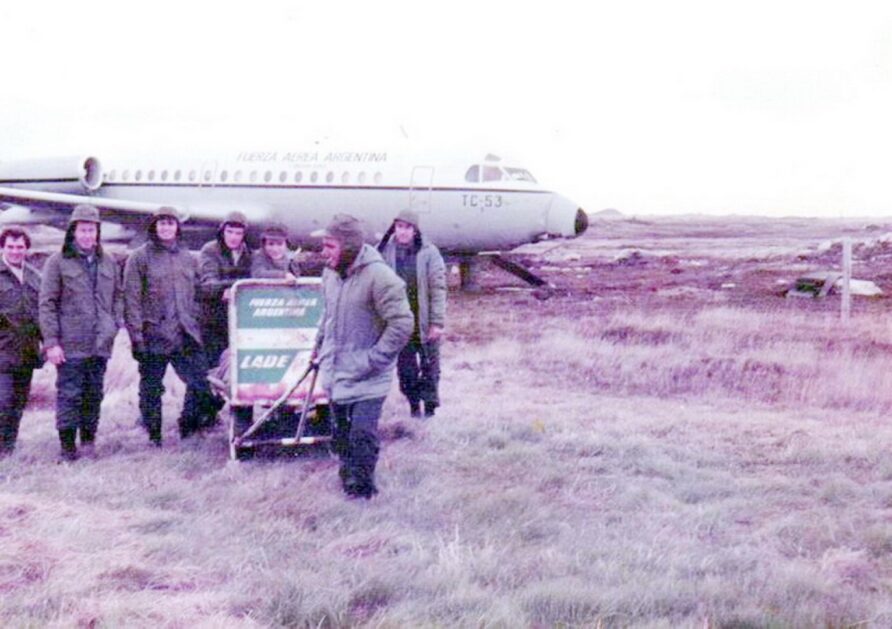
TWO; Aircraft parking for the MB339 of Lt Crippa
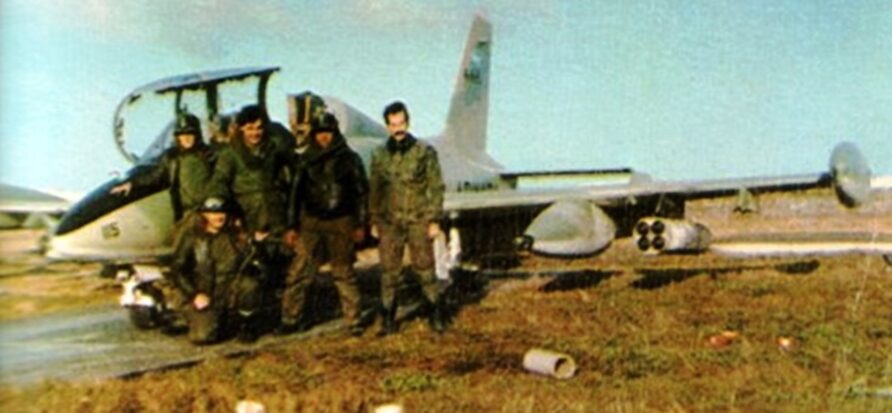
THREE; an image of a Puma sling loading fuel drums.
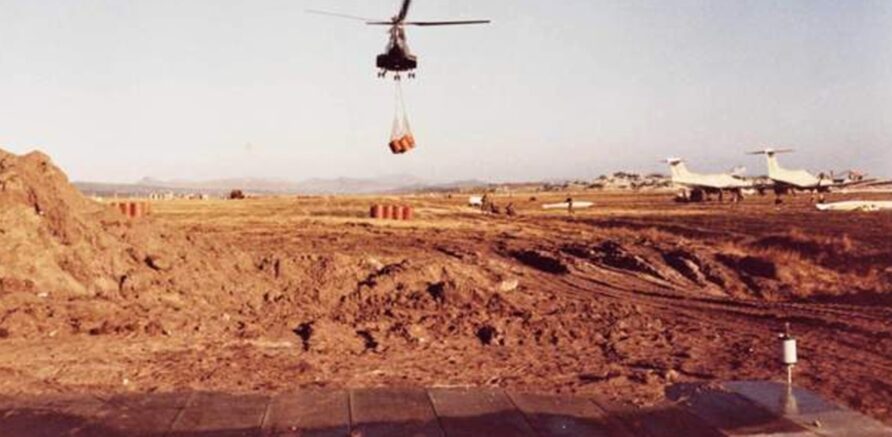
There is more evidence that the FAA also practised ‘touch and go’ landings with Dagger’s at the airfield at the Rio Grande on a simulated runway of the same length as Stanley.
In a paper for the USAF Air University, Argentina’s Tactical Aircraft Employment in the Falkland Islands War, Gabriel Green USAF stated;
While maintenance worked on the modification, the pilots worked on employment options. This included practice of short-field takeoff and landings to determine if sustained operations from the 4100-foot runway at Port Stanley were feasible. They learned it would only be suitable for emergency landings
In another paper, The Falklands 20 Years On, Phillip Grove, stated;
More importantly, Argentina had no intention of using fast combat aircraft from the runway following tests earlier in April
Quoting Anderson in a US Naval Postgraduate School paper called The Falklands War Understanding the Power of Context in Shaping Argentine Strategic Decisions, Scott Nietzel stated;
Argentina had ample supplies of steel matting and enough time to ship it to Stanley, but when Air Force engineers studied the practicalities they decided it would be too difficult to sustain high-performance jet aircraft from such a primitive airfield
Scott also goes on to argue that it was a complete lack of inter-service cooperation and joint decision-making that caused the Argentine forces to make so many strategic blunders, including the failure to better exploit the runway at Port Stanley Airport.
Citing Arquilla and Rasmussen, he wrote;
Some evidence exists that the FAA refused to base out of the islands because it would have come under some degree of Navy operational control. Indeed, Admiral Carlos Busser, who led the invasion, points out the FAA pilots rebelled at this notion, even to the point of refusing instruction from naval aviators in how to attack ships at sea
Putting these fragments together and if I were to hazard a guess, it would be that Argentine forces did have an initial intent to use Stanley as a limited base for defensive and offensive counter-air, possibly even some strike missions.
But, this intent was gradually eroded by a combination of factors;
Wider analysis and calculation of runway length, fuel, and weapon loads for the aircraft concerned vis a vis landing and take-off distances, weather predictions and runway strength,
A more detailed survey following the invasion in early April that would confirm soil conditions to the West of the runway were extremely poor and would require removal of large quantities of peat and sand
Availability of engineering plant and personnel to complete the required groundworks, and
Consideration of fuel requirements to sustain fast jet operations
After the attacks on the 1st of May, these factors would be joined by security, the need to marshal and preserve combat airpower and deteriorating weather (which makes fast jet operations less safe at the extreme limits of runway length).
The AM2 was by then available on the Falkland Islands, as discussed above, some new and some ex Hookers Point. Some work on a runway extension was started but stopped after the 1st of May.
From the Zona Militar forum, an eyewitness account;
In the western end some of them (the plates) were placed but when the raids started, works were abandoned, many of them were used to reinforce the positions. Thank two of them I´m alive at the moment, as they stopped shrapnel direct right on my head in the night of 29
We can also see AM2 panels being used after the surrender, as shelter materials.
It may be that BAM Malvinas was not intended for ‘operating fast jets’ but as a divert location or ad hoc forward arming and refuelling point. That an attempted emergency landing, rather than eject nearby, was attempted (before being shot down by his side) might add some weight to this theory.
The impact of Black Buck I AND the Sea Harrier/NGS attack on the 1st of May would have just put the cherry on top.
This is as far as Argentine forces got to operate fast jets (not including MB339) from Stanley Airport.
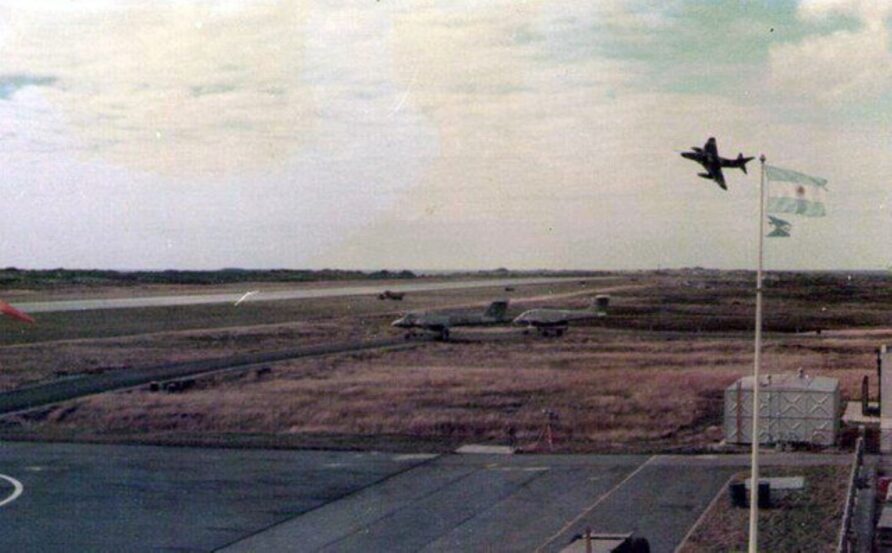
Observation number four;
Argentine forces did seem to make some plans to develop and use the airport at Stanley for more aircraft types than they eventually did, but these plans were gradually changed over time as more information became known and circumstances changed.
What plans had started to be implemented were abandoned, and the materials (existing and shipped in) were used for general construction purposes.
Could the runway have been used by fast jets in any event?
Although an academic exercise, it is worth exploring whether the runway at Stanley Airport could have been used to support the operation of Argentine fast jets, apart from the MB339.
The advice to the Air Staff from the Royal Engineers Staff and Railway Corps was that it could not, two factors precluding it, runway length and pavement strength.
We know from UK experience, that only Harriers could use the runway, Phantom operations required improvements in both length (including arrestor gear) and strength, but Argentina did not operate Phantoms.
Runway Length
The Commando de Aviación Naval Argentina – COAN (Argentine Naval Aviation) operated Aermacchi MB.339A, McDonnell Douglass A-4Q (B) Skyhawk and Dassault Super Etendard, Grumman S-2E Tracker, Beechcraft T-34C Mentor, Fokker F28 and Lockheed L-188 Electra aircraft. From photographs and other documents, we know that of these, all but the Super Etendard and A-4Q Skyhawks operated from the runway at Stanley Airport.
Fuerza Aérea Argentina (FAA) and Aerolíneas operated C-130H Hercules, Boeing 737, Boeing 707, Fokker F28, Fokker F27, English Electric Canberra, Learjet 35A-L, FMA IA 58 Pucara, McDonnell Douglass A-4C Skyhawk, McDonnell Douglass A-4P (B) Skyhawk, IAI Dagger and Dassault Mirage IIIE.
From photographs and other documents, we know that of these, all but the Canberra, Skyhawks, Daggers and Mirages operated from the runway at Stanley Airport.
Knowing this allows comparisons to be made.
Of the Skyhawks, all were the B versions, except the C, the P and Q being designations specific to Argentina, even though they were the B variant.
The specification sheet for an A4-D had a slightly more powerful engine than those in Argentine service, but it is still good for comparison and has a number of flight and load profiles.
The aircraft datasheet shows that an A-4D can take off at sea level with zero headwinds, two 150 gallons (ca. 682 l) drop tanks and two 1050lb (ca. 476 kg) stores in 3,050 feet (ca. 930 m) in a sea-level delivery profile.
A number of other profiles and wind conditions are shown, but most of them are within the runway length at Port Stanley.
Landing distances are also within the length of the runway.
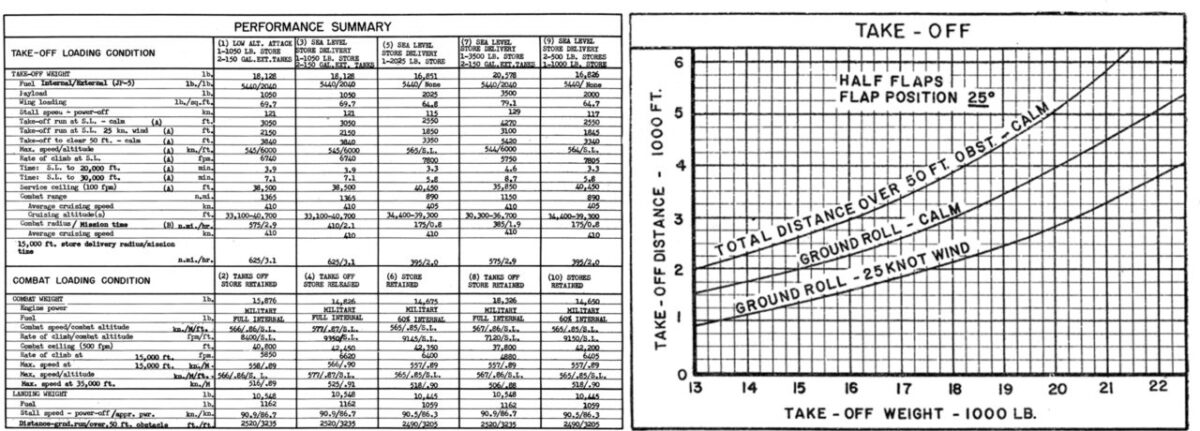
Weather conditions, especially crosswind, runway drainage, landing aids availability, the slightly lower power output of the Argentine A4’s and other factors might still have made it not possible, there is always more to something like this than a simple table, but this information would have been available to UK planners.
To be clear, I am not saying they could or could not, but looking at the table, it does seem like a possibility, at least on runway length.
For the other aircraft, Mirage IIIEA and Dagger (IAI Atar 9C engine Mirage V), information online indicates that Stanley Airport would be extremely marginal, leaving no room for error or poor weather.
Pavement Strength
Most people who have looked at this online have tended to concentrate on runway length as the single determinant of fast jet operability, but pavement strength is equally important.
From the intelligence report reproduced above, the runway at Port Stanley Airport was a minimum of LCN 16 and up to LCN 30 in places, unhelpfully, it doesn’t specify which places or whether LCN is LCN or LCN/LCG (they are not the same).
The RE paper repeats this but doesn’t shed much more light on the subject except that in planning for post-conflict operations from Port Stanley Airport, the RAF specified Phantoms and Buccaneers were LCN 45.
i.e. much higher than 16
The Phantom and Buccaneer were much heavier than the Skyhawk and other Argentine aircraft, but the weight is not the only factor in matching runway LCN’s with aircraft, and what is an LCN anyway?
The British Load Classification Number (LCN) is a system devised in the mid-sixties to codify runways and other load-bearing surfaces at aircraft operating locations.
Simply put, if an aircraft’s corresponding LCN is smaller than the LCN of the runway, it is safe to operate without any risk of deformation.
LCN was based on the Load Classification Group (LCG) devised by the ICAO, but it does not consider the differences between concrete (rigid) and asphalt (flexible) surfaces and was replaced by the ICAO (and pretty much everyone else) in 1980 with the Pavement Classification Number (PCN) /Aircraft Classification Number (ACN) system that provides information on both types of the runway and tire pressures.
LCN is also relatively imprecise.
The airport today has its Pavement Classification Number defined as 14 FCXT
The first two characters are the PCN, followed by four letters which denote the pavement type, subgrade bearing strength category, maximum tire pressure and means of evaluation, which is 14 / FLEXIBLE / SUBGRADE CATEGORY C (LOW) / MAX TIRE PRESSURE 217 PSI / TECHNICAL EVALUATION.
If the ACN is lower than or equal to PCN, the aircraft can operate without restriction (depending on runway length and other factors). Exceeding them would result in cracking or deformation of the runway.
There are no simple methods of converting between LCN, LCN/LCG and the newer ACN/PCN systems, but we can apply some rough comparisons and draw simple conclusions. We know that F-28’s, 737, Hercules and Electra’s operated from the LCN 16 runway during 1982 and these have ACN’s that match a PCN of between 9 and 20, the PCN being extrapolated to a flexible surface and category C bearing strength.
We can’t be certain that in 1982 the runway had the same bearing strength as it does today, but by selecting the current ‘LOW’ figure, we can at least err on the side of caution.
NATO does publish the ACN for various aircraft, a 2010 edition is here
Have a look for yourself.
Observation number five…
I have taken some giant liberties with what is a very technical and complex subject, but it would appear that the lightweight A4 Skyhawk, based only on pavement strength and runway length, could have operated from Stanley Airport with some augmentation and absolutely minimal weapons payload and fuel, but it would be marginal.
Mirage and Dagger, based on the same assumptions, and backed up with FAA decision-making, would be highly marginal, dependable on good weather and pretty unsafe in anything but the most benign conditions.
There are other factors to consider, none of which point to an answer that contradicts the Royal Engineer’s advice on viability.
Effects on the Runway
There are claims and counter-claims about where the bombs hit; various combinations of the words’ centreline, ‘runway centre’, ‘runway edge’ and ‘clipped the runway’ appear in articles and books.
Aerial reconnaissance images also stand accused of being manipulated and even if people do accept that the runway was hit by Black Buck I, often, they claim that in any case it was repaired quickly.
Some even claim it did not hit at all.
Lt Col Ewen Southby-Tailyour, in his book, Reasons in Writing: A Commando’s View of the Falklands War, stated that he was unable to find ‘any sign of their vaunted crater’
Did Black Buck I hit the runway?
The strike was designed to straddle the runway at a specific angle to improve the statistical chances of achieving a hit.
The angle of attack and release interval was such that it was extremely sensitive to timing and as can be seen from the image below, it was close, a fraction of a second earlier, and it is likely that two direct hits would have been achieved.
Post-raid photographic reconnaissance by the Sea Harriers was required to provide a counter to potential Argentine propaganda that the RAF was indiscriminately bombing civilians and to assess the damage but was made difficult by cloud cover, a lack of training and interpretation facilities, it did happen, though.
According to the Official History of the Falklands Campaign, Vol. II
Visual assessment, however, was ‘a long scar 250m long 70m wide across the airfield straddling the centre of runway north-east-southwest with three apparent craters, one on the runway, and one each side’.
Follow-up Sea Harrier raids, which destroyed the two Falkland Islands aircraft that had been captured by the Argentines, were also difficult to assess due to bad weather, but the ‘general observation was the area devastated’
The day after, Rear Admiral Woodward submitted the following report;
The Vulcan attack made a single crater with the first bomb halfway down the runway just south of centre, remaining bombs landed over to SW over 1000m run without further damage. 3×1000-lb retard bombs laid down by one SHAR during suppression attack all hit the runway centre line causing damage over 150m in the area of Vulcan hit.
Other damage done in stores and dispersal area at west end of runway by cluster bombs
In response to the claim from Ewen Southby-Tailyour, writing in the Telegraph;
RAF hit the target. Sir – Ewen Southby-Tailyour (Letters, May 5) is wrong in his description of the damage to the Stanley runway. As Commander, Royal Engineers, I was responsible for its repair immediately after the surrender.
There was one large crater caused by a 1,000 lb bomb from the RAF Vulcan raid, and four smaller craters resulting from earlier Harrier attacks. (The Argentines had also created dummy craters to confuse our aerial reconnaissance.) Repairing the large crater and the large area of runway took about two weeks and 1,000 square metres of captured Argentine runway matting.
Lt Col Southby-Tailyour is, however, correct in stating that Argentine aircraft were able to continue to use the runway, despite the bombing raids, by temporarily backfilling the craters.
This, perhaps, is why his “recce” did not spot the true extent of the damage.
An Institute of Civil Engineers Paper called Military Engineering in the Falkland Islands 1982-83 by Major General G. B. Sinclair, Brigadier F. G. Barton and Lt Colonel L. J. Kennedy, all Royal Engineer officers, stated in the section of the recovery phase;
The first task was to carry out a reconnaissance of the airfield and, in spite of it being a gigantic prisoner-of-war compound, this was started on 17 June.
There was a single large crater on the runway caused by a 1000lb bomb dropped by an RAF Vulcan, as well as other smaller craters and hundreds of scabs caused by rockets and cannon fire. A plan was devised to repair the northern half of the runway first, thus avoiding the Vulcan crater in order that Hercules could land as early as possible.
The craters had already been filled by the Argentines and work was limited to cutting out soft patches and heaved pavement areas around the craters and filling with waste from the old quarry. In addition, the asphalt surface was cut back to a size to accommodate aluminium panels left behind by the Argentines which provided a good surface.
The northern half of the runway was repaired in three days and the first Hercules landed on 24 June right on schedule.
The remaining repairs to the airport runway, including the large Vulcan crater, took longer but all emergency repairs were completed by the end of June.
This diary account from one of the MB339 aircrew discusses the impact (among other things) of the airstrikes.
We went out with Captain Anselmi in the jeep, and found the platform covered with shrapnel and the tails of beluga type grenades.
We went down the runway in the direction of the aircraft, and to our surprise, we discovered that a single bomb had impacted in the centre of the runway, on the southern side; the rest was OK, albeit dirty.
Where this gets interesting is trying to discriminate between the Vulcan and Harrier impacts.
The image is below.
This is the first reconnaissance image (rotated and cropped)
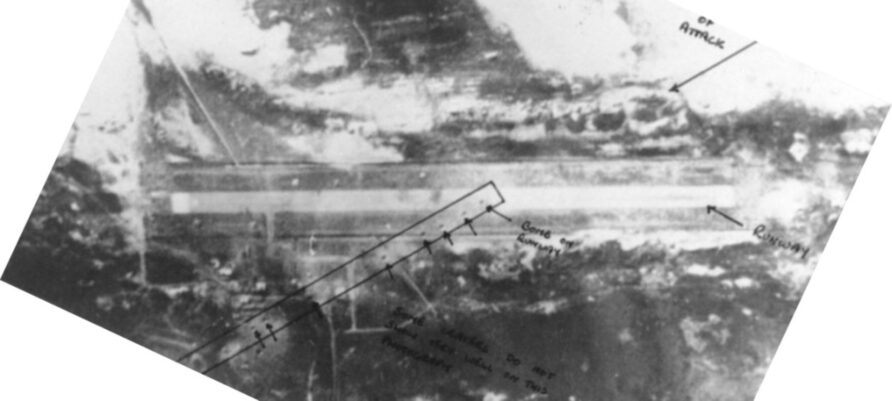
I have also marked, in red, two dark ‘patches’ on the north half of the runway.
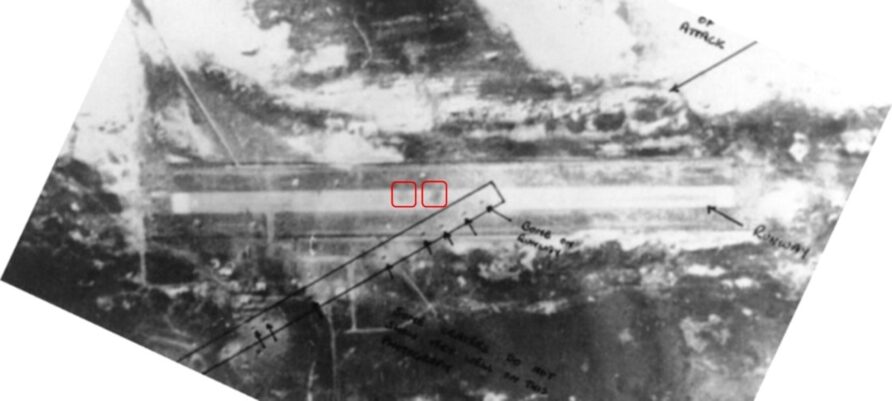
Below, is a side by enlargement.
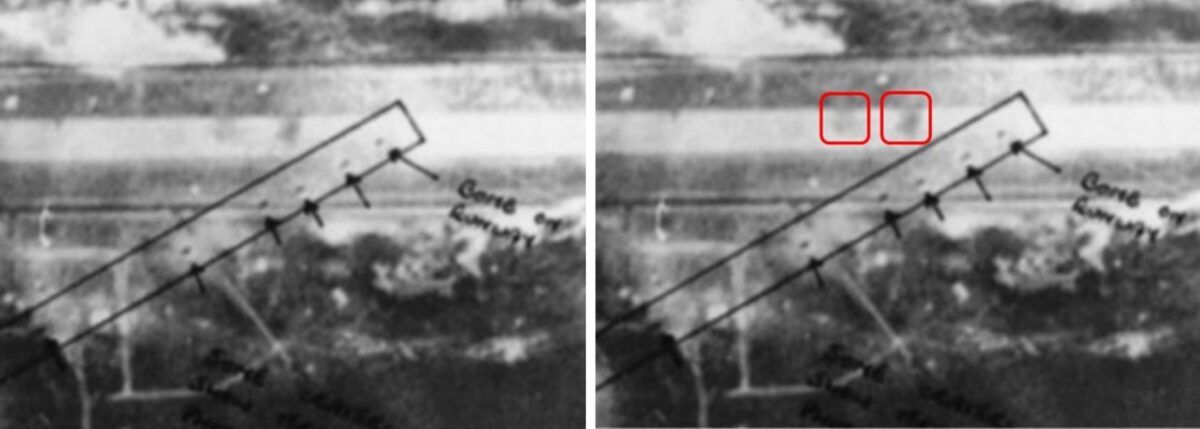
These images clearly show the first Black Buck I crater to be on the lower (south) half of the runway, and another three Black Buck I craters to be on the grass runway shoulder.
It also shows a crater to the north of the track to the south of the runway, before it changes direction.
For further comparisons, a set of spatial marker points are needed and the best source image for this is one taken by Argentine forces before May, reportedly, on the 18th of April.
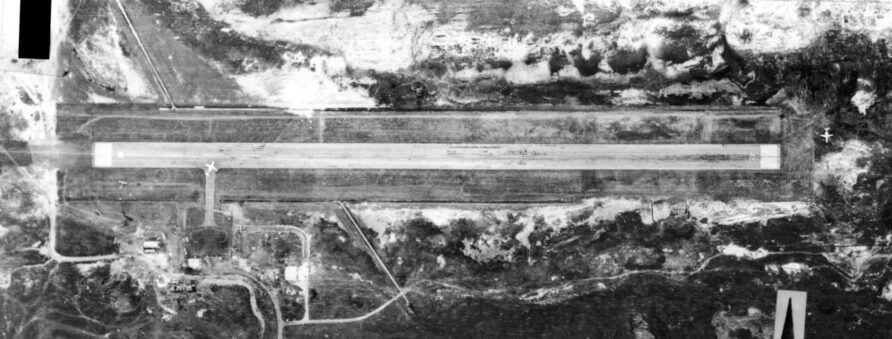
The reference points are;
1, Braithwaite water tank. 2, Diagonal track to the south of the runway. 3, prefabricated buildings to the south of the control tower. 4, Quonset. 5, control tower. 6, Pitched roof hangar
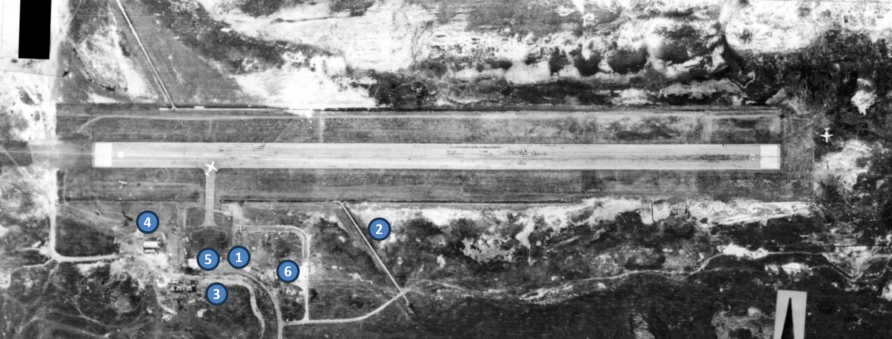
There were a number of additional Sea Harrier reconnaissance sorties following Black Buck 2 that were much clearer, and these can also be used to compare, using the reference markers established above.
IMAGE 1; Shows a large crater that has filled with water on the grass runway shoulder to the south of the runway, the camera is pointing to the terminal buildings and pitched roof hangar, establishing the crater on the south of the runway.
One of the civilian registered Cessna’s is shown and an MB339A, again on the south half of the runway. This may be one of the three Black Buck I craters shown in the images above.
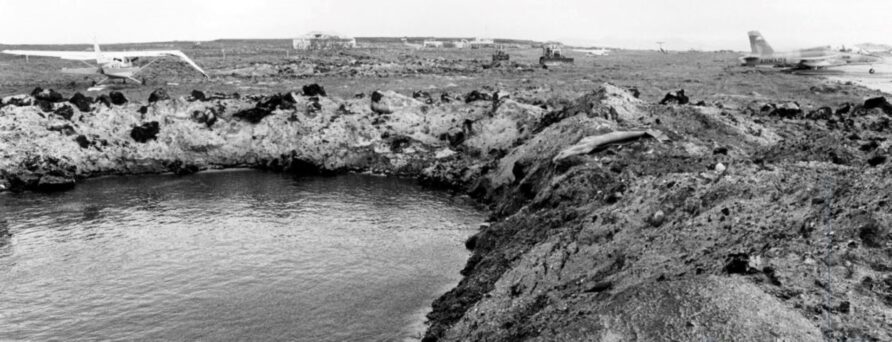
IMAGE 2; Shows another MB339A and Cessna, but the terminal building is on the far left and the image shows the Quonset hut, in Image 1 there is another Cessna with clear wing damage.
This suggests the image is on the south side of the runway but further to the west. It may be a perspective issue, but it is uncertain whether this is a Black Buck 1 crater.
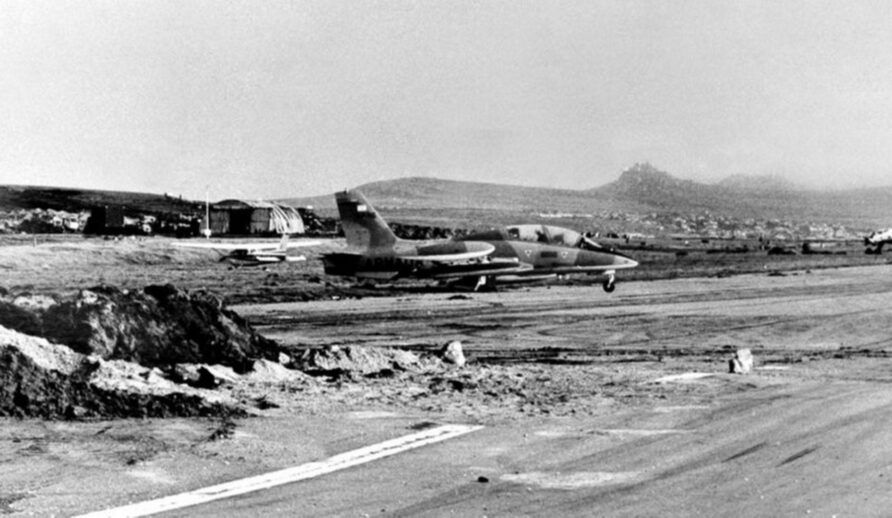
IMAGE 3; Perhaps the most interesting because it is labelled (not by me) as being from the first Vulcan strike, but zoom in to the right of the image and clearly shown, is an MB339A and Cessna, which, as has been established above, were on the south side of the runway.
This would suggest it is incorrectly labelled or there is some error elsewhere
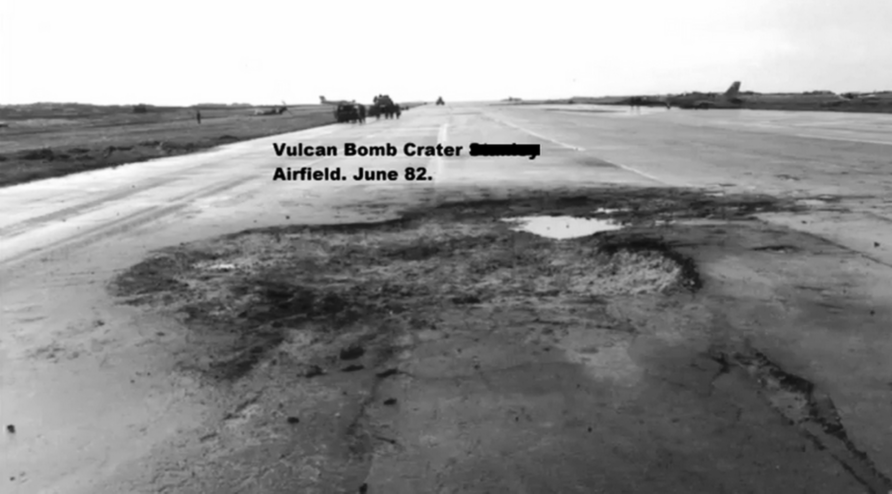
There are also a number of published impact diagrams from various sources.
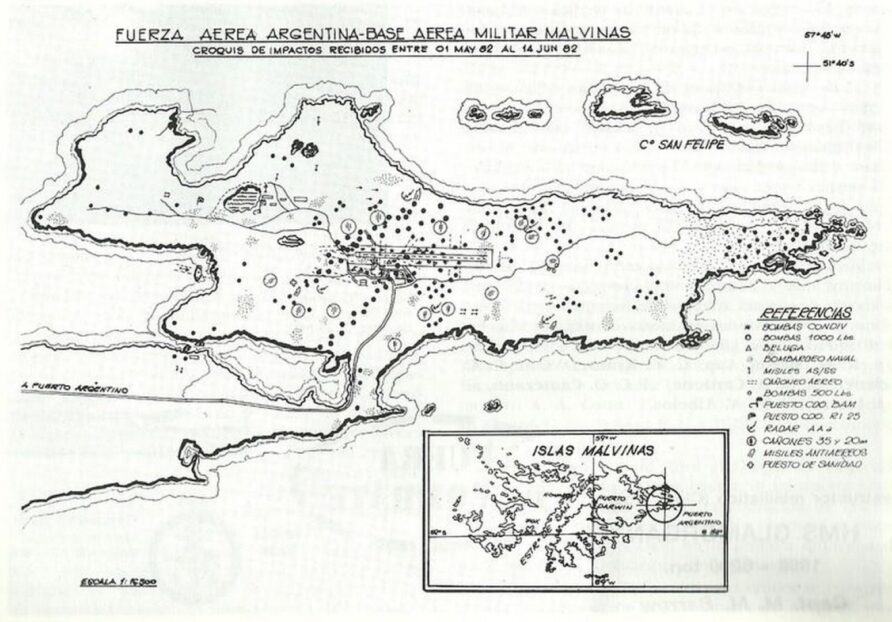
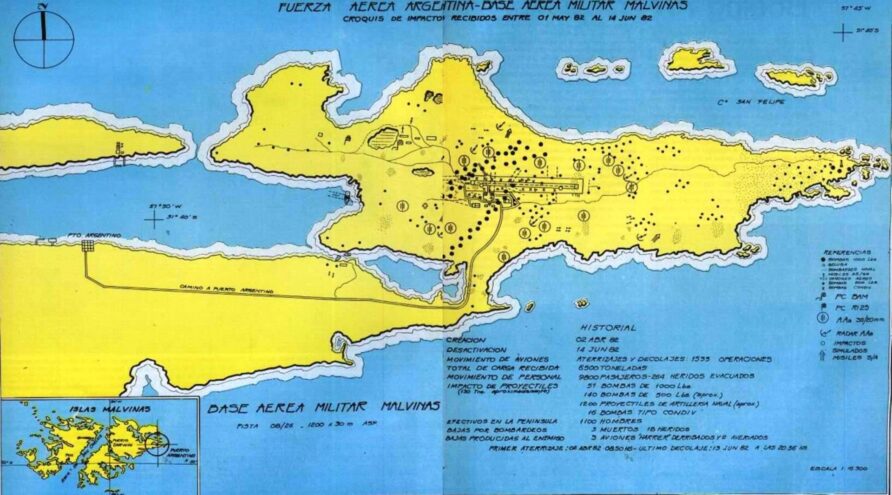
I have seen these images in several places, different versions claim to show each impact and whether those impacts are from 1,000-pound bombs, 500-pound bombs, or combinations of rockets and cluster bombs.
It also shows the location of the two decoy craters, one at each end of the runway, but curiously, does not show any impacts on the northern half of the runway.
In post-conflict images, there are what look to be significant repairs in progress with the group of Pucaras in the background, to the south of the runway. The Harrier take-off strip is shown parallel to the runway, to the north.
This places the repair activity (shown below) on the northern half of the runway, this not being shown on the impact diagram.
My suggestion is that the images of repair activity above are the result of a Sea Harrier crater, shown in the first images with red squares, not a Vulcan crater.
The highest-resolution image I could find is ‘post-Black Buck 2’, am not sure of its origin, but enlarging it does show the craters, temporary repairs and dummy craters, obviously.
Original
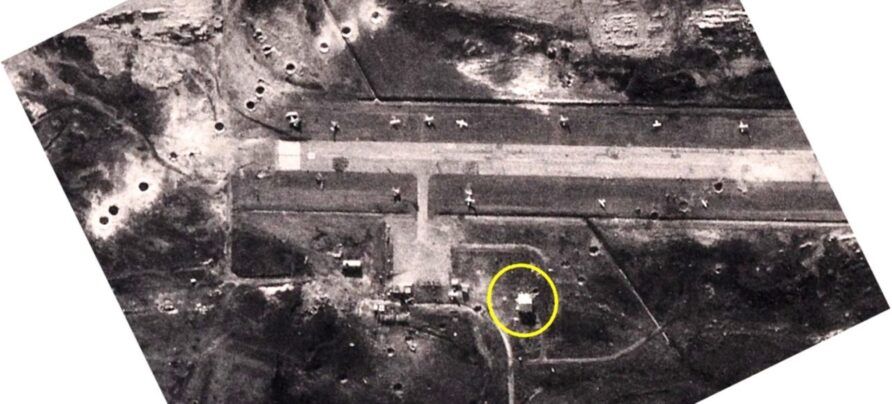
Enlargement 1 shows the Vulcan and Sea Harrier craters.
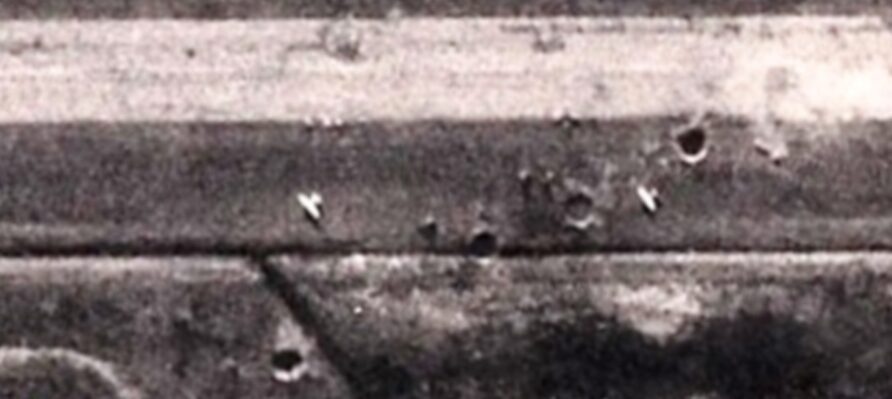
Enlargement 2 shows the dummy crater at the west of the runway.
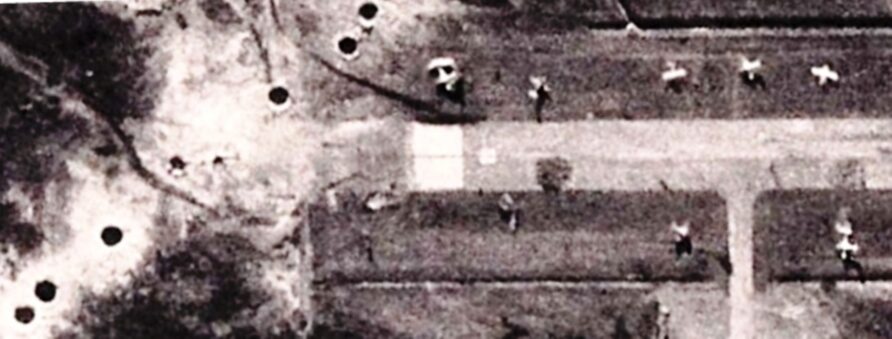
The image below is from current mapping; Google Earth and Bing Maps

You can click the sites to have a pan and zoom, several craters are still there, water-filled now, of course.
The remains of the runway extension and many buildings from RAF Stanley are clearly visible.
When Mount Pleasant became operational and RAF Stanley became Stanley Airport again, the AM2 was lifted and eventually, some resurfacing work was completed.
They also did not resurface the full width of the runway, again obvious from the image above.
This means the original runway surface is still there, the new surface in the middle.
Drawing a straight line (blue) through the existing craters to the south of the terminal buildings and extending that line to the runway leads to an area of the runway that is not the same colour as the existing runway, i.e. a repair.
The line also neatly travels through the crater to the left of the diagonal track and on the edge of the grass area, all in the pictures above.
This leads me to believe that the dark patch is probably the Black Buck I crater.
Both of these notes (from the Margaret Thatcher Foundation) are dated 10th May 1982.
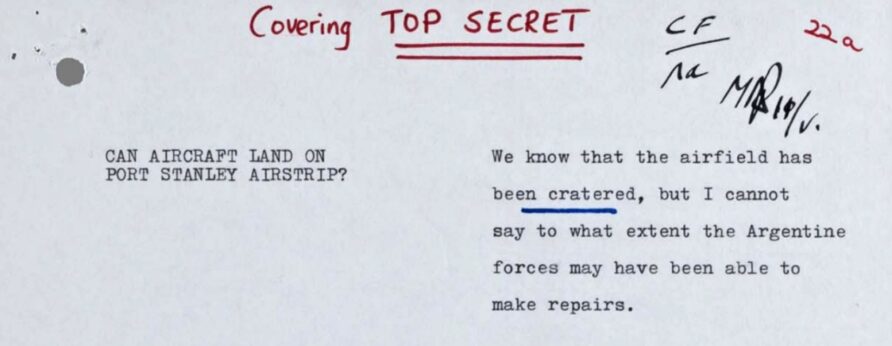
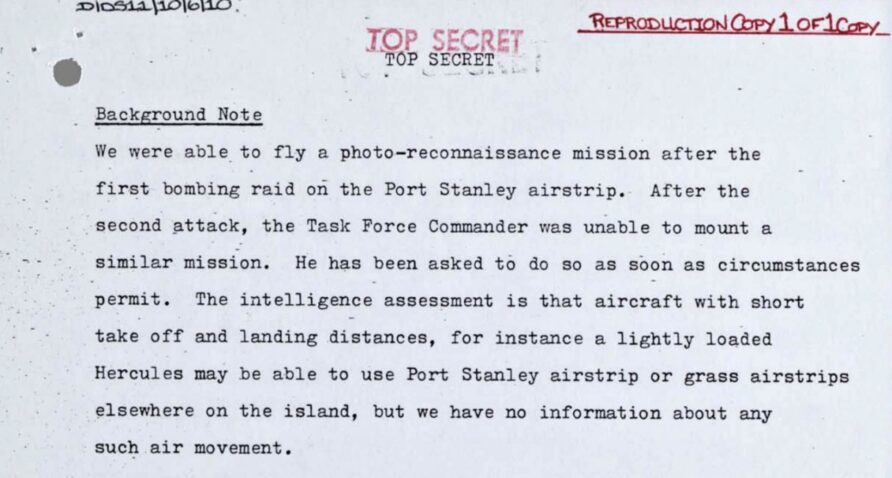
They show a high degree of confidence that the runway had been cratered but not certainty about repairs, the second note shows an intelligence assessment that lightly loaded Hercules would still be able to use the runway, a correct assessment, as we know.
This also raises the issue of Black Buck 2, carried out on May the 4th.
It is claimed that the aim of the mission was to ensure an extension to the runway could not be made.
If the assumption was that the main runway had been cut in two by Black Buck 1 and the primary objective achieved, why make post-conflict reconstruction more difficult than it needed to be by hitting it again?
Black Buck 2 had the added disadvantage of the enemy being fully alert and aware of Vulcan attacks.
Although Black Buck I was detected, confusion, inexperience and possibly, Rules of Engagement, prevented the ground-based air defences from firing. That mistake was not likely to be made again.
In the Official History of the Falklands Campaign Volume II, Laurence Freedman stated [on Black Buck 2]
but the higher altitude adopted, to stay clear of Argentine Roland surface-to-air missiles, meant that the attack itself was less successful
He also added that there was frustration about the bombs missing the runway.
This adds some element of doubt on the intended target for Black Buck 2.
However, this briefing note from the 4th of May does seem to confirm that the intent for Black Buck 2 was to prevent repairs.
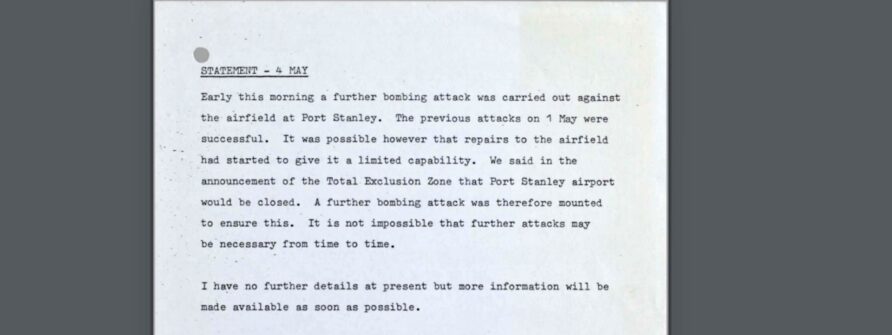
Black Buck 7 was intended to destroy stores and troops in the open using an airburst fuze setting, and it is widely reported that an error meant the bombs exploded on impact, to the west of the runway.
The point here is that war is waged with machines, not by machines.
It is a very human endeavour, replete with human error, something all three services are more than familiar with.
To add to the controversy surrounding Black Buck 7 is the apparent lack of bomb craters, leading some to speculate that they failed to detonate at all.
Adding yet more fuel to the fire is the Argentine bomb damage maps that seem to show two lines of 1000 pound (ca. 454 kg) bomb craters, the second close by those made by Black Buck 2.
Black Buck 7, a note from the archives.
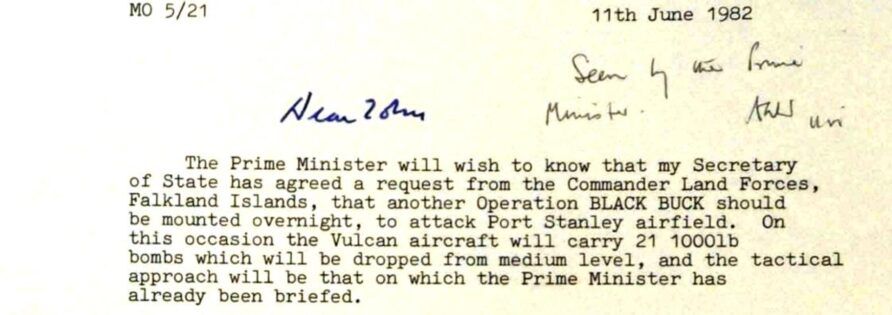
Interesting to note where the request came from.
There are a number of confusing and contradictory statements and images above, no clear picture would seem to show the Black Buck I runway crater, although the various report extracts clearly indicate that there was one, in the centre of the southern half of the runway.
Those images describing themselves as Vulcan craters are not, they look like they are the Sea Harrier craters as described by the bomb-damage assessment report and the Inst. of Civil Engineer’s paper.
These both suggest the Sea Harrier strikes on the northern half and that these were easier to repair with quarry materials and AM2 panels to allow Hercules flights 10 days after the surrender.
This does raise a question, though, if the UK could not land a Hercules until after the northern half of the runways craters could be repaired, how did the FAA manage to land its Hercules continuously since early May?
I put this down to the acceptance of the risk between peace and war.
During the conflict, the FAA would have accepted greater risk to aircraft and personnel. UK forces, post-surrender, were not prepared to accept that risk, rightly, and so a higher standard of repairs was needed before RAF Hercules operations could commence.
One can also imagine an aborted landing due to weather would be less of a problem for an FAA aircraft, it would have enough fuel for the return to the mainland, an RAF Hercules would not.
Runway Repairs
A bomb crater is not just a bomb crater and not only will the weight of the explosive have an impact (sorry about that) on damage, but so will angle of impact, fuzing, soil conditions and other factors.
A thousand-pound bomb from a Vulcan may well have different terminal effects than the same thousand-pound bomb dropped from a Sea Harrier.
The images below, I think, show the Black Buck 2 craters to the northwest of the airport because they are in the soft soil they do look rather deep!
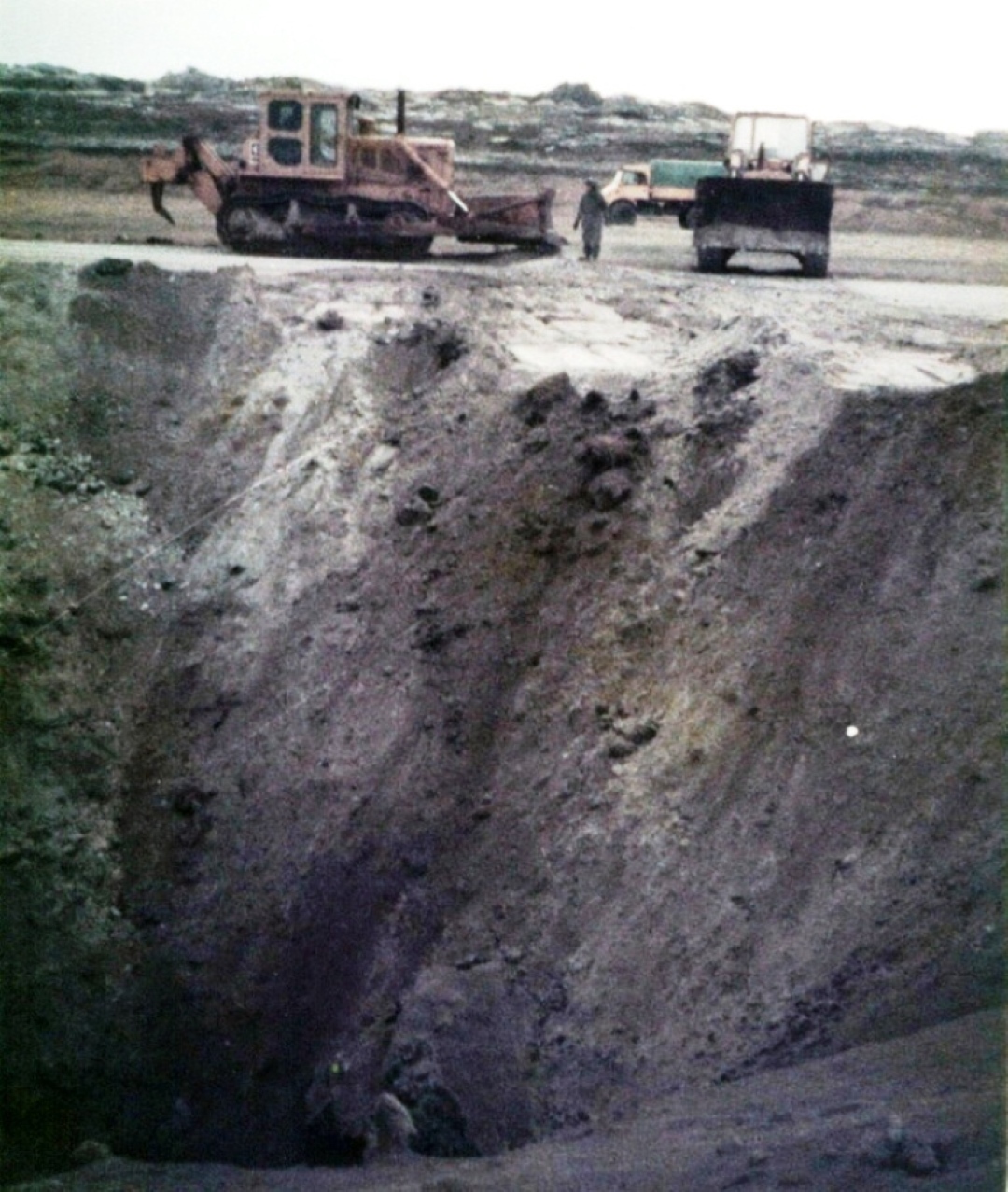
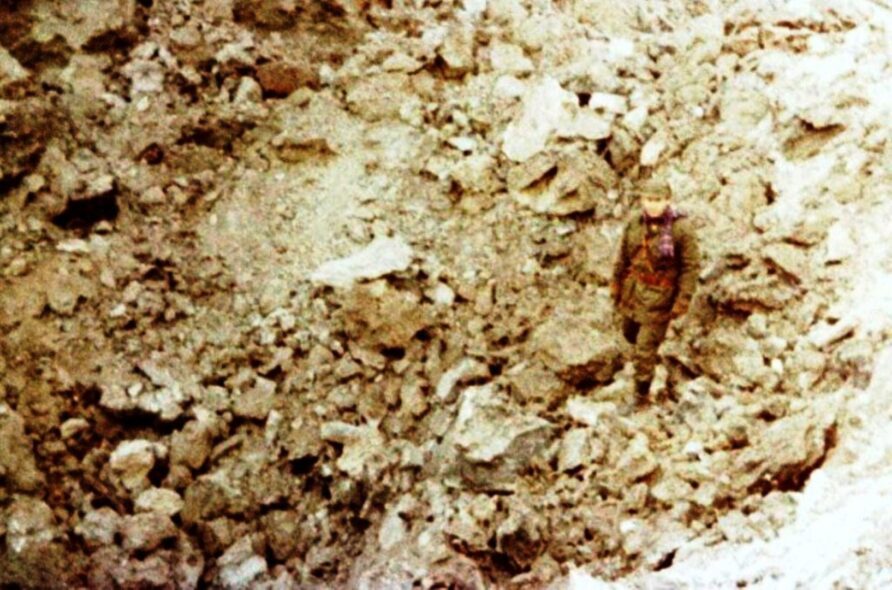
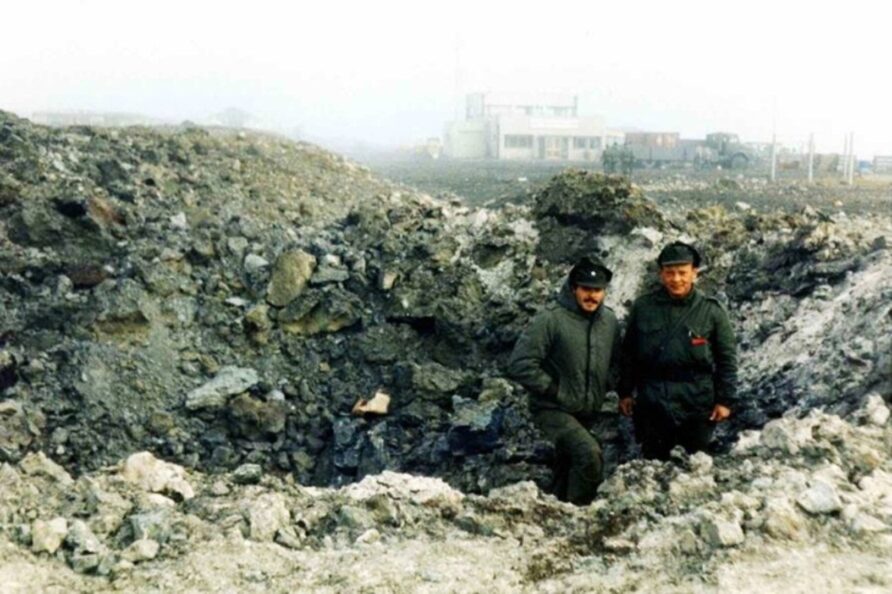
The Royal Engineers report was clear about the repair requirements for the different attacks, Sea Harrier and Vulcan, and that Argentine engineers had made rudimentary repairs to all of them.
Shallow scabs from rockets, cannon fire and cluster bomblets were repaired with a rapid setting magnesium phosphate cement grout called Bostik 276, but the craters were a significantly different challenge.
As can be seen from the simplified diagram below, a typical crater will contain material that has fallen back from the initial explosion and a rupture zone of disturbed soil; and on the surface, adjacent to the crater, will be ejected material.
Paving materials will be included in the ‘fallback’ and ‘ejecta’.
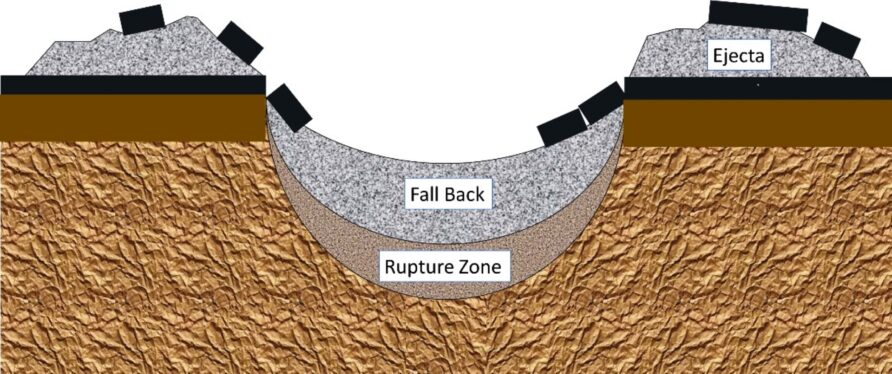
As can be appreciated, upon initial examination, and depending upon the amount of fall back, the crater can appear much smaller than it actually is.
There are two conventional methods of rapid crater repair, the clean bowl and dynamic compaction techniques.
The clean bowl technique requires the damaged paving to be cut back, fall back removed, and the crater excavated back to the rupture zone. In short, making the bowl larger than it initially appears.
The ‘clean bowl’ is filled with graded aggregate and the top layer of finer material is applied. The top layer is then levelled and compacted with a vibratory roller. Finally, a pavement replacement is applied, usually, bomb damage repair mat of some kind.
Dynamic compaction involves pushing all the ejected material into the crater and adding additional graded aggregate if needed.
The material is then compacted using a vehicle high-speed hydraulic hammer and a pavement replacement applied, again, usually a bomb-damaged repair mat.
Neither technique was performed by the Argentine forces, it seems they simply pushed the ejected material back into the crater because there were no vibratory or compaction items of plant available. The Royal Engineers, initially limited by the availability of materials and equipment, carried out the clean bowl technique and used Argentine AM2 panels, after cutting back the pavement and excavating the crater.
As can be seen from the crater repair images above, there is a vibratory roller being used.
A crater in soft soil is much easier to fill and compact to the same density as one on hard soil.
What is important to note is that whilst pushing the ejected material back into what seems like a small crater will produce a repair of sorts, it will not be reliable or match the bearing strength of the surrounding surface. If it is not compacted to the same density, settling will occur and bearing strength reduced.
As the repaired surface is trafficked, this will get worse.
But, if one has nothing apart from a couple of bulldozers, it is all that can be done. Argentine forces did not bring any heavy plant with them, relying on what was there.
This showed poor planning, Stanley Airport was an obvious target and better provision should have been made. That said, the repairs they carried out were sufficient for the transport and light aircraft such as the Hercules and Pucara.
Observation number six…
Although much of the published imagery and available documentation lacks provenance and is contradictory in parts, the sheer amount of it, and several other authoritative sources, all point to Black Buck I hitting midpoint on the south half of the runway with a single 1,000-pound bomb.
Three also hit the grass verge to the side of the runway. Sea Harrier strikes hit the runway on the same day. Taken together, the damage was considerable, despite dummy craters and initial appearances.
The target for Black Buck 2 remains unclear, although the logic for its location is obvious. Black Buck 7 remains controversial, but the evidence does exist for impacts and if human error was to blame for fuzing issues, so what, war is a human endeavour.
The raids forced Argentina to redeploy fighters jets
The generally accepted wisdom is that Black Buck 1 and 2 forced Argentina to redeploy fighter aircraft to protect Buenos Aires because of the threat posed by Vulcans. Thus, the task force was spared attacks by those same aircraft. Various documents claim a squadron and others, squadrons.
There is some anecdotal evidence from Argentine sources that a squadron of Mirage IIIEA from 8 Grupo redeployed, and importantly, redeployed because of Black Buck.
Others refute this claim.
Whilst there may have been some desire to keep options open and keep Argentina guessing about attacks on the mainland, in private, the reality was very different.
This note (Page 50) from the Margaret Thatcher archives describes the position as at the 24th of April.

By mid-May, it was still on the table but not in any serious manner (see the section on fuel, below)
The key question here, though, is did Argentina know this?
The Total Exclusion Zone had been declared, but this was to the 12 nautical mile limit and although there was plenty of speculation in the media, I am certain the Argentine government would have had to make many calculations about intent and risk.
They knew full well that Black Buck I comprised a single aircraft and could relatively easily have done the calculations on fuel demand.
The threat was therefore from a few RAF aircraft that would have very little military value. If one reads the Margaret Thatcher archives during this period, it is clear that rules of engagement and legal issues dominated the thinking and diplomatic discussion.
There are several instances where the destruction of the Argentine aircraft carrier was considered but discounted time and time again because it was so far from the Falkland Islands we could not claim this fell under UN Charter Article 51, the right to self-defence.
Because a state of war did not exist between Argentina and the UK, and would not be, the legal situation for the UK, at a time when it enjoyed excellent worldwide support, would have been irreversibly harmed by committing such an act.
We would no longer claim self-defence and would be at war, without the declaration of such.
Argentina would easily have made the same calculation and drawn the same conclusion as us.
From a political perspective, I find it difficult to believe that the Argentine government thought an attack on the capital by RAF Vulcan’s was even remotely a possibility.
That said, for the same reasons that we mounted the Black Buck operations, risk mitigation, there might still have been a prudent reaction, a repositioning of a modest force and other activities, just in case.
That is entirely believable.
Grupo 8 de Caza received its first Mirage IIIEA in the middle of 1972 and were joined by two 2-seat variants (IIIDA) soon after. Their role was the air defence of Buenos Aries, formed into a single squadron, 1 Escuadrón de Caza, at Mariano Moreno. The second batch of seven Mirage IIIEA’s was also obtained in 1980, based at the same location.
Both had a 30 mm DEFA cannon, but the missile fit varied between the two batches.
Batch 1; 8+2 of, Matra R530, either in semi-active radar or infra-red versions on the centreline pylon
Batch 2; 7 of, Matra R530, either in semi-active radar or infra-red versions on the centreline pylon AND Matra R550 MAGIC
The R550 missiles were only obtained in March 1982, obviously, there was not a great deal of time to build war stocks and conduct training for the newer missile, and there were only eight of the fleet capable of carrying it. At the beginning of the conflict, only eleven Mirage IIIEA, of both variants, were serviceable.
Of these eleven, eight were deployed south, first to Comodoro Rivadavia, and then to Rio Gallegos.
Initial flights on May 1st confirmed that despite carrying as many drop tanks as possible, useable time over the Falkland Islands was limited to 10–15 minutes, neither of the Mirage aircraft batches could be refuelled in flight. There is also some discrepancy between British and Argentine accounts of whether missiles were fired from the Mirages.
A later set of flights on the same resulted in the destruction of two Mirage IIEA’s from Grupo 8, for no Sea Harrier losses. The first was from a Sidewinder and the second, friendly fire at Stanley Airport as a result of a Sidewinder strike, forcing the pilot to seek to eject closer to friendly forces.
The results of the May 1st meeting between Sea Harrier and Mirage IIIEA came as a shock to Argentina, to say the least. They had significantly underestimated the potency of the Sea Harrier and, as a result, lost one pilot and two new aircraft.
As a result, the aircraft was moved from Rio Gallegos to Comodoro Rivadavia to provide air defence.
There seem to be several factors in this decision;
The Mirage IIIEA was given a pasting by the Sea Harriers,
The attitude of Chile had surprised the Argentine Government, and so defence needed to be maintained should they mount an opportunistic attack,
The Sea King incident at Punta Arenas on the 16/17th of May, and, the threat of a Vulcan attack against one of the airbases used for Super Etendard’s
The Mirage IIIEA’s would be used over the Falklands in early June as decoys and later, as an escort for a Canberra flight, but apart from that, the Mirage IIIEA had a limited impact.
This data is derived from several sources, but primarily Falklands – The Air War, published in 1984.
If this data is correct, it would seem that Mirage IIIEA’s of Grupo 8 were indeed withdrawn following the 1st of May, but not to protect Buenos Aries, instead, to provide general air defence for the south of Argentina for various reasons, including, yes, a possible Vulcan attack.
Observation 7…
Did Black Buck 1 and 2 contribute to an increase in defensive counter-air taskings for the Mirage IIIEA’s, yes, but contribute is the operative word, and it seems not for the capital in any case.
Did this change materially impact operations over the Falkland Islands, you can make your own mind up, but I don’t think it had a huge impact one way or the other.
The raids failed to put the runway out of action
This is certain, we know from Argentine records that the runway at ‘BAM Malvinas’ was in constant use throughout the conflict, regardless of Black Buck, regardless of Sea Harrier and GR.3 raids, and, regardless of harassing naval gunfire.
If there was a failure to close the runway, it is a collective failure of the UK armed forces to do so
The final supply flight by C-130, carrying 155 mm ammunition, was flown into and out of Stanley Airport, the night before the Argentine forces surrendered on the 14th.
At the cessation of operations, Stanley Airport had suffered three Vulcan strikes, nine multi-aircraft attacks by Sea Harrier/GR.3 and many attacks using naval gunfire.
The total munitions expended included 50 one thousand pound bombs, 135 five hundred pound bombs, many cluster bombs and over 1,000 4.5″ shells from Royal Navy vessels.
The garrison (25th Infantry Regiment and School of Military Aviation Security Company) suffered only three casualties, although this was later disputed, with some sources putting the dead at more than fifty.
The airport itself remained operational throughout the conflict, the F-28 force alone managing to transfer over 500 tonnes of supplies and hundreds of personnel.
Between May 1st and June 14th, the C-130(H)’s of the FAA completed 31 flights into Stanley Airport, carrying 514 passengers and 434 tonnes of supplies in addition to evacuating 264 wounded personnel.
More importantly, eight Exocet missiles and their firing apparatus were flown in, leading to the death of fourteen sailors on board HMS Glamorgan.
None of these was likely to change the outcome of the conflict, but it could be argued, the failure to completely deny the runway prolonged the conflict and indirectly, caused casualties that may have been avoided if the runway was not available for use.
Following the operations on May 1st, Argentine forces thought a ground-launched Exocet missile would deter the Royal Navy from attacking Port Stanley.
Commander Julio Pérez and two civilians designed and built an improvised firing device that used a telephone switchboard to allow an Exocet missile to be fired from a wheeled launcher.
The canisters containing the missiles were removed from a couple of corvettes and mounted on trailers.
The first attempt to fly it in was carried out on the 24th of May but was cancelled due to British activity in the area but were transported soon after, the 27/28th of May seems to be the most likely. Because the trailer was heavy, it needed a tarmac road and so was sited in Port Stanley.
Each night, the trailer was moved from its hiding place and made ready for the nightly gunfire from Royal Navy vessels on the ‘gun line’
The FAA and Army radar in Port Stanley was used to provide search and target information.
After two failed launches, the third was successful, narrowly missing HMS Avenger on the night of the 28th of May. Suspecting an Exocet, the Royal Navy created a 25 nautical mile ‘no sail’ zone to the south of Port Stanley.
An additional four missiles arrived by C-130 Hercules at the airport on the 5th of June and were made ready.
This was at a critical point in the land battle.
At 6.30 am on the 12th of June, the system was used with some success.
The ship’s log of HMS Glamorgan records;
11 June,17:00 — Detached at 26 knots to support 45 RM CDO on Two Sisters.
12 June. 06:37 — Hit by Exocet missile. Hole blown in deck outside hanger, Aircraft and Port Seacat destroyed. Hanger and main galley burnt out. Serious flooding in Magazine and other compartments below. Thirteen men dead with fourteen wounded. Casualties evacuated to HMS Hermes and HMS Invincible. 10:00 — Proceeding in excess of 20 knots with all fires extinguished. 19:35 — Thirteen members of the ships company of HMS Glamorgan buried at sea
Commander Inskip, navigation officer records;
If the missile had been three inches lower and if I had not ordered full rudder it would have exploded in the Sea Slug (missile) main magazine and the ship would have blown up with the loss of 450 lives
Without the runway, the attack could not possibly have been made.
The MB339 parked on the runway verge at surrender and seen below was unscathed by the various attacks but was, in fact, rendered unserviceable by ingestion of debris, the debris a direct result of the bombing missions.
Although the simple fact the runway remained operational is widely known, what is less known is the impact of Black Buck I on Argentine civilian cargo vessels on Stanley Harbour.
The raid precipitated the hasty departure from Stanley harbour of two Argentine merchant vessels without having fully unloaded their cargo.
Observation 8…
Obviously, the runway was not completely put out of action, but if it was a failure, it was a joint failure.
It was still operational the day before surrender despite three Vulcan strikes, nine multi-aircraft attacks by Sea Harrier/GR.3 and many attacks using naval gunfire. The total munitions expended included 50 1000lb (ca. 454 kilogram) bombs, 135 500lb (226.8 kg) bombs, many cluster bombs and over 1,000 4.5″ shells from Royal Navy vessels.
But it should be noted that whilst Hercules and F-28 were able to use the runway, any opportunity for fast jet operation, however marginal, was completely lost after Black Buck I.
Argentine radar was forced to switch off as soon as aircraft came near
I have not mentioned the Shrike armed Black Buck missions because I was concentrating on the runway aspects and to be honest, have not done a great deal of reading on the subject.
The radars dotted around Port Stanley were part of an effective air defence system and some were also used for surface detection and gunfire control against Royal Navy shipping, especially those engaged in harassing attacks against the airport.
Black Buck 5 (31st May); was, for all intents and purposes, another attempt at the Black Buck 4 mission that was cancelled, the destruction of the TPS-43 radar.
After a lengthy game of cat and mouse between Vulcan and the radar operators, two Shrike missiles were launched, and the radar system was damaged.
Reportedly, the strikes damaged a waveguide, with a replacement being flown out the next day, again, via the runway at Stanley Airport. The mission also identified a Skyguard fire control radar.
Black Buck 6 (3rd June); was an attempt to destroy the Skyguard fire control radar identified earlier.
For the Destruction of Enemy Air Defences (DEAD) task, Black Buck 4, 5 and 6, Shrike was selected because it had a higher probability of hitting the target and smaller warhead, important due to the enemy systems being sited among civilian housing.
These were with improvised tactics and equipment, the Vulcan and their crews were not specialists in this most specialist of a task, that they achieved even limited effects is a testament to their skill and determination.
All that fuel
One of the recurring criticisms of the Black Buck raids were that they consumed an excessive amount of fuel that was both expensive and could have been used better elsewhere.
Fuel for the helicopters was in short supply during the final few days of the campaign, this is well documented, although arguably, more to do with distribution than simple availability.
The amount of fuel needed was staggering, 635,000 pounds (ca. 288 t) for Black Buck I, others would vary due to various factors, but they would be of the same order. There is no doubt that the amount of fuel is expensive, but as we all know, war is.
The more serious claim is that the fuel could be used by Hercules, Sea Harrier, Nimrod or Victor (non-tanker) aircraft instead. For Black Buck I and 2, this is unlikely because the first airborne refuelled Hercules sortie did not happen until the 16th of May, and Nimrod, on or around the same period.
The fuel was in the wrong place to be of any use to the Task Force, and ferrying more Sea Harriers would have used significantly less fuel than Black Buck.
There were other constraints on parking space at Ascension and fuel tanker (of the floating kind) availability. All these factors would have been considered, especially the relative priority for fuel between Nimrod, Victor, Hercules, ferry flights for Harrier and Black Buck.
A Black Buck demanded every single Victor tanker, which is why, self-evidently, there were not many of them in comparison with Hercules and Nimrod flights. The issue was described in a pair of notes to Margaret Thatcher on the 14/15th of May.
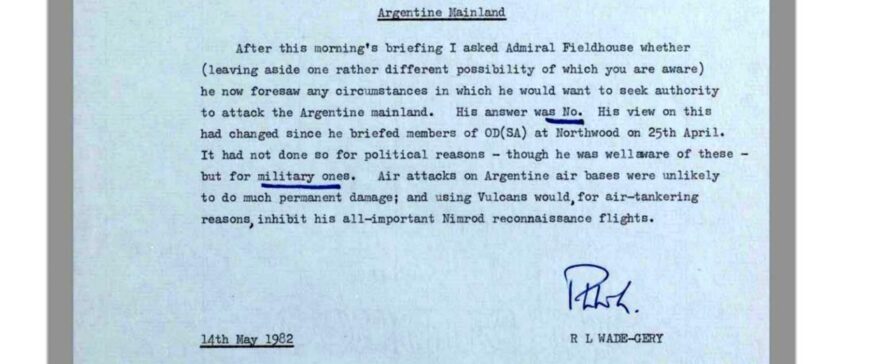
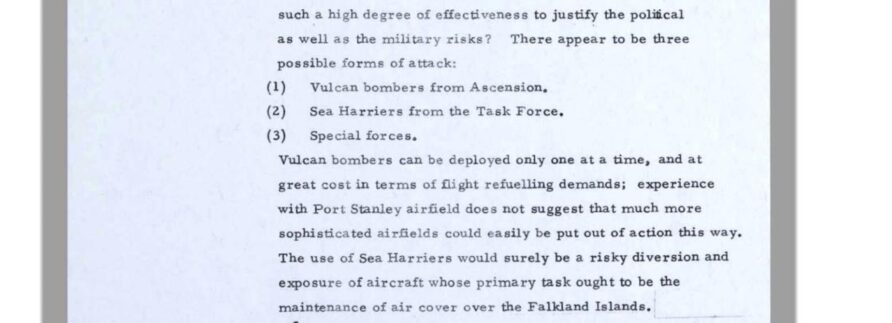
Finally, those priorities were decided by Admiral Fieldhouse, it was his call on the fuel and what it was to be used for.
Were Harriers better suited?
Another criticism is that Sea Harriers and GR.3’s could have done a better job.
Certainly, there was a high degree of confidence in the ability of Sea Harriers in the planning and discussion stages of Black Buck in April.
Experience would show that the Sea Harrier force was not well suited to high altitude bombing, although when used in combination with GR.3’s were effective.
The Sea Harrier had no high altitude bomb aiming sight, which means a low-level approach, exposing precious and valuable air defence aircraft to what was, at the time, a very competent air defence system with radars, guns, and missiles.
The GR.3 was also not well suited to high altitude bombing, lacking a toss bombing system.
Morale
A claim made by proponents of the raids is that they had a disproportionate impact upon Argentine forces morale, this being deliberate and one of the reasons for the mission, not a post event justification.
Some of the more strident, claim that morale was ‘shattered’
When we discuss Argentine forces, we have to be clear what this means, is it the 25th Infantry Regiment and FAA Security Company guarding the airport, forces in the Port Stanley area, or the entirety of the garrison.
It is easy to imagine that morale did suffer, there is nowhere to hide from a thousand-pound bomb dropped from high altitude, but did this lead to collapse locally or in a wider context?
It would seem unlikely.
Argentine forces did suffer morale issues, but only some of them. Others remained effective right to the end, with no major morale issues with many of them. Of course, they were beaten, but I can’t find any accounts that link Black Buck to that defeat.
There were many turning points, Goose Green, Pebble Island, South Georgia, the San Carlos landings, the General Belgrano, HMS Sheffield and the final battles in the high ground around Port Stanley.
It was also reported that the simple fact that the islanders did not welcome the Argentine forces with open arms came as a big shock to many.
The reputation of the Marines, Paras, Guards and Gurkhas also played its part.
Naval gunfire, another significant factor, a good account of the impact of naval gunfire here
Observation 10…
It is only an opinion but I think the Vulcan strikes did have an impact on morale, possibly a serious one, but it was most likely localised and ultimately, one small part of the overall picture.
Summary
A short one…
First; we missed a golden opportunity to completely change the character of the conflict by failing to adequately deny the runway shortly before the invasion.
This would not have been difficult to do, requiring only the bare minimum of defence stores.
Second; professional advice from the Royal Engineers and the civilian organisation that built it regarding the suitability of Stanley Airport for fast jet operations was completely discounted by the intelligence process.
Third, inter-service rivalry raised its ugly head, but to single out the RAF is unfair, all three services (of both nations) indulged in this most corrosive of activities that resulted in adverse outcomes.
Despite this, however unlikely the ability of Argentine forces to exploit Stanley Airport for fast jet operations, the potential impact if they did manage could have been decisive.
Hence, on the balance of risk, we were right to mount the operations.
The crews and support personnel planned and executed the missions with bravery, adaptability and skill.
Since then, their effects have both been exaggerated and belittled, contributing to an unhealthy environment between the Royal Navy and Royal Air Force.
The truth, at least in my opinion, is that the actual utility of the Black Buck missions lies somewhere in-between the extremes of opinion.
They contributed to the overall JOINT effort to defeat Argentine forces and liberate the islanders, like everything else that went south in 1982.
The message to the Junta was clear, time for negotiation had passed and it was about to have its back doors smashed (to coin a phrase!)
I will leave the final word to an islander, Tony Chater
The whole house shook, as though there had been an earthquake. There was terrific jubilation. From then on, we felt confident the British forces would come to our rescue
I think that says it all.
And of course, an amusing tale about those bags of cement that went south to repair

Acknowledgements and Sources
http://falklandstimeline.wordpress.com/
http://www.margaretthatcher.org/
RAF Historical Society, Journal No 30
Air War in the Falklands, 1982
The Official History of the Falklands Campaign, Sir Lawrence Freedman
US Department of the Navy, Falkland Islands Lessons Learned
Falklands Aftermath: Picking up the Pieces, Edward Fursdon
Air Scene UK
Vulcan to the Sky
Argentina’s Tactical Aircraft Employment in the Falkland Islands War, Gabriel Green USAF
The Falklands War Understanding the Power of Context in Shaping Argentine Strategic Decisions
Tony Brown at AGB Drilling
Radar Malvinas (a great site with lots of information)
Zona Militar (an Argentine military forum that is serious about historical analysis, not at all jingoistic and a fantastic resource, including many posts where veterans from both sides discuss the conflict. There are many excellent contributors and I would like to say thank you to a number of selected forum members whose comments helped me a great deal in researching some of the specific points in this series of articles). I really cannot thank them enough.
PPRUNE, Fighter Control and Military Photos discussion forums, as with Zona Militar, are an invaluable reference for anyone interested in the subject.
THE ‘MOST DARING RAID’? THE ROYAL AIR FORCE, OPERATION BLACK BUCK AND THE FALKLANDS CONFLICT, 1982
Images; many of the images in these posts seem to float around the internet on forums and image sharing sites so it is difficult to properly attribute. I am normally quite picky about image grabbing from sources where ownership is uncertain but because I think this is a pretty important subject I have lowered the normal threshold. Please accept my thanks in advance to the photographers and if you are the original owner please let me know if you want it removed or properly attributed.
Falklands War doctor recalls ship’s missile attack

Change Status
| Change Date | Change Record |
| 08/03/2017 | Initial issue |
| 02/03/2018 | Additional Port Stanley imagery |
| 11/09/2020 | Minor updates and spelling error corrections |
| 21/07/2021 | Split from larger Black Buck article and reformat |
| 06/05/2024 | Complete refresh and merge |
Discover more from Think Defence
Subscribe to get the latest posts sent to your email.


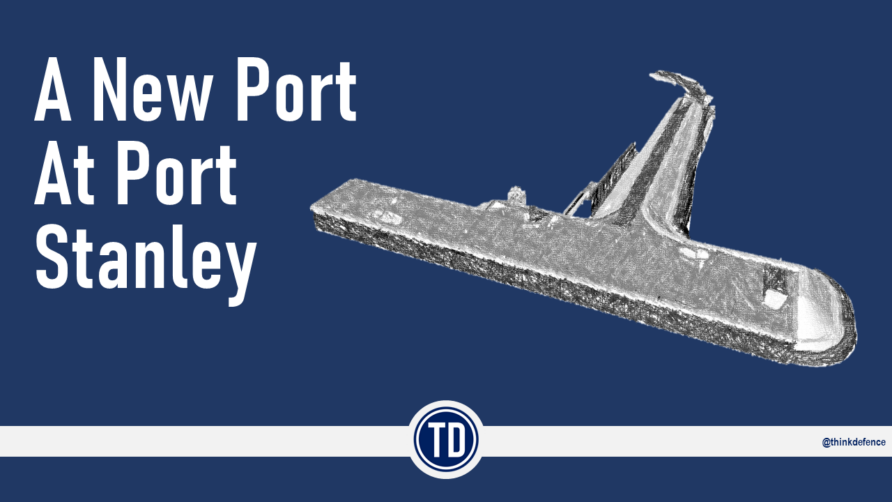
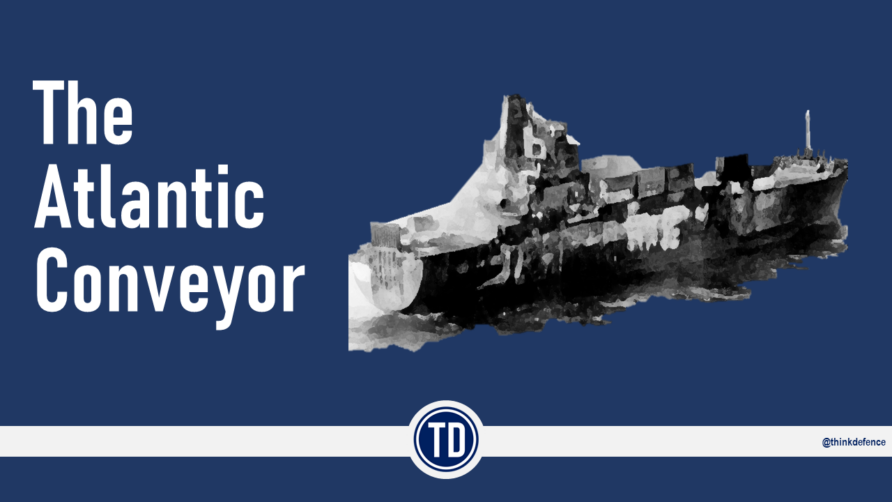
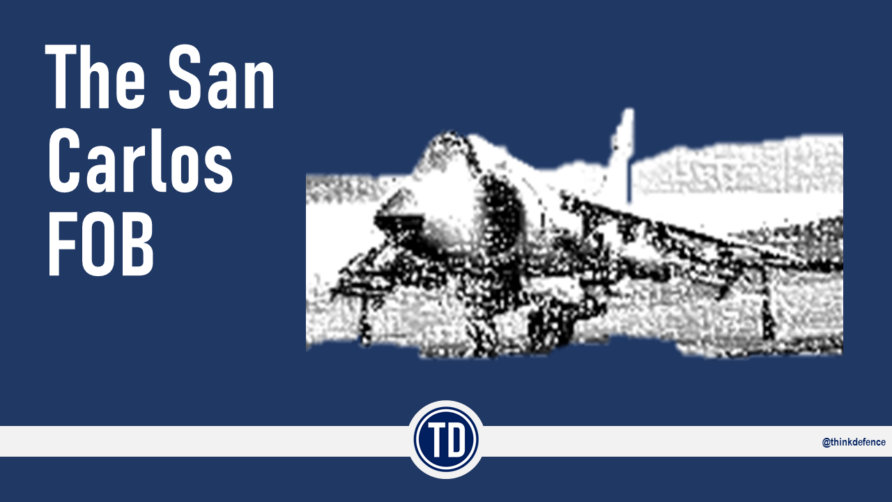
The few dropped a few.
After reading Sharkey Wards excellent if somewhat controversial book ” Sea Harrier over the Falklands” I reached the conclusion these raids were a massive waste of money. It is estimated over 400,000 gallons of fuel were consumed on the 3 raids . 63 bombs dropped, 21 of which were not armed ! one hit on the edge of the runway. Argentine C130’s flew into Stanley almost to the last day of the conflict.
Blowing a hole in the middle of the Port Stanley runway temporarily crippled the AAF and related forces; once this was done the small British aircraft carriers were able to move into range and destroy the Argentine airbase facilities on the island, dooming the garrison.
" The Sea Harrier had no high altitude bomb aiming sight, which means a low-level approach, exposing precious and valuable air defence aircraft to what was at the time, a very competent air defence system with radars, guns and missiles. The GR.3 was also not well suited to high altitude bombing, lacking a toss bombing system."
Sharkey Wards's book claims the sea harrier would have been capable of hight medium? level bombing. (ie bombing from above the Roland missile system engagement zone)
Also you say here the GR3 was not well suited to high altitude bombing because it lacked a toss bombing system ?? The sea harriers on their first airfield strike used the toss bombing method . That is recorded in various accounts. I dont know for sure but would be surprised if the GR3 could not toss bomb also.
An excellent, well-researched and informative article. Thank you.
TD, very many thanks for this most illuminating update to this story. It really was a fascinating read.
As a former Air Force navigator I loved reading Vulcan 607. What puzzled me though is why the excessive Vulcan fuel usage with 21 x 1000lb bombs which so hazarded Black Buck 1, was not recorded on the positioning flight down from Waddington to Ascencion. I agree the positioning flight was only half the distance from Ascencion to Stanley and return but it would have revealed the greater fuel usage at the weights well beyond the fuel graphs available for planning Black Buck 1.
A most interesting article giving insight into matters ignored or glossed over in other articles/books. A great effort!